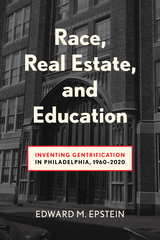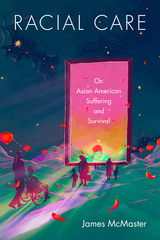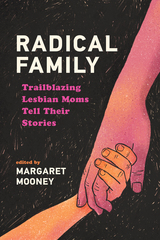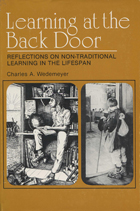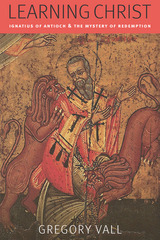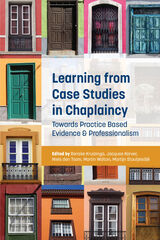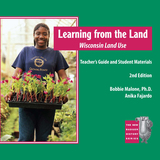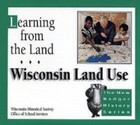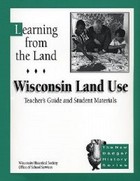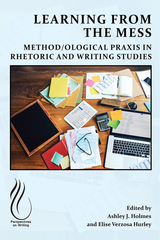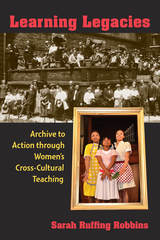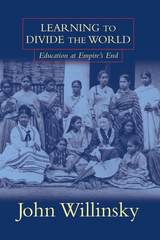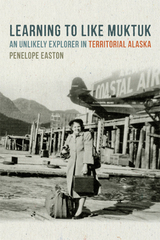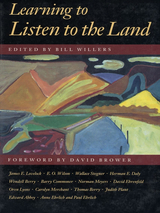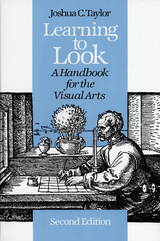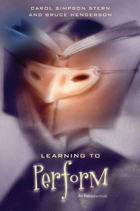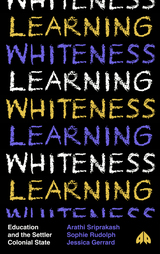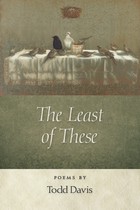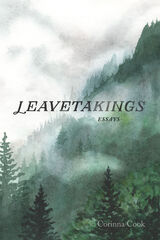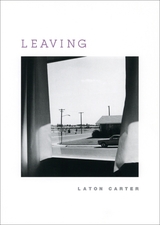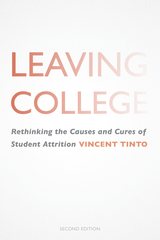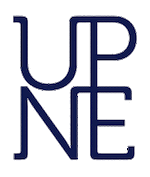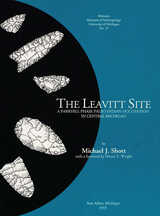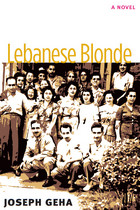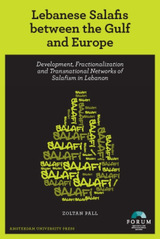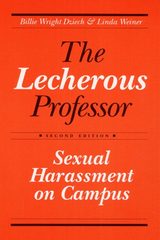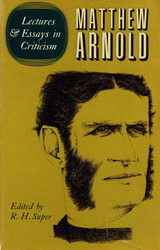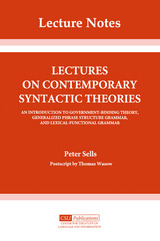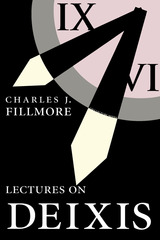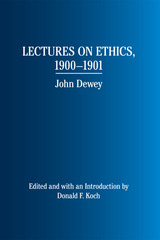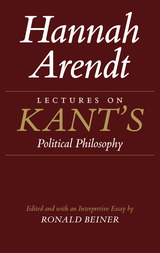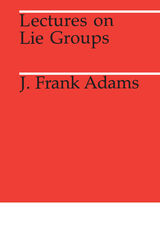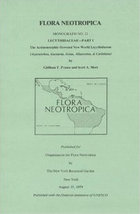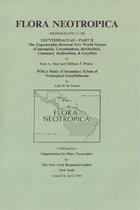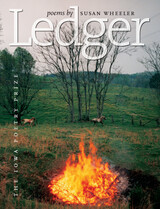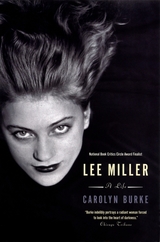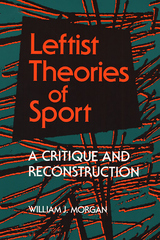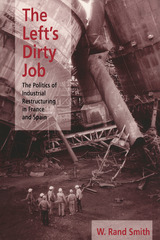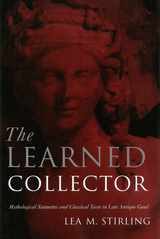 The Learned Collector: Mythological Statuettes and Classical Taste in Late Antique Gaul
Lea M. Stirling
University of Michigan Press, 2005 Inspired by a classical education, wealthy Romans populated the glittering interiors of their villas and homes with marble statuettes of ancestors, emperors, gods, and mythological figures. In The Learned Collector, Lea M. Stirling shows how the literary education received by all aristocrats, pagan and Christian alike, was fundamental in shaping their artistic taste while demonstrating how that taste was considered an important marker of status. Surveying collections across the empire, Stirling examines different ways that sculptural collections expressed not only the wealth but the identity of their aristocratic owners.
The majority of statues in late antique homes were heirlooms and antiques. Mythological statuary, which would be interpreted in varying degrees of complexity, favored themes reflecting aristocratic pastimes such as dining and hunting. The Learned Collector investigates the manufacture of these distinctive statuettes in the later fourth century, the reasons for their popularity, and their modes of display in Gaul and the empire.
Although the destruction of ancient artwork looms large in the common view of late antiquity, statuary of mythological figures continued to be displayed and manufactured into the early fifth century. Stirling surveys the sculptural decor of late antique villas across the empire to reveal the universal and regional trends in the late antique confluence of literary education, mythological references, aristocratic mores, and classicizing taste. Deftly combining art historical, archaeological, and literary evidence, this book will be important to classicists and art historians alike. Stirling's accessible writing style makes this an important work for scholars, students, and anyone with an interest in Roman statues of this era. Lea M. Stirling is Associate Professor of Classics at the University of Manitoba and holds a Canada Research Council Chair in Roman Archaeology. She co-directs excavations at the ancient city of Leptiminus, Tunisia.
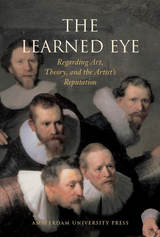 The Learned Eye: Regarding Art, Theory, and the Artist's Reputation
Edited by Marieke van den Doel, Natasja van Eck, Gerbrand Korevaar, Anna Tummers
Amsterdam University Press, 2005 Artists of the seventeenth century were known not just for their skill with a brush and canvas, but also for their knowledge of history, poetry, and literature—what was referred to as an oculuseruditus or "learned eye." Rembrandt, for example, was known during his lifetime for mixing his own colors and for his seemingly "rough" and unique manner of texturing his works. He was not simply an artist; he was a teacher and a salesman too—his etchings were hugely popular with his contemporaries.
Rembrandt's "learned eye," his understanding of both the methods and the reality of being an artist, is also visible in the work and lives of other masters like Anthony van Dyck, Frans Hals, and Nicholas Poussin. Contributors to The Learned Eye examine their visions, as well as those of other, more modern artists, all dedicated to the interdisciplinary fields of art, art history, curation, and restoration. Dedicated to the leader of the Rembrandt Research Project, Ernst van de Wetering, The Learned Eye is a superb overview of the artist at work and an exquisite argument for creative and expansive art scholarship.
Learned Hand: The Man and the Judge
Gerald Gunther
Harvard University Press A powerfully moving account of the life of one of the great judges of the twentieth century, whose work has left a profound mark on our legal, intellectual, and social landscape. The greatest judge never to be appointed to the Supreme Court, he is widely considered to be the peer of Justices Holmes, Brandeis, and Cardozo.
 Learned Lady: Letters from Robert Browning to Mrs. Thomas Fitzgerald, 1876–1889
Robert Browning
Harvard University Press In reproducing sixty-six letters in the Carl H. Pforzheimer Library, plus eight letters orportions of letters previously published, thisbook offers one of the best sources availablefor the last fourteen years of Browning'slife.
Written to a dear friend who was also a"learned lady," the letters deal with Browning's poetry, his social life, and his friendships. They also give some of his views onthe nature of poetry, of art, and of religion.The editor's introduction offers the readera view of Mrs. Fitzgerald and her family,of the social background with which manyof the letters are concerned, and of Browning, his sister, and his son.
Notes clarify the many allusions that appear in the letters. An appendix by MarcelleThiébaux includes careful bibliographicaldescriptions of the manuscripts and a classified list of the writing paper Browning used, information which should enable future editors to assign at least approximate dates tosome of the letters Browning himself leftundated.
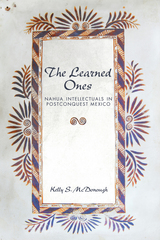 The Learned Ones: Nahua Intellectuals in Postconquest Mexico
Kelly S. McDonough
University of Arizona Press, 2014 They were the healers, teachers, and writers, the “wise ones” of Nahuatl-speaking cultures in Mexico, remembered in painted codices and early colonial manuscripts of Mesoamerica as the guardians of knowledge. Yet they very often seem bound to an unrecoverable past, as stereotypes prevent some from linking the words “indigenous” and “intellectual” together.
Not so, according to author Kelly S. McDonough, at least not for native speakers of Nahuatl, one of the most widely spoken and best-documented indigenous languages of the Americas. This book focuses on how Nahuas have been deeply engaged with the written word ever since the introduction of the Roman alphabet in the early sixteenth century. Dipping into distinct time periods of the past five hundred years, this broad perspective allows McDonough to show the heterogeneity of Nahua knowledge and writing as Nahuas took up the pen as agents of their own discourses and agendas.
McDonough worked collaboratively with contemporary Nahua researchers and students, reconnecting the theorization of a population with the population itself. The Learned Ones describes the experience of reading historic text with native speakers today, some encountering Nahua intellectuals and their writing for the very first time. It intertwines the written word with oral traditions and embodied knowledge, aiming to retie the strand of alphabetic writing to the dynamic trajectory of Nahua intellectual work.
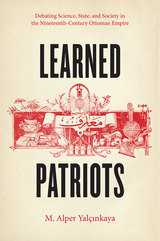 Learned Patriots: Debating Science, State, and Society in the Nineteenth-Century Ottoman Empire
M. Alper Yalçinkaya
University of Chicago Press, 2015 The nineteenth century was, for many societies, a period of coming to grips with the growing, and seemingly unstoppable, domination of the world by the “Great Powers” of Europe. The Ottoman Empire was no exception: Ottomans from all walks of life—elite and non-elite, Muslim and non-Muslim—debated the reasons for what they considered to be the Ottoman decline and European ascendance. One of the most popular explanations was deceptively simple: science. If the Ottomans would adopt the new sciences of the Europeans, it was frequently argued, the glory days of the empire could be revived.
In Learned Patriots, M. Alper Yalçinkaya examines what it meant for nineteenth-century Ottoman elites themselves to have a debate about science. Yalçinkaya finds that for anxious nineteenth-century Ottoman politicians, intellectuals, and litterateurs, the chief question was not about the meaning, merits, or dangers of science. Rather, what mattered were the qualities of the new “men of science.” Would young, ambitious men with scientific education be loyal to the state? Were they “proper” members of the community? Science, Yalçinkaya shows, became a topic that could hardly be discussed without reference to identity and morality.
Approaching science in culture, Learned Patriots contributes to the growing literature on how science travels, representations and public perception of science, science and religion, and science and morality. Additionally, it will appeal to students of the intellectual history of the Middle East and Turkish politics.
 Learner-Centered Pedagogy: Principles and Practice
Kevin Michael Klipfel
American Library Association, 2017 Today's emphasis on metrics and personalization make evidence-based instruction an imperative. In this practice-based handbook, the authors draw on the research of the humanistic psychologist and educator Carl Rogers to present an empathetic approach to information literacy sessions, reference service, and outreach. With an eye on everyday library work, they offer concrete, empirically-based strategies to connect with learners at all levels. Offering plentiful examples of pedagogy in action, this book covers: - 6 cognitive principles for organizing information literacy instruction, with sample worksheets and organization tools for instruction planning;
- how to establish rapport and kindle learners' motivation;
- tactics for transcending "cite 5 sources" and other uninspiring research assignments;
- educational evidence debunking the mythical perception that because students are skilled at computers and mobile technology, they already know how to do research;
- questions to keep in mind for inspiring autonomous learning;
- the power of story, as described by Joan Didion, Brené Brown's Ted Talk, and educational psychology research;
- the science behind information overload; and
- a balanced framework for evaluating specific educational technology tools.
Fusing theory with practice, this handbook is a valuable resource to help every practitioner connect with learners more effectively.
 A Learner's Dictionary of Kazakh Idioms
Akmaral Mukan
Georgetown University Press, 2012 Kazakh, a Turkic language that uses Cyrillic script, is the official state language of Kazakhstan and is also spoken by people in parts of China, Russia, and neighboring Central Asian countries. This unique learner’s dictionary features simple definitions, literal translations, English equivalents, full example sentences, and grammar and usage for over 2,000 Kazakh idioms. As students progress to the upper-intermediate and advanced levels of language learning, they come in contact with cultural concepts embedded in simple words that they have learned as part of everyday vocabulary. Thus, they expand their vocabulary into idiomatic expressions. Upper-intermediate and advanced learners of Kazakh will find this extensive reference work useful to understand those culturally bound idioms. Idioms in this reference volume are organized into categories—the human body, food, clothing, color, number, animals, and nature—that best represent the topics on which language learners focus at the beginning and intermediate levels of language study. Five indexes make finding the idiom you want—by idiom, keyword, or expression in both Kazakh and English—easier.
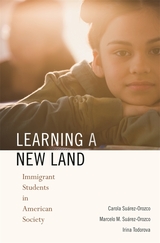 Learning a New Land: Immigrant Students in American Society
Carola Suárez-Orozco, Marcelo M. Suárez-Orozco, and Irina Todorova
Harvard University Press, 2010 One child in five in America is the child of immigrants, and their numbers increase each year. Very few will return to the country they barely remember. Who are they, and what America do they know?
Based on an extraordinary interdisciplinary study that followed 400 newly arrived children from the Caribbean, China, Central America, and Mexico for five years, this book provides a compelling account of the lives, dreams, and frustrations of these youngest immigrants. Richly told portraits of high and low achievers are packed with unexpected ironies. When they arrive, most children are full of optimism and a respect for education. But poor neighborhoods and dull--often dangerous--schools can corrode hopes. The vast majority learn English--but it is the English of video games and the neighborhood, not that of standardized tests.
For some of these children, those heading off to college, America promises to be a land of dreams. These lucky ones have often benefited from caring mentors, supportive teachers, or savvy parents. For others, the first five years are marked by disappointments, frustrations, and disenchantment. How can we explain their varied academic journeys?
The children of immigrants, here to stay, are the future--and how they adapt will determine the nature of America in the twenty-first century.
 Learning a New Land: Immigrant Students in American Society
Carola Suárez-Orozco, Marcelo M. Suárez-Orozco, and Irina Todorova
Harvard University Press One child in five in America is the child of immigrants, and their numbers increase each year. Very few will return to the country they barely remember. Who are they, and what America do they know?
Based on an extraordinary interdisciplinary study that followed 400 newly arrived children from the Caribbean, China, Central America, and Mexico for five years, this book provides a compelling account of the lives, dreams, and frustrations of these youngest immigrants. Richly told portraits of high and low achievers are packed with unexpected ironies. When they arrive, most children are full of optimism and a respect for education. But poor neighborhoods and dull--often dangerous--schools can corrode hopes. The vast majority learn English--but it is the English of video games and the neighborhood, not that of standardized tests.
For some of these children, those heading off to college, America promises to be a land of dreams. These lucky ones have often benefited from caring mentors, supportive teachers, or savvy parents. For others, the first five years are marked by disappointments, frustrations, and disenchantment. How can we explain their varied academic journeys?
The children of immigrants, here to stay, are the future--and how they adapt will determine the nature of America in the twenty-first century.
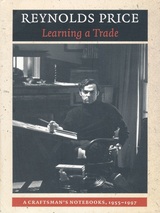 Learning a Trade: A Craftsman's Notebooks: 1955-1997
Reynolds Price
Duke University Press, 1998 From Reynolds Price, much acclaimed author of award-winning novels, plays, poems, stories, and essays, comes a work that is unique among contemporary writers of American literature. For more than forty years, Price has kept a working journal of his writing life. Now published for the first time, Learning a Trade provides a revealing window into this writer’s creative process and craftsman’s sensibilities. Whether Price is reflecting on the rhythm of his day-to-day writing process or ruminating about the central character in what would become, for instance, Kate Vaiden—should she be a woman, what would be her name, why would the story be told in the first person?—he envelops the reader in the task at hand, in the trade being practiced. Instead of personal memoir or a collection of literary fragments, Learning a Trade presents what Price has called the “ongoing minutes” of his effort to learn his craft. Equally enlightening as an overview of a career of developing prominence or as a perspective on the building of individual literary works, this volume not only allows the reader to hear the author’s internal dialogue on the hundreds of questions that must be turned and mulled during the planning and writing of a novel but, in an unplanned way, creates its own compelling narrative. These notebooks begin in “that distant summer in dazed Eisenhower America,” a month after Price’s graduation from Duke University, and conclude in “the raucous millennial present” with plans for his most recent novel, Roxanna Slade. Revealing the genesis and resolution of such works as The Surface of Earth, The Source of Light, Kate Vaiden, Clear Pictures, and Blue Calhoun, Learning a Trade offers a rich reward to those seeking to enter the guild of writers, as well as those intrigued by the process of the literary life or captured by the work of Reynolds Price.
 Learning about Risk: Consumer and Worker Responses to Hazard Information
W. Kip Viscusi and Wesley A. Magat
Harvard University Press, 1987 How do people decide whether or not to take chances with their health and safety? Do they pay attention to warnings about hazardous products used at home or on the job? What is the best way to present this information? These questions are becoming increasingly important as direct government regulation is replaced by programs to educate workers and consumers about risk. Information itself is becoming a regulatory device, but until now little has been known about its use and effectiveness.
Learning about Risk offers important new evidence on how people process information about risk and how they make choices under uncertainty. Drawing on work in a variety of disciplines—economics, decision science, marketing, and psychology—as well as on extensive original survey data, the authors take a close look at one type of risk information: the labeling of hazardous products and chemicals. They use the word labeling to mean all the tangible ways in which information is transmitted, including not merely warnings on bottles and cans but also leaflets and brochures, signs in the workplace, and store displays. The authors surveyed hundreds of consumers and chemical workers to explore a range of issues—the accuracy and appropriateness of people's risk assessments, the types of precautions they take, the values they attach to these measures, the wages they expect for performing risky jobs, and the relationship between the precaution taken and the content, wording, and format of the warning.
Overall, the authors show that information policies are a promising approach to controlling risks in the marketplace and on the job. Their findings will be of interest to government officials, policy analysts, economists, psychologists, and managers concerned professionally with the labeling of hazardous products.
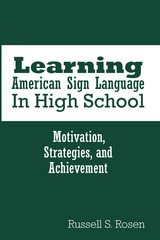 Learning American Sign Language in High School: Motivation, Strategies, and Achievement
Russell S. Rosen
Gallaudet University Press, 2015 Reflecting the exponential growth of college courses offering American Sign Language (ASL) as a foreign language, high schools have followed suit with significant increases in ASL classes during the past two decades. Despite this trend, high school ASL teachers and program administrators possess no concrete information on why students take ASL for foreign language credit, how they learn new signs and grammar, and how different learning techniques determines their achievement in ASL. This new book addresses these issues to better prepare high schools in their recruitment and education of new ASL students.
Author Russell S. Rosen begins with the history of ASL as a foreign language in high schools, including debates about the foreign language status of ASL, the situation of deaf and hard of hearing students in classes, and governmental recognition of ASL as a language. Based on his study of five high school ASL programs, he defines the factors that motivate students, including community and culture, and analyzes strategies for promoting language processing and learning. Learning American Sign Language in High School provides strategies for teaching ASL as a second language to students with learning disabilities as well. Its thorough approach ensures the best opportunity for high school students to attain high levels of achievement in learning ASL.
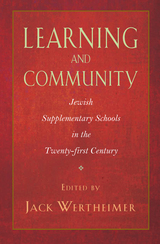 Learning and Community: Jewish Supplementary Schools in the Twenty-First Century
Jack Wertheimer
Brandeis University Press, 2009 At a time of heightened interest in Jewish supplementary schooling, this volume offers a path-breaking examination of how ten diverse schools have remade themselves to face the new challenges of the twenty-first century. Each written by an academic observer with the help of an experienced educator, the chapters bring these schools vividly to life by giving voice to students, parents, teachers, school directors, lay leaders, local rabbis and other key participants. The goal of the book is to uncover the building blocks each school put into place to improve its delivery of a Jewish education. Employing qualitative research, Learning and Community is filled with moving and inspiring human-interest stories. Collectively, these portraits offer models of how schools of different sizes and configurations can maximize their impact, and in the process revitalize the form of religious and cultural education that engages the majority of Jewish children in the United States.
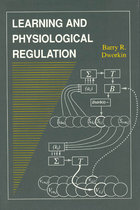 Learning and Physiological Regulation
Barry R. Dworkin
University of Chicago Press, 1993 Since Pavlov, physiologists have explained homeostasis—the regulation of bodily functions—as the action of fixed negative feedback networks within individual organ systems. However, these standard explanations largely ignore the mechanisms of conditioning and learning. Drawing on the work of Western, East European, and Russian physiologists, Barry R. Dworkin challenges traditional concepts and argues that learning mechanisms of the nervous system are essential to regulation. Dworkin shows how, through experience, learning mechanisms determine dynamic stability and the long-term regulation of heart rate, blood pressure, glucose, electrolytes, and temperature. He argues that "hard wired" mechanisms do not adequately account for the speed and accuracy of physiological adjustments, and supports his contention with detailed analyses and mathematical models of how conditioned and unconditioned reflexes interact. Dworkin reviews a wealth of research on interoceptive conditioning, conditioned drug responses, and visceral adjustment. Combining physiological and behavioral data with mathematical analysis and computer models, he synthesizes the work of Pavlov and W. B. Cannon in a quantitative theory of physiological regulation that will interest researchers and theorists in medicine, physiology, neuroscience, and biopsychology.
Learning at the Back Door: Reflections on Non-Traditional Learning in the Lifespan
Charles A. Wedemeyer
University of Wisconsin Press, 1981 Is learning a natural ability that schools, colleges, and universities gradually stifle in individuals, replacing it with a learning dependency? Charles A. Wedemeyer stressed that learning is a natural, idiosyncratic, and continually renewable human trait and survival resource. It is not dependent upon teaching, schooling, or special environments, although—properly used—these resources enhance learning. Learning at the Back Door examines this kind of learning and relates it to schooling, suggesting ways in which all learning—whether traditional or non-traditional—can be encouraged and improved through new kinds of educational institutions and processes.
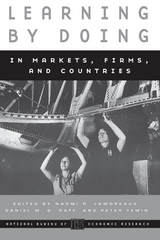 Learning by Doing in Markets, Firms, and Countries
Edited by Naomi R. Lamoreaux, Daniel M. G. Raff, and Peter Temin
University of Chicago Press, 1998 Learning by Doing in Markets, Firms, and Countries draws out the underlying economics in business history by focusing on learning processes and the development of competitively valuable asymmetries. The essays show that organizations, like people, learn that this process can be organized more or less effectively, which can have major implications for how competition works.
The first three essays in this volume explore techniques firms have used to both manage information to create valuable asymmetries and to otherwise suppress unwelcome competition. The next three focus on the ways in which firms have built special capabilities over time, capabilities that have been both sources of competitive advantage and resistance to new opportunities. The last two extend the notion of learning from the level of firms to that of nations. The collection as a whole builds on the previous two volumes to make the connection between information structure and product market outcomes in business history.
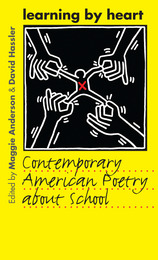 Learning by Heart: Contemporary American Poetry about School
Maggie Anderson
University of Iowa Press, 1999 Learning by Heart brings together a unique and diverse collection of poems about the experience of school as seen through the eyes of America's best contemporary poets. These poets capture the educational process not only in the classroom but as it takes place in libraries and hallways, on playing fields and at dances. Alternately joyous and defiant, they demonstrate how it is that young people come to find their place in the world. Most of the poems in this anthology were written between 1970 and 1995, a period that encompasses both the halcyon years of poets-in-the-schools programs and the primary and secondary school years of many of the poets included. Their poems define school in that most contemporary sense — “with a multitude of voices”—reflecting perspectives from African American, Hispanic American, Asian American, and Native American as well as Anglo American backgrounds, from both public and private schools in rural and urban environments. Learning by Heart offers a profound and timely statement about schools and learning as well as the role of art in education. Finally, these poems validate that most important lesson: even the most common of experiences is worthy of creative expression.
 Learning by Voting: Sequential Choices in Presidential Primaries and Other Elections
Rebecca B. Morton and Kenneth C. Williams
University of Michigan Press, 2001 The presidential primary season used to be a long sequence of elections. In recent years many states have moved their presidential primaries earlier in the year in the belief that this increases their influence over the choice of presidential nominees. Similarly, in the past most voters have gone to a polling place and voted on election day. Now an increasing number of voters are not voting on election day but are using mail-in or absentee ballots to vote, often weeks before other voters.
Does the movement to a large number of early presidential primaries reduce the ability of voters to learn about the candidates? Do voters who vote early miss important information by not following the entire campaign, or are they, as some argue, more partisan? In a unique study Rebecca B. Morton and Kenneth C. Williams investigate the impact these changes have on the choices voters make. The authors combine a formal, theoretical model to derive hypotheses with experiments, elections conducted in labs, to test the hypotheses.
Their analysis finds that sequence in voting does matter. In simultaneous voting elections well-known candidates are more likely to win, even if that candidate is the first preference of only a minority of the voters and would be defeated by another candidate, if that candidate were better known. These results support the concerns of policy makers that front-loaded primaries prevent voters from learning during the primary process. The authors also find evidence that in sequential elections those who vote on election day have the benefit of information received throughout the whole course of the campaign, thus supporting concerns with mail-in ballots and other early balloting procedures.
This book will interest scholars interested in elections, the design of electoral systems, and voting behavior as well as the use of formal modeling and experiments in the study of politics. It is written in a manner that can be easily read by those in the public concerned with presidential elections and voting.
Rebecca B. Morton is Associate Professor of Political Science, University of Iowa. Kenneth C. Williams is Associate Professor of Political Science, Michigan State University.
Learning Centers for School Libraries
Maura Madigan
American Library Association, 2021 This book offers - Step-by-step directions for both the educator and learner and all necessary handouts, including directions and worksheets. The reader can use the book to quickly and easily set up centers. Some centers require only photocopies and basic materials to get started.
- Guidance on how to create cross-curricular centers that target the AASL Standards and other content-area standards. A table is provided to enable educators to create centers that address specific standards or content areas. Centers for distance learning are also identified.
- Suggested modifications for both struggling and advanced learners, plus ideas for collaborating with other educators. These features broaden the potential audience beyond elementary school learners.
Learning Christ
Gregory Vall
Catholic University of America Press, 2013 Learning Christ represents a thorough reevaluation of Ignatius as author and theologian, demonstrating that his seven authentic letters present a sophisticated and cohesive vision of the economy of redemption. Gregory Vall argues that Ignatiuss thought represents a vital synthesis of Pauline, Johannine, and Matthean perspectives while anticipating important elements of later patristic theology. Topics treated in this volume include Ignatiuss soteriological anthropology, his Christology and nascent Trinitarianism, his nuanced understanding of the relationship between Judaism and Christianity, and his ecclesiology and eschatology.
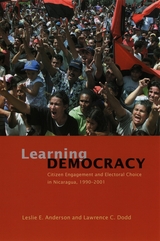 Learning Democracy: Citizen Engagement and Electoral Choice in Nicaragua, 1990-2001
Leslie E. Anderson and Lawrence C. Dodd
University of Chicago Press, 2005 Historically, Nicaragua has been mired in poverty and political conflict, yet the country has become a model for the successful emergence of democracy in a developing nation. Learning Democracy tells the story of how Nicaragua overcame an authoritarian government and American interventionism by engaging in an electoral revolution that solidified its democratic self-governance.
By analyzing nationwide surveys conducted during the 1990, 1996, and 2001 Nicaraguan presidential elections, Leslie E. Anderson and Lawrence C. Dodd provide insight into one of the most unexpected and intriguing recent advancements in third world politics. They offer a balanced account of the voting patterns and forward-thinking decisions that led Nicaraguans to first support the reformist Sandinista revolutionaries only to replace them with a conservative democratic regime a few years later. Addressing issues largely unexamined in Latin American studies, Learning Democracy is a unique and probing look at how the country's mass electorate moved beyond revolutionary struggle to establish a more stable democratic government by realizing the vital role of citizens in democratization processes.
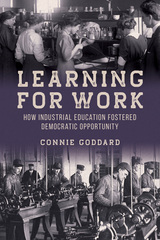 Learning for Work: How Industrial Education Fostered Democratic Opportunity
Connie Goddard
University of Illinois Press, 2024 Founded in 1883, the Chicago Manual Training School (CMTS) was a short-lived but influential institution dedicated to teaching a balanced combination of practical and academic skills. Connie Goddard uses the CMTS as a door into America’s early era of industrial education and the transformative idea of “learning to do.” Rooting her account in John Dewey’s ideas, Goddard moves from early nineteenth century supporters of the union of learning and labor to the interconnected histories of CMTS, New Jersey’s Manual Training and Industrial School for Colored Youth, North Dakota’s Normal and Industrial School, and related programs elsewhere. Goddard analyzes the work of movement figures like abolitionist Theodore Weld, educators Calvin Woodward and Booker T. Washington, social critic W.E.B. Du Bois, Dewey himself, and his influential Chicago colleague Ella Flagg Young. The book contrasts ideas about manual training held by advocate Nicholas Murray Butler with those of opponent William Torrey Harris and considers overlooked connections between industrial education and the Arts and Crafts Movement. An absorbing merger of history and storytelling, Learning for Work looks at the people who shaped industrial education while offering a provocative vision of realizing its potential today.
 Learning French from Spanish and Spanish from French: A Short Guide
Patricia V. Lunn and Anita Jon Alkhas
Georgetown University Press, 2017 Learning French from Spanish and Spanish from French provides adult English speakers who have learned either Spanish or French as a second language with the tools to learn the other as a third language. Research in the growing fields of third-language acquisition and multilingualism documents how successful language learners intuitively build on their existing knowledge as they learn a new language. In this vein, Learning French from Spanish and Spanish from French takes advantage of the fact that learners with intermediate proficiency in a second language are used to thinking consciously about language, know themselves as language learners, and can capitalize on what they know about one language to understand the other. With chapters conveniently organized by grammatical concept and including supplementary resources such as exercises, parallel reading texts, and audio files, this book will benefit students, travelers, and budding multilinguals alike.
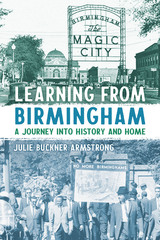 Learning from Birmingham: A Journey into History and Home
Julie Buckner Armstrong
University of Alabama Press, 2023 A steel town daughter’s search for truth and beauty in Birmingham, Alabama
“As Birmingham goes, so goes the nation,” Fred Shuttlesworth observed when he invited Martin Luther King Jr. to the city for the transformative protests of 1963. From the height of the Civil Rights Movement through its long aftermath, images of police dogs, fire hoses and four girls murdered when Ku Klux Klan members bombed the Sixteenth Street Baptist Church have served as an uncomfortable racial mirror for the nation. Like many white people who came of age in the Civil Rights Movement’s wake, Julie Buckner Armstrong knew little about this history. Only after moving away and discovering writers like Toni Morrison and Alice Walker did she realize how her hometown and family were part of a larger, ongoing story of struggle and injustice.
When Armstrong returned to Birmingham decades later to care for her aging mother, Shuttlesworth’s admonition rang in her mind. By then an accomplished scholar and civil rights educator, Armstrong found herself pondering the lessons Birmingham holds for a twenty-first century America. Those lessons extended far beyond what a 2014 Teaching Tolerance report describes as the common distillation of the Civil Rights Movement into “two names and four words: Martin Luther King Jr, Rosa Parks, and ‘I have a dream.’” Seeking to better understand a more complex local history, its connection to broader stories of oppression and resistance, and her own place in relation to it, Armstrong embarked on a journey to unravel the standard Birmingham narrative to see what she would find.
Beginning at the center, with her family’s 1947 arrival to a housing project near the color line, within earshot of what would become known as Dynamite Hill, Armstrong works her way over time and across the map. Weaving in stories of her white working-class family, classmates, and others not traditionally associated with Birmingham’s civil rights history, including members of the city’s LGBTQ community, she forges connections between the familiar and lesser-known. The result is a nuanced portrait of Birmingham--as seen in public housing, at old plantations, in segregated neighborhoods, across contested boundary lines, over mountains, along increasingly polluted waterways, beneath airport runways, on highways cutting through town, and under the gaze of the iconic statue of Vulcan.
In her search for truth and beauty in Birmingham, Armstrong draws on the powers of place and storytelling to dig into the cracks, complicating easy narratives of civil rights progress. Among the discoveries she finds in America’s racial mirror is a nation that has failed to recognize itself in the horrific images from Birmingham’s past and to acknowledge the continuing inequalities that make up the Civil Right’s Movement’s unfinished business. Learning from Birmingham reminds us that stories of civil rights, structural oppression, privilege, abuse, race and gender bias, and inequity are difficult and complicated, but their telling, especially from multiple stakeholder perspectives, is absolutely necessary.
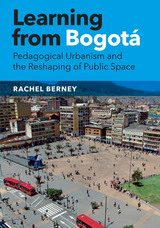 Learning from Bogotá: Pedagogical Urbanism and the Reshaping of Public Space
By Rachel Berney
University of Texas Press, 2017 Once known as a “drug capital” and associated with kidnappings, violence, and excess, Bogotá, Colombia, has undergone a transformation that some have termed “the miracle of Bogotá.” Beginning in the late 1980s, the city emerged from a long period of political and social instability to become an unexpected model of urban development through the redesign and revitalization of the public realm—parks, transportation, and derelict spaces—under the leadership of two “public space mayors,” Antanas Mockus and Enrique Peñalosa (the latter reelected in 2015). In Learning from Bogotá, Rachel Berney analyzes how these mayors worked to reconfigure the troubled city into a pedagogical one whose public spaces and urban policy have helped shape a more tolerant and aware citizenry. Berney examines the contributions of Mockus and Peñalosa through the lenses of both spatial/urban design and the city’s history. She shows how, through the careful intertwining of new public space and transportation projects, the reclamation of privatized public space, and the refurbishment of dilapidated open spaces, the mayors enacted an ambitious urban vision for Bogotá without resorting to the failed method of the top-down city master plan. Illuminating the complex interplay between formal politics, urban planning, and improvised social strategies, as well as the negative consequences that accompanied Bogotá’s metamorphosis, Learning from Bogotá offers significant lessons about the possibility for positive and lasting change in cities around the world.
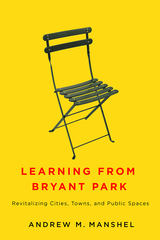 Learning from Bryant Park: Revitalizing Cities, Towns, and Public Spaces
Andrew M. Manshel
Rutgers University Press, 2020 By the 1970s, 42nd Street in New York was widely perceived to be unsafe, a neighborhood thought to be populated largely by drug dealers, porn shops, and muggers. But in 1979, civic leaders developed a long-term vision for revitalizing one especially blighted block, Bryant Park. The reopening of the park in the 1990s helped inject new vitality into midtown Manhattan and served as a model for many other downtown revitalization projects. So what about urban policy can we learn from Bryant Park?
In this new book, Andrew M. Manshel draws from both urbanist theory and his first-hand experiences as a urban public space developer and manager who worked on Bryant Park and later applied its strategies to an equally successful redevelopment project in a very different New York neighborhood: Jamaica, Queens. He candidly describes what does (and doesn’t) work when coordinating urban redevelopment projects, giving special attention to each of the many details that must be carefully observed and balanced, from encouraging economic development to fostering creative communities to delivering appropriate services to the homeless. Learning from Bryant Park is thus essential reading for anyone who cares about giving new energy to downtowns and public spaces.
Learning from Case Studies in Chaplaincy: Towards Practice Based Evidence and Professionalism
Edited by Renske Kruizinga, Jacques Körver, Martin Walton, and Martjin Stoutjesdijk
Eburon Academic Publishers, 2020 The recent body of case-study work on chaplaincy care synthesizes the inherent narrative nature of chaplaincy with the structured rigors of contemporary care research. This volume is composed of contributions from both practitioners and academic researchers, joining reflections on the challenges of case studies in chaplaincy care with specific results. Drawing on reflections on methodology and professionalization in chaplaincy, the volume hopes to contribute to answering the question of how and why chaplaincy works.
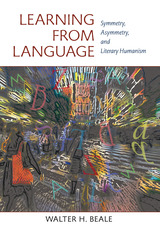 Learning from Language: Symmetry, Asymmetry, and Literary Humanism
Walter H. Beale
University of Pittsburgh Press, 2009
In Learning from Language, Walter H. Beale seeks to bring together the disciplines of linguistics, rhetoric, and literary studies through the concept of symmetry (how words mirror thought, society, and our vision of the world).
Citing thinkers from antiquity to the present, Beale provides an in-depth study of linguistic theory, development, and practice. He views the historic division between the schools of symmetry and asymmetry (a belief that language developed as a structure independent of human experience), as built into the character of language itself, and as an impediment to literary humanism (the combined study of language, rhetoric, and literature to improve the competence and character of the individual).
In his analysis, Beale outlines and critiques traditional claims of symmetry, then offers new avenues of approach to the subject. In doing so, he examines how important issues of human culture and consciousness have parallels in processes of language; how linguistic patterns relate to pervasive human problems; how language is an active participant in the expression, performance, and construction of reality; the concepts of designating versus naming; figurative language as a process of reenvisioning reality; and the linking of style to virtue by the ancients.
Beale concludes that both asymmetrical and symmetrical elements exist in language, each with their own relevance, and that they are complementary, rather than opposing philosophies. The basic intuitions of symmetry that relate language to life are powerful and important to all of English studies. Combined with a love for the workings, sounds, and structures of language, Beale says, an understanding of symmetry can help guide the pursuit of literary humanism.
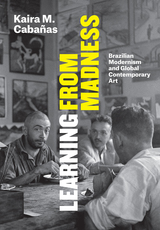 Learning from Madness: Brazilian Modernism and Global Contemporary Art
Kaira M. Cabañas
University of Chicago Press, 2018 Throughout the history of European modernism, philosophers and artists have been fascinated by madness. Something different happened in Brazil, however, with the “art of the insane” that flourished within the modernist movements there. From the 1920s to the 1960s, the direction and creation of art by the mentally ill was actively encouraged by prominent figures in both medicine and art criticism, which led to a much wider appreciation among the curators of major institutions of modern art in Brazil, where pieces are included in important exhibitions and collections.
Kaira M. Cabañas shows that at the center of this advocacy stood such significant proponents as psychiatrists Osório César and Nise da Silveira, who championed treatments that included painting and drawing studios; and the art critic Mário Pedrosa, who penned Gestaltist theses on aesthetic response. Cabañas examines the lasting influence of this unique era of Brazilian modernism, and how the afterlife of this “outsider art” continues to raise important questions. How do we respect the experiences of the mad as their work is viewed through the lens of global art? Why is this art reappearing now that definitions of global contemporary art are being contested?
Learning from Madness offers an invigorating series of case studies that track the parallels between psychiatric patients’ work in Western Europe and its reception by influential artists there, to an analogous but altogether distinct situation in Brazil.
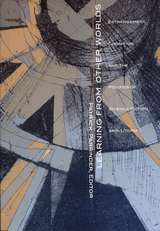 Learning from Other Worlds: Estrangement, Cognition, and the Politics of Science Fiction and Utopia
Patrick Parrinder, ed.
Duke University Press, 2001 Learning from Other Worlds provides both a portrait of the development of science fiction criticism as an intellectual field and a definitive look at the state of science fiction studies today. Its title refers to the essence of “cognitive estrangement” in relation to science fiction and utopian fiction—the assertion that by imagining strange worlds we learn to see our own world in a new perspective. Acknowledging an indebtedness to the groundbreaking work of Darko Suvin and his belief that the double movement of estrangement and cognition reflects deep structures of human storytelling, the contributors assert that learning-from-otherness is as natural and inevitable a process as the instinct for imitation and representation that Aristotle described in his Poetics.
In exploring the relationship between imaginative invention and that of allegory or fable, the essays in Learning from Other Worlds comment on the field’s most abiding concerns and employ a variety of critical approaches—from intellectual history and genre studies to biographical criticism, feminist cultural studies, and political textual analysis. Among the topics discussed are the works of John Wyndham, Kim Stanley Robinson, Stanislau Lem, H.G. Wells, and Ursula Le Guin, as well as the media’s reactions to the 1997 cloning of Dolly the Sheep. Darko Suvin’s characteristically outspoken and penetrating afterword responds to the essays in the volume and offers intimations of a further stage in his long and distinguished career.
This useful compendium and companion offers a coherent view of science fiction studies as it has evolved while paying tribute to the debt it owes Suvin, one of its first champions. As such, it will appeal to critics and students of science fiction, utopia, and fantasy writing.
Contributors. Marc Angenot, Marleen S. Barr, Peter Fitting, Carl Freedman, Edward James, Fredric Jameson, David Ketterer, Gerard Klein, Tom Moylan, Rafail Nudelman, Darko Suvin
Learning From Robben Island: Govan Mbeki’s Prison Writings
Govan Mbeki
Ohio University Press, 1991 In the late fifties and early sixties, Govan Mbeki was a central figure in the African National Congress and director of the ANC campaigns from underground. Born of a chief and the daughter of a Methodist minister in the Transkei of South Africa in 1910, he worked as a teacher, journalist, and tireless labor organizer in a lifetime of protest against the government policy of apartheid. Over two decades of imprisonment on Robben Island did not consign him to obscurity. Along with Nelson Mandela and Walter Sisulu, his name has become a symbol of resistance, not only to the oppressed people of South Africa, but also to the international community who have conferred on him many honors and awards.
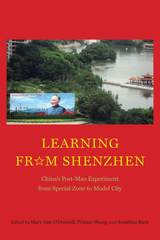 Learning from Shenzhen: China’s Post-Mao Experiment from Special Zone to Model City
Edited by Mary Ann O'Donnell, Winnie Wong, and Jonathan Bach
University of Chicago Press, 2017 This multidisciplinary volume, the first of its kind, presents an account of China’s contemporary transformation via one of its most important yet overlooked cities: Shenzhen, located just north of Hong Kong. In recent decades, Shenzhen has transformed from an experimental site for economic reform into a dominant city at the crossroads of the global economy. The first of China’s special economic zones, Shenzhen is today a UNESCO City of Design and the hub of China’s emerging technology industries.
Bringing China studies into dialogue with urban studies, the contributors explore how the post-Mao Chinese appropriation of capitalist logic led to a dramatic remodeling of the Chinese city and collective life in China today. These essays show how urban villages and informal institutions enabled social transformation through cases of public health, labor, architecture, gender, politics, education, and more. Offering scholars and general readers alike an unprecedented look at one of the world’s most dynamic metropolises, this collective history uses the urban case study to explore critical problems and possibilities relevant for modern-day China and beyond.
Learning from the Land: Wisconsin Land Use
Bobbie Malone
Wisconsin Historical Society Press, 1998 Fourth-grade students and other young readers will learn about interactions of people with natural geographical features of Wisconsin. Emphasizing both historic and new maps, Learning from the Land explores land use from early Indians to the Black Hawk War, looking at mining, logging, farming, and environmental issues.
Learning from the Land: Wisconsin Land Use; 2nd Edition
Bobbie Malone
Wisconsin Historical Society Press, 2011
How has the landscape of Wisconsin affected its history? How have people living here changed that landscape over time? What are the implications for the future? The second edition of Learning from the Land addresses these and other questions, asking elementary and middle school readers to think about land use issues throughout Wisconsin's history. This revised edition includes expanded chapters on logging and the lumber industry, land use and planning, and agriculture in the 20th century from farmers' markets to organic farming. New profiles of Gaylord Nelson, pioneer of Earth Day, and Will Allen, founder of Growing Power in Milwaukee, round out this history of land use in Wisconsin.
Learning from the Land: Wisconsin Land Use, TG
Bobbie Malone
Wisconsin Historical Society Press, 1999 Fourth-grade students and other young readers will learn about interactions of people with natural geographical features of Wisconsin. Emphasizing both historic and new maps, Learning from the Land explores land use from early Indians to the Black Hawk War, looking at mining, logging, farming, and environmental issues.
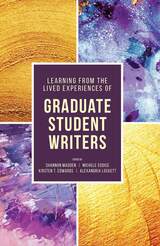 Learning from the Lived Experiences of Graduate Student Writers
Shannon Madden
Utah State University Press, 2020 Learning from the Lived Experiences of Graduate Student Writers is a timely resource for understanding and resolving some of the issues graduate students face, particularly as higher education begins to pay more critical attention to graduate student success. Offering diverse approaches for assisting this demographic, the book bridges the gap between theory and practice through structured examination of graduate students’ narratives about their development as writers, as well as researched approaches for enabling these students to cultivate their craft. The first half of the book showcases the voices of graduate student writers themselves, who describe their experiences with graduate school literacy through various social issues like mentorship, access, writing in communities, and belonging in academic programs. Their narratives illuminate how systemic issues significantly affect graduate students from historically oppressed groups. The second half accompanies these stories with proposed solutions informed by empirical findings that provide evidence for new practices and programming for graduate student writers. Learning from the Lived Experiences of Graduate Student Writers values student experience as an integral part of designing approaches that promote epistemic justice. This text provides a fresh, comprehensive, and essential perspective on graduate writing and communication support that will be useful to administrators and faculty across a range of disciplines and institutional contexts.
Contributors: Noro Andriamanalina, LaKela Atkinson, Daniel V. Bommarito, Elizabeth Brown, Rachael Cayley, Amanda E. Cuellar, Kirsten T. Edwards, Wonderful Faison, Amy Fenstermaker, Jennifer Friend, Beth Godbee, Hope Jackson, Karen Keaton Jackson, Haadi Jafarian, Alexandria Lockett, Shannon Madden, Kendra L. Mitchell, Michelle M. Paquette, Shelley Rodrigo, Julia Romberger, Lisa Russell-Pinson, Jennifer Salvo-Eaton, Richard Sévère, Cecilia D. Shelton, Pamela Strong Simmons, Jasmine Kar Tang, Anna K. Willow Treviño, Maurice Wilson, Anne Zanzucchi
Learning from the Mess: Method/ological Praxis in Rhetoric and Writing Studies
Ashley J. Holmes
University Press of Colorado, 2024 The contributors to Learning from the Mess: Method/ological Praxis in Rhetoric and Writing Studies argue that there’s much to be learned from the messiness of research contexts. In so doing, they highlight the value of revisiting and reflecting on research methods and methodologies with two primary goals in mind: to shed light on the processes commonly elided between research design and publication and to make explicit that the method/ologies we use in our research require praxis. Learning from the Mess features ten chapters that challenge readers to rethink and reflect on their own method/ological choices in the past and to envision new possibilities for future research designs. Each contributor connects their reflections to one or more paired reading(s) they had previously published.
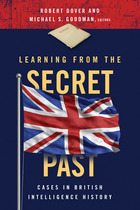 Learning from the Secret Past: Cases in British Intelligence History
Robert Dover and Michael S. Goodman, Editors
Georgetown University Press, 2015 Identifying “lessons learned” is not new—the military has been doing it for decades. However, members of the worldwide intelligence community have been slow to extract wider lessons gathered from the past and apply them to contemporary challenges. Learning from the Secret Past is a collection of ten carefully selected cases from post-World War II British intelligence history. Some of the cases include the Malayan Emergency, the Cuban Missile Crisis, Northern Ireland, and the lead up to the Iraq War. Each case, accompanied by authentic documents, illuminates important lessons that today's intelligence officers and policymakers—in Britain and elsewhere—should heed. Written by former and current intelligence officers, high-ranking government officials, and scholars, the case studies in this book detail intelligence successes and failures, discuss effective structuring of the intelligence community, examine the effective use of intelligence in counterinsurgency, explore the ethical dilemmas and practical gains of interrogation, and highlight the value of human intelligence and the dangers of the politicization of intelligence. The lessons learned from this book stress the value of past experience and point the way toward running effective intelligence agencies in a democratic society. Scholars and professionals worldwide who specialize in intelligence, defense and security studies, and international relations will find this book to be extremely valuable.
 The Learning Household: How to Help Your Child Get More out of School
Ken Bain
Harvard University Press, 2025 An expert guide to raising creative, passionate learners, from the bestselling author of What the Best College Teachers Do.
Children are eager learners. As anyone who has taken a car trip with a toddler will tell you, they have a seemingly endless urge to ask questions about whatever pops into their heads. And yet, many kids end up bored and alienated at school. What can parents do to sustain their natural curiosity?
In The Learning Household, educators Ken Bain and Marsha Marshall Bain argue that parents can do a lot. Too often, however, parents emphasize grades instead of instilling the creativity, grit, and enthusiasm necessary to navigate a rapidly changing world. At its best, school provides opportunities to cultivate innovation and apply knowledge to novel problems. But before children can experience such an education, parents must create “a learning household” in which they encourage children to ask thoughtful questions rather than memorize correct answers, to discover their passions rather than fret about report cards, and to take risks rather than worry about failing.
Providing dozens of activities that can be adapted to meet the needs of every family, The Learning Household is an essential guide to bringing curiosity back to the classroom and fostering an appreciation for the intrinsic value of learning.
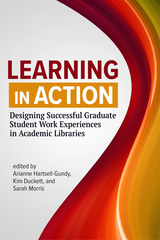 Learning in Action: Designing Successful Graduate Student Work Experiences in Academic Libraries
Arianne Hartsell-Gundy
Association of College & Research Libraries, 2022 How do you supervise a graduate student working in a library—and not just adequately, but well? What is a valuable and meaningful work experience? How can libraries design more equitable and ethical positions for students? Learning in Action: Designing Successful Graduate Student Work Experiences in Academic Libraries provides practical, how-to guidance on creating and managing impactful programs as well as meaningful personal experiences for students and library staff in academic libraries. Fourteen chapters are divided into four thorough sections: - Creating Access Pathways
- Developing, Running, and Evolving Programs for LIS Students
- Working with Graduate Students without an LIS Background: Mutual Opportunities for Growth
- Centering the Person
Chapters cover topics including developing experiential learning opportunities for online students; cocreated cocurricular graduate learning experiences; an empathy-driven approach to crafting an internship; self-advocacy and mentorship in LIS graduate student employment; and sharing perspectives on work and identity between a graduate student and an academic library manager. Throughout the book you’ll find “Voices from the Field,” profiles that showcase the voices and reflections of the graduate students themselves, recent graduates, and managers. Learning in Action brings together a range of topics and perspectives from authors of diverse backgrounds and institutions to offer practical inspiration and a framework for creating meaningful graduate student work experiences at your institutions.
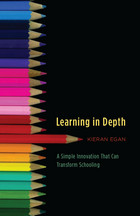 Learning in Depth: A Simple Innovation That Can Transform Schooling
Kieran Egan
University of Chicago Press, 2011 For generations, schools have aimed to introduce students to a broad range of topics through curriculum that ensure that they will at least have some acquaintance with most areas of human knowledge by the time they graduate. Yet such broad knowledge can’t help but be somewhat superficial—and, as Kieran Egan argues, it omits a crucial aspect of true education: deep knowledge. Real education, Egan explains, consists of both general knowledge and detailed understanding, and in Learning in Depth he outlines an ambitious yet practical plan to incorporate deep knowledge into basic education. Under Egan’s program, students will follow the usual curriculum, but with one crucial addition: beginning with their first days of school and continuing until graduation, they will eachalso study one topic—such as apples, birds, sacred buildings, mollusks,circuses, or stars—in depth. Over the years, with the help and guidance of their supervising teacher, students will expand their understanding of their one topic and build portfolios of knowledge that grow and change along with them. By the time they graduate each student will know as much about his or her topic as almost anyone on earth—and in the process will have learned important, even life-changing lessons about the meaning of expertise, the value of dedication, and the delight of knowing something in depth. Though Egan’s program may be radical in its effects, it is strikingly simple to implement—as a number of schools have already discovered—and with Learning in Depth as a blueprint, parents, educators, and administrators can instantly begin taking the first steps toward transforming our schools and fundamentally deepening their students’ minds.
Learning in Language and Literature: The Developing Imagination. Insistent Tasks in Language Learning
A. R. MacKinnon and Northrop Frye
Harvard University Press Two complementary lectures approach the problems of education from both practical and imaginative viewpoints.
In The Developing Imagination, Northrup Frye argues that “the ultimate purpose of teaching literature is…the transferring of the imaginative habit…from the laboratory of literature to the life of mankind.” Frye’s sympathies are with the pupil as he defends imagination and individualism.
A. R. MacKinnon’s Insistent Tasks in Language Learning suggests that “fragmentation” between primary, secondary, and college education intensifies the divergence of humanities and sciences. He proposes a means of cooperation between all educational levels.
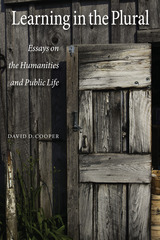 Learning in the Plural: Essays on the Humanities and Public Life
David D. Cooper
Michigan State University Press, 2014 Can civic engagement rescue the humanities from a prolonged identity crisis? How can the practices and methods, the conventions and innovations of humanities teaching and scholarship yield knowledge that contributes to the public good? These are just two of the vexing questions David D. Cooper tackles in his essays on the humanities, literacy, and public life. As insightful as they are provocative, these essays address important issues head-on and raise questions about the relevance and roles of humanities teaching and scholarship, the moral footings and public purposes of the humanities, engaged teaching practices, institutional and disciplinary reform, academic professionalism, and public scholarship in a democracy. Destined to stir discussion about the purposes of the humanities and the problems we face during an era of declining institutional support, public alienation and misunderstanding, student ambivalence, and diminishing resources, the questions Cooper raises in this book are uncomfortable and, in his view, necessary for reflection, renewal, and reform. With frank, deft assessments, Cooper reports on active learning initiatives that reenergized his own teaching life while reshaping the teaching mission of the humanities, including service learning, collaborative learning, the learning community movement, and student-centered and deliberative pedagogy.
Learning Legacies: Archive to Action through Women's Cross-Cultural Teaching
Sarah Ruffing Robbins
University of Michigan Press, 2017 Learning Legacies explores the history of cross-cultural teaching approaches, to highlight how women writer-educators used stories about their collaborations to promote community-building. Robbins demonstrates how educators used stories that resisted dominant conventions and expectations about learners to navigate cultural differences. Using case studies of educational initiatives on behalf of African American women, Native American children, and the urban poor, Learning Legacies promotes the importance of knowledge grounded in the histories and cultures of the many racial and ethnic groups that have always comprised America’s populace, underscoring the value of rich cultural knowledge in pedagogy by illustrating how creative teachers still draw on these learning legacies today.
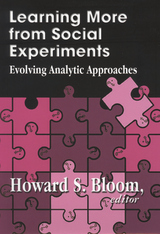 Learning More from Social Experiments: Evolving Analytic Approaches
Howard S. Bloom
Russell Sage Foundation, 2005 Policy analysis has grown increasingly reliant on the random assignment experiment—a research method whereby participants are sorted by chance into either a program group that is subject to a government policy or program, or a control group that is not. Because the groups are randomly selected, they do not differ from one another systematically. Therefore any differences between the groups at the end of the study can be attributed solely to the influence of the program or policy. But there are many questions that randomized experiments have not been able to address. What component of a social policy made it successful? Did a given program fail because it was designed poorly or because it suffered from low participation rates? In Learning More from Social Experiments, editor Howard Bloom and a team of innovative social researchers profile advancements in the scientific underpinnings of social policy research that can improve randomized experimental studies. Using evaluations of actual social programs as examples, Learning More from Social Experiments makes the case that many of the limitations of random assignment studies can be overcome by combining data from these studies with statistical methods from other research designs. Carolyn Hill, James Riccio, and Bloom profile a new statistical model that allows researchers to pool data from multiple randomized-experiments in order to determine what characteristics of a program made it successful. Lisa Gennetian, Pamela Morris, Johannes Bos, and Bloom discuss how a statistical estimation procedure can be used with experimental data to single out the effects of a program's intermediate outcomes (e.g., how closely patients in a drug study adhere to the prescribed dosage) on its ultimate outcomes (the health effects of the drug). Sometimes, a social policy has its true effect on communities and not individuals, such as in neighborhood watch programs or public health initiatives. In these cases, researchers must randomly assign treatment to groups or clusters of individuals, but this technique raises different issues than do experiments that randomly assign individuals. Bloom evaluates the properties of cluster randomization, its relevance to different kinds of social programs, and the complications that arise from its use. He pays particular attention to the way in which the movement of individuals into and out of clusters over time complicates the design, execution, and interpretation of a study. Learning More from Social Experiments represents a substantial leap forward in the analysis of social policies. By supplementing theory with applied research examples, this important new book makes the case for enhancing the scope and relevance of social research by combining randomized experiments with non-experimental statistical methods, and it serves as a useful guide for researchers who wish to do so.
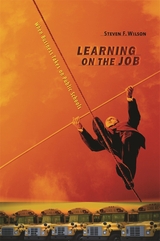 Learning on the Job: When Business Takes On Public Schools
Steven F. Wilson
Harvard University Press, 2006 Entrepreneurial creativity, private investment, and competition have been among America's great strengths. Can they be harnessed to improve troubled public schools? Or is private management of public schools at best a gimmick, and at worst an undemocratic sellout?
In the 1990s, some failing school systems turned to private education management organizations to manage their schools. The EMOs promised academic improvement to families and profits to their investors. Wall Street and foundations lavished hundreds of millions of dollars on for-profit and nonprofit start-ups, and thousands of students' educations began to be directed not by school officials, but by private companies.
In Learning on the Job, industry insider Steven Wilson, the founder and CEO of Advantage Schools, looks back on the first tumultuous decade of this social experiment. Digging deep into the academic, financial, logistic, and political records of seven leading EMOs, including his own, he reveals the potential and pitfalls of their business and educational models, and their actual successes in the classrooms and the boardrooms. Have they given their students a better education? Can they succeed as businesses? Can businesses in fact run better public schools than school districts?
With remarkable honesty and fairness on an ideologically charged topic, Wilson describes the follies and wisdom, overreaching and real accomplishment, of the first education entrepreneurs. Acknowledging that they had much to learn about the real-world challenges of running schools, he passionately defends the promise of private involvement in public schooling.
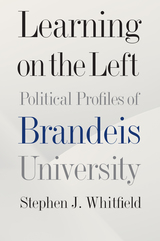 Learning on the Left: Political Profiles of Brandeis University
Stephen J. Whitfield
Brandeis University Press, 2020 Brandeis University is the United States’ only Jewish-sponsored nonsectarian university, and while only being established after World War II, it has risen to become one of the most respected universities in the nation. The faculty and alumni of the university have made exceptional contributions to myriad disciplines, but they have played a surprising formidable role in American politics.
Stephen J. Whitfield makes the case for the pertinence of Brandeis University in understanding the vicissitudes of American liberalism since the mid-twentieth century. Founded to serve as a refuge for qualified professors and students haunted by academic antisemitism, Brandeis University attracted those who generally envisioned the republic as worthy of betterment. Whether as liberals or as radicals, figures associated with the university typically adopted a critical stance toward American society and sometimes acted upon their reformist or militant beliefs. This volume is not an institutional history, but instead shows how one university, over the course of seven decades, employed and taught remarkable men and women who belong in our accounts of the evolution of American politics, especially on the left. In vivid prose, Whitfield invites readers to appreciate a singular case of the linkage of political influence with the fate of a particular university in modern America.
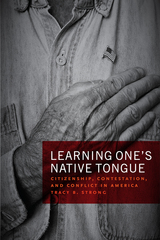 Learning One’s Native Tongue: Citizenship, Contestation, and Conflict in America
Tracy B. Strong
University of Chicago Press, 2019 Citizenship is much more than the right to vote. It is a collection of political capacities constantly up for debate. From Socrates to contemporary American politics, the question of what it means to be an authentic citizen is an inherently political one.
With Learning One’s Native Tongue, Tracy B. Strong explores the development of the concept of American citizenship and what it means to belong to this country,
starting with the Puritans in the seventeenth century and continuing to the present day. He examines the conflicts over the meaning of citizenship in the writings and speeches of prominent thinkers and leaders ranging from John Winthrop and Roger Williams to Thomas Jefferson, Nathaniel Hawthorne, Abraham Lincoln, Frederick Douglass, and Franklin Roosevelt, among many others who have participated in these important cultural and political debates. The criteria that define what being a citizen entails change over time and in response to historical developments, and they are thus also often the source of controversy and conflict, as with voting rights for women and African Americans. Strong looks closely at these conflicts and the ensuing changes in the conception of citizenship, paying attention to what difference each change makes and what each particular conception entails socially and politically.
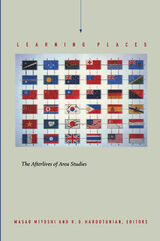 Learning Places: The Afterlives of Area Studies
Masao Miyoshi and H.D. Harootunian, eds.
Duke University Press, 2002 Under globalization, the project of area studies and its relationship to the fields of cultural, ethnic, and gender studies has grown more complex and more in need of the rigorous reexamination that this volume and its distinguished contributors undertake. In the aftermath of World War II, area studies were created in large part to supply information on potential enemies of the United States. The essays in Learning Places argue, however, that the post–Cold War era has seen these programs largely degenerate into little more than public relations firms for the areas they research. A tremendous amount of money flows—particularly within the sphere of East Asian studies, the contributors claim—from foreign agencies and governments to U.S. universities to underwrite courses on their histories and societies. In the process, this volume argues, such funds have gone beyond support to the wholesale subsidization of students in graduate programs, threatening the very integrity of research agendas. Native authority has been elevated to a position of primacy; Asian-born academics are presumed to be definitive commentators in Asian studies, for example. Area studies, the contributors believe, has outlived the original reason for its construction. The essays in this volume examine particular topics such as the development of cultural studies and hyphenated studies (such as African-American, Asian-American, Mexican-American) in the context of the failure of area studies, the corporatization of the contemporary university, the prehistory of postcolonial discourse, and the problematic impact of unformulated political goals on international activism. Learning Places points to the necessity, the difficulty, and the possibility in higher education of breaking free from an entrenched Cold War narrative and making the study of a specific area part of the agenda of education generally. The book will appeal to all whose research has a local component, as well as to those interested in the future course of higher education generally. Contributors. Paul A. Bové, Rey Chow, Bruce Cummings, James A. Fujii, Harry Harootunian, Masao Miyoshi, Tetsuo Najita, Richard H. Okada, Benita Parry, Moss Roberts, Bernard S. Silberman, Stefan Tanaka, Rob Wilson, Sylvia Yanagisako, Mitsuhiro Yoshimoto
 Learning Politics From Sivaram: The Life and Death of a Revolutionary Tamil Journalist in Sri Lanka
Mark P. Whitaker
Pluto Press, 2007 This is the story of the life and impact of the political activist, journalist, and freedom fighter Sivaram Dharmeratnam. Sivaram dedicated his life to helping the Tamil people. He started out as an active participant in the war against the Sri Lankan government—in the eyes of some, a "terrorist." Yet he eventually renounced the violence it involved. Instead, he became a journalist and used his position to fearlessly critique the government—despite repeated threats on his life and the murders of other journalists. Finally, in 2005, Sivaram himself was assassinated.
This remarkable book is both an intimate portrait of the man and a fascinating account of the political dilemmas that he faced—and that still face us today. It explains how an educated man adopts a position of supporting violence. And while his position softens, Sivaram remains critical of the liberal principles that govern Western policy. Written by a close friend, this unique account highlights some of the most difficult political questions facing us today.
 Learning Processes with a Deadly Outcome
Alexander Kluge
Duke University Press, 1996 Fiction writer, internationally known filmmaker, critical theorist, Alexander Kluge is perhaps postwar Germany’s most prolific and diverse intellectual. With this translation of Learning Processes with a Deadly Outcome, a novella first published in German in 1973, one of Kluge’s most important literary works becomes available to an English-speaking audience for the first time. Written in a quasi-documentary style, this fascinating hybrid work combines science fiction with modernist forms of montage and reportage to describe a future in which Earth has been almost totally destroyed following the catastrophic Black War. The planet’s remaining inhabitants have been driven underground or into space where the struggle to establish a new society rages on.
Whether describing the scene in China where the devastated landscape is reconstructed according to old paintings, or in the galactic realm of the Starway where giant, turf-battling, corporate colonizing forces exploit the universe’s resources, Kluge tells his tale by inventing various forms of “evidence” that satirize the discourses of administrative bureaucracy, the law, military security, and the media. He gives us some of his most bizarre and hilarious characters in this peculiar world in which the remains of the past are mixed with the most advanced elements of the future. The cast includes highly specialized women workers who have adapted to the massive gravitational field of their heavy-metal planets, a commander with lethal foot-fungus, and ex-Nazi space pioneers who, in their lonely exile from the conflagrations on earth, spend their time carving enormous facsimiles of operatic sheet music in the forests of uninhabited planets.
With parody, and humor, Kluge shows how the survivors of Armageddon attempt to learn the art of civilization, and, despite the disaster they have suffered, how they set out to reproduce at new sites a caricature of a classic and fascistic feudal capitalism.
 Learning Psychotherapy: Rationale and Ground Rules
Hilde Bruch
Harvard University Press, 1974 Hilde Bruch sets out to accomplish what has, until now, been virtually impossible—the teaching of psychotherapy by use of the written word, communicating the wisdom of a lifetime. Perhaps Dr. Bruch’s unique success at a task that has been tried and tried again, only to result in stereotyped dos and don’ts, stems from her own learning experiences with two great teachers: Harry Stack Sullivan and Frieda Fromm-Reichmann.
Dr. Bruch shares her knowledge of the essential purpose of intensive psychotherapy as it has been shaped over her many years as a psychiatrist, psychoanalyst, and teacher. She sets forth a theoretical frame in straightforward and unmystical language without minimizing the complexities of demand that therapy makes on both patient and therapist.
The reader accompanies the therapist from his first encounter with the stranger who comes to him with his trouble through the various steps that lead to the resolution of the problems. The patient is viewed as a participant in a multifaceted system of many experiences and people, not as an individual isolated from the world around him. In Dr. Bruch’s conception, psychotherapy is a situation where two people interact and try to come to an understanding of one another, with the specific goal of accomplishing something beneficial for the complaining person. The factors that help or hinder the attainment of this interaction are spelled out in the book, and the entire process of learning psychotherapy is thereby illuminated.
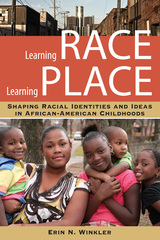 Learning Race, Learning Place: Shaping Racial Identities and Ideas in African American Childhoods
Winkler, Erin N
Rutgers University Press, 2012 In an American society both increasingly diverse and increasingly segregated, the signals children receive about race are more confusing than ever. In this context, how do children negotiate and make meaning of multiple and conflicting messages to develop their own ideas about race? Learning Race, Learning Place engages this question using in-depth interviews with an economically diverse group of African American children and their mothers. Through these rich narratives, Erin N. Winkler seeks to reorient the way we look at how children develop their ideas about race through the introduction of a new framework—comprehensive racial learning—that shows the importance of considering this process from children’s points of view and listening to their interpretations of their experiences, which are often quite different from what the adults around them expect or intend. At the children’s prompting, Winkler examines the roles of multiple actors and influences, including gender, skin tone, colorblind rhetoric, peers, family, media, school, and, especially, place. She brings to the fore the complex and understudied power of place, positing that while children’s racial identities and experiences are shaped by a national construction of race, they are also specific to a particular place that exerts both direct and indirect influence on their racial identities and ideas.
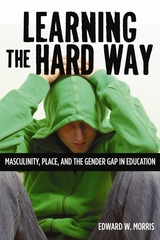 Learning the Hard Way: Masculinity, Place, and the Gender Gap in Education
Morris, Edward
Rutgers University Press, 2012 An avalanche of recent newspapers, weekly newsmagazines, scholarly journals, and academic books has helped to spark a heated debate by publishing warnings of a “boy crisis” in which male students at all academic levels have begun falling behind their female peers. In Learning the Hard Way, Edward W. Morris explores and analyzes detailed ethnographic data on this purported gender gap between boys and girls in educational achievement at two low-income high schools—one rural and predominantly white, the other urban and mostly African American. Crucial questions arose from his study of gender at these two schools. Why did boys tend to show less interest in and more defiance toward school? Why did girls significantly outperform boys at both schools? Why did people at the schools still describe boys as especially “smart”? Morris examines these questions and, in the process, illuminates connections of gender to race, class, and place. This book is not simply about the educational troubles of boys, but the troubled and complex experience of gender in school. It reveals how particular race, class, and geographical experiences shape masculinity and femininity in ways that affect academic performance. His findings add a new perspective to the “gender gap” in achievement.
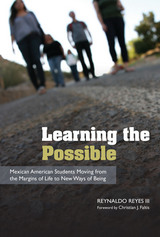 Learning the Possible: Mexican American Students Moving from the Margins of Life to New Ways of Being
Reynaldo Reyes III; Foreword by Christian J. Faltis
University of Arizona Press, 2013 Learning the Possible demonstrates that it is truly possible for underprepared high school graduates to be successful in college. It chronicles the struggles and triumphs of five Mexican American students in their first year of college, aided by a one-year scholarship and support program called the College Assistance Migrant Program. CAMP, a federally funded program, is designed to help college students from migrant and/or economically disadvantaged families complete their first year of college. CAMP’s principal objective is to put students on a trajectory toward completion of a bachelor’s degree.
Laura, Christina, Luz, Maria, and Ruben, as the author calls them, had daunting challenges: difficulties with English, extremely low self-confidence, teenage motherhood, conflict between gender roles and personal desires, and a history of gang membership. Focusing on the importance of constructing a new identity as a successful student, Reynaldo Reyes III shares with readers the experiences of these marginalized students. Their stories, coupled with perspectives from instructors, CAMP staff and counselors, and the author’s own observations, illustrate the influence of past schooling, the persistence of culture, and the tensions and challenges inherent in developing a new identity.
This is a study of students who came from the margins and, in a very short time, moved toward the mainstream. In the micro view, it provides extraordinarily useful case studies of a successful intervention program in process. In the larger scope, it is a look at the socially constructed nature of possibility, hope, and success.
Learning Theory in School Situations
Esther J. Swenson, George Lester Anderson, and Chalmers L. StacyIntroduction by T. R. McConnell
University of Minnesota Press, 1949
Learning Theory in School Situations was first published in 1949. Minnesota Archive Editions uses digital technology to make long-unavailable books once again accessible, and are published unaltered from the original University of Minnesota Press editions.
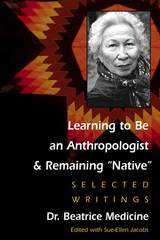 LEARNING TO BE AN ANTHROPOLOGIST: SELECTED WRITINGS
Dr. Beatrice Medicine
University of Illinois Press, 2001 This prodigious volume represents a landmark assemblage of the significant work of the legendary anthropologist and Native American intellectual Beatrice Medicine.
For half a century, Dr. Medicine has defied stereotypes, racism, and sexism in her life and work while combating the reductive, patronizing views of Native Americans perpetuated by mainstream anthropologists. This retrospective collection reflects her unswerving commitment to furthering Native Americans' ability to speak for themselves and deal with the problems of contemporary life.
Learning to Be an Anthropologist and Remaining "Native" includes Medicine's clear-eyed views of assimilation, bilingual education, and the adaptive strategies by which Native Americans have conserved and preserved their ancestral languages. Her discussions of sex roles in contemporary Native American societies encompass homosexual orientation among males and females and the "warrior woman" role among Plains Indians as one of several culturally accepted positions according power and prestige to women. The volume also includes Medicine's thoughtful assessments of kinship and family structures, alcoholism and sobriety, the activism implicit in the religious ritual of the Lakota Sioux Sun Dance, and the ceremonial uses of Lakota star quilts.
"The Native American is possibly the least understood ethnic minority in contemporary American society," Medicine observes. Her decades of deliberate, generous, dedicated work have done much to reveal the workings of Native culture while illuminating the effects of racism and oppression on Indian families, kinship units, and social and cultural practices.
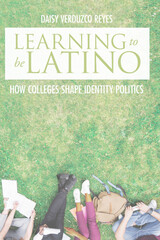 Learning to Be Latino: How Colleges Shape Identity Politics
Reyes, Daisy Verduzco
Rutgers University Press, 2018 In Learning to Be Latino, sociologist Daisy Verduzco Reyes paints a vivid picture of Latino student life at a liberal arts college, a research university, and a regional public university, outlining students’ interactions with one another, with non-Latino peers, and with faculty, administrators, and the outside community. Reyes identifies the normative institutional arrangements that shape the social relationships relevant to Latino students’ lives, including school size, the demographic profile of the student body, residential arrangements, the relationship between students and administrators, and how well diversity programs integrate students through cultural centers and retention centers. Together these characteristics create an environment for Latino students that influences how they interact, identify, and come to understand their place on campus.
Drawing on extensive ethnographic observations, Reyes shows how college campuses shape much more than students’ academic and occupational trajectories; they mold students’ ideas about inequality and opportunity in America, their identities, and even how they intend to practice politics.
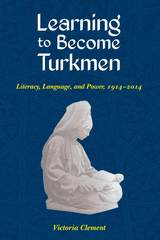 Learning to Become Turkmen: Literacy, Language, and Power, 1914-2014
Victoria Clement
University of Pittsburgh Press, 2018 Learning to Become Turkmen examines the ways in which the iconography of everyday life—in dramatically different alphabets, multiple languages, and shifting education policies—reflects the evolution of Turkmen society in Central Asia over the past century. As Victoria Clement shows, the formal structures of the Russian imperial state did not affect Turkmen cultural formations nearly as much as Russian language and Cyrillic script. Their departure was also as transformative to Turkmen politics and society as their arrival.
Complemented by extensive fieldwork, Learning to Become Turkmen is the first book in a Western language to draw on Turkmen archives, as it explores how Eurasia has been shaped historically. Revealing particular ways that Central Asians relate to the rest of the world, this study traces how Turkmen consciously used language and pedagogy to position themselves within global communities such as the Russian/Soviet Empire, the Turkic cultural continuum, and the greater Muslim world.
Learning to Change: The Experience of Transforming Education in South East Europe
Terrice Bassler
Central European University Press, 2005 A collection of first-person narratives by specialists in the field of education in South East Europe. The contributors are recognized leaders in civil society, government, academia and schools. Their works chronicle the profound effect armed conflict, political transition, and the increasing openness the region has experienced on education. It is a significant achievement as it is the work of individuals who are involved in the field and have a first hand perspective on issues of education in the region. The essays shed light on the reality of the educational reforms: they are far from beeing linear progressive processes, on the contrary, they are very often paradoxical and even controversial.
 Learning to Dance: Advancing Women’s Reproductive Health and Well-Being from the Perspectives of Public Health and Human Rights
Alicia Ely Yamin
Harvard University Press This book promotes understanding of how the fields of health and human rights can better work together, including both addressing human rights implications of reproductive health interventions and fostering rights-based policies and laws relating to sexuality and reproductive health. A decade after the groundbreaking Cairo Conference on Population and Development a serious gap remains between the reproductive health and human rights fields. Too often, despite using the same language, the two fields do not seem to share the same understanding or strategies. In order to better understand the links and synergies between reproductive health and human rights as well as the continuing gaps between the two fields, this book brings together twelve experts to compare how each field traditionally approaches a situation that presents both public health and human rights implications. Six case studies, illustrating a range of issues in sexual and reproductive health, are analyzed by both a public health expert and a human rights expert, and a separate essay synthesizes the convergences and divergences between the two approaches and points to ways forward.
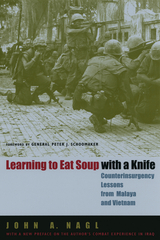 Learning to Eat Soup with a Knife: Counterinsurgency Lessons from Malaya and Vietnam
John A. Nagl
University of Chicago Press, 2005 Invariably, armies are accused of preparing to fight the previous war. In Learning to Eat Soup with a Knife, Lieutenant Colonel John A. Nagl—a veteran of both Operation Desert Storm and the current conflict in Iraq—considers the now-crucial question of how armies adapt to changing circumstances during the course of conflicts for which they are initially unprepared. Through the use of archival sources and interviews with participants in both engagements, Nagl compares the development of counterinsurgency doctrine and practice in the Malayan Emergency from 1948 to 1960 with what developed in the Vietnam War from 1950 to 1975.
In examining these two events, Nagl—the subject of a recent New York Times Magazine cover story by Peter Maass—argues that organizational culture is key to the ability to learn from unanticipated conditions, a variable which explains why the British army successfully conducted counterinsurgency in Malaya but why the American army failed to do so in Vietnam, treating the war instead as a conventional conflict. Nagl concludes that the British army, because of its role as a colonial police force and the organizational characteristics created by its history and national culture, was better able to quickly learn and apply the lessons of counterinsurgency during the course of the Malayan Emergency.
With a new preface reflecting on the author's combat experience in Iraq, Learning to Eat Soup with a Knife is a timely examination of the lessons of previous counterinsurgency campaigns that will be hailed by both military leaders and interested civilians.
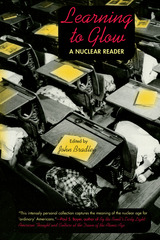 Learning to Glow: A Nuclear Reader
John Bradley
University of Arizona Press, 2000 Atomic energy is not only invisible, it has been cloaked in secrecy by government, industry, and the military. Yet for many Americans the effects of radiation have been less than secret. Just ask the radium workers in Ottawa, Illinois, the "downwinders" of Utah, or unsuspecting veterans of the Gulf War. When told from the perspective of ordinary people, nuclear history takes on a much different tone from that of the tranquil voices of authority who always told us we had nothing to fear. In Learning to Glow, twenty-four essays testify to many of the unsuspected human and environmental costs of atomic science. They show that Americans have paid a terrible price for supposedly "winning" the Cold War--for although the nuclear nightmare may be over, we are still living with nuclear threats every day. Writers such as Scott Russell Sanders, Terry Tempest Williams, and Barbara Kingsolver reveal the psychic and emotional fallout of the Cold War and of subsequent developments in nuclear science. The essays include personal testimonies of what it was like to grow up with family members in nuclear-related jobs; hard-hitting journalism on the health and environmental costs of our nuclear policies and practices; and poignant stories of coming to terms with nuclear power, including contributions by writers who revisit Hiroshima in an attempt to heal the wounds left by the Bomb. These essays offer an alternative to the official version of nuclear history as told to us by school textbooks, government authorities, and nuclear industry officials. They are stories of and by ordinary people who have suffered the consequences of the decisions made by those in power-stories that have been largely ignored, dismissed, or suppressed. They will challenge readers to re-examine their preconceptions about the way we deal with issues of nuclear arms and radioactive waste because they show that nuclear history does not belong to experts but to us all. Contributors:
Marilou Awiakta
John Bradley
Jim Carrier
Alison Hawthorne Deming
Mary Dickson
Edward Dougherty
Ray Gonzalez
Karl Grossman
Sonya Huber
Barbara Kingsolver
Valerie Kuletz
Mary Laufer
Kay Mack
Craig McGrath
Bill Mesler
Richard H. Minear
Randy Morris
Mayumi Oda
Catherine Quigg
Richard Rawles
Kenneth Robbins
Scott Russell Sanders
David Seaborg
Terry Tempest Williams
Bill Witherup
Phil Woods
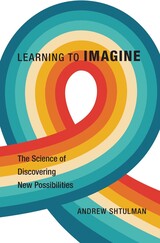 Learning to Imagine: The Science of Discovering New Possibilities
Andrew Shtulman
Harvard University Press, 2023 An award-winning cognitive scientist offers a counterintuitive guide to cultivating imagination.
Imagination is commonly thought to be the special province of youth—the natural companion of free play and the unrestrained vistas of childhood. Then come the deadening routines and stifling regimentation of the adult world, dulling our imaginative powers. In fact, Andrew Shtulman argues, the opposite is true. Imagination is not something we inherit at birth, nor does it diminish with age. Instead, imagination grows as we do, through education and reflection.
The science of cognitive development shows that young children are wired to be imitators. When confronted with novel challenges, they struggle to think outside the box, and their creativity is rigidly constrained by what they deem probable, typical, or normal. Of course, children love to “play pretend,” but they are far more likely to simulate real life than to invent fantasy worlds of their own. And they generally prefer the mundane and the tried-and-true to the fanciful or the whimsical.
Children’s imaginations are not yet fully formed because they necessarily lack knowledge, and it is precisely knowledge of what is real that provides a foundation for contemplating what might be possible. The more we know, the farther our imaginations can roam. As Learning to Imagine demonstrates, the key to expanding the imagination is not forgetting what you know but learning something new. By building upon the examples of creative minds across diverse fields, from mathematics to religion, we can consciously develop our capacities for innovation and imagination at any age.
 Learning to Lead: Undocumented Students Mobilizing Education
Jennifer R. Nájera
Duke University Press, 2024 In Learning to Lead, Jennifer R. Nájera explores the intersections of education and activism among undocumented students at the University of California, Riverside. Taking an expansive view of education, Nájera shows how students’ experiences in college—both in and out of the classroom—can affect their activism and advocacy work. Students learn from their families, communities, peers, and student and political organizations. In these different spaces, they learn how to navigate community and college life as undocumented people. Students are able to engage campus organizations where they can cultivate their leadership skills and—importantly—learn that they are not alone. These students embody and mobilize their education through both large and small political actions such as protests, workshops for financial aid applications, and Know Your Rights events. As students create community with each other, they come to understand that their individual experiences of illegality are part of a larger structure of legal violence. This type of education empowers students to make their way to and through college, change their communities, and ultimately assert their humanity.
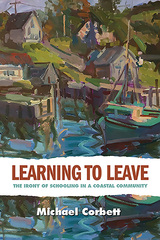 Learning to Leave: The Irony of Schooling in a Coastal Community
Michael Corbett
West Virginia University Press, 2020 Published with a new preface, this innovative case study from Nova Scotia analyzes the relationship between rural communities and contemporary education. Rather than supporting place-sensitive curricula and establishing networks within community populations, the rural school has too often stood apart from local life, with the generally unintended consequence that many educationally successful rural youth come to see their communities and lifestyles as places to be left behind. They face what Michael Corbett calls a mobility imperative, which, he shows, has been central to contemporary schooling. Learning to Leave argues that if education is to be democratic and serve the purpose of economic, social, and cultural development, then it must adapt and respond to the specificity of its locale, the knowledge practices of the people, and the needs of those who struggle to remain in challenged rural places.
Learning to Listen: A Handbook for Music
Grosvenor Cooper
University of Chicago Press, 1962 This clearly written guide to good listening habits is an excellent introduction to the essential musical knowledge one needs to understand the great musical masterpieces of past and present. Complete with examples and illustrations, this handbook introduces its reader to technicalities such as notation, terminology, and metrics, and will enable him to follow a score, identify instruments, pick out themes, and recognize common musical terms.
Learning to Listen to the Land
Edited by Bill Willers
Island Press, 1991 In this inspired collection, some of America's most provocative thinkers and writers reflect on nature and enviornmetnal science--reaching compelling conclusions about humanity's relationship to the earth. Balanced by science and fact, Learning to Listen to the Land explains the significance of our modern environmental crisis. The authors underscore the necessity forworking within, rather than counter to, our larger ecosystem.
Learning to Listen to the Land represents the sounding of an alarm. It's authors call on us to recognize the consequences of our actions, and inactions, and to develop a sense of connection with the earth.
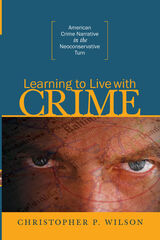 Learning to Live with Crime: American Crime Narrative in the Neoconservative Turn
Christopher P. Wilson
Ohio State University Press, 2010 Since the mid-1960s, the war on crime has reshaped public attitudes about state authority, criminal behavior, and the responsibilities of citizenship. But how have American writers grappled with these changes? What happens when a journalist approaches the workings of organized crime not through its legendary Godfathers but through a workaday, low-level figure who informs on his mob? Why is it that interrogation scenes have become so central to prime-time police dramas of late? What is behind writers’ recent fascination with “cold case” homicides, with private security, or with prisons?
In Learning to Live with Crime, Christopher P. Wilson examines this war on crime and how it has made its way into cultural representation and public consciousness. Under the sway of neoconservative approaches to criminal justice and public safety, Americans have been urged to see crime as an inevitable risk of modern living and to accept ever more aggressive approaches to policing, private security, and punishment. The idea has been not simply to fight crime but to manage its risks; to inculcate personal vigilance in citizens; and to incorporate criminals’ knowledge through informants and intelligence gathering. At its most scandalous, this study suggests, contemporary law enforcement has even come to mimic crime’s own operations.
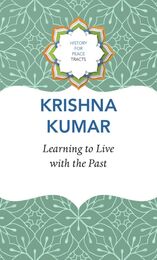 Learning to Live with the Past
Krishna Kumar
Seagull Books, 2023 This essay examines the history of the Indian subcontinent and the Partition of 1947 from a pedagogical perspective.
How does education shape political rivalry and hostility? The Partition of the Indian subcontinent in 1947—the violence that followed it, and its living legacy of rival nationalisms—has made a deep and pervasive impact on education in both India and Pakistan. In Learning to Live with the Past, educationist Krishna Kumar dwells on the complex terrain every history teacher has to navigate: how to make the past come alive without running the risk of creating a desire to lose this “pastness.”
Substantiating this question with a wealth of experiences gained from his extensive research on history textbooks, as well as his interactions with students and teachers in both countries, Kumar explores the integral function the discipline of history plays in the project of nation-building. To help children learn to live with the past, Kumar amplifies the need for spaces that create possibilities for inquiries into a “longer” common heritage shared by South Asia without necessarily denying a national narrative or encouraging an urge to undo the past.
Learning to Look: A Handbook for the Visual Arts
Joshua C. Taylor
University of Chicago Press, 1981 Sometimes seeing is more difficult for the student of art than believing. Taylor, in a book that has sold more than 300,000 copies since its original publication in 1957, has helped two generations of art students "learn to look."
This handy guide to the visual arts is designed to provide a comprehensive view of art, moving from the analytic study of specific works to a consideration of broad principles and technical matters. Forty-four carefully selected illustrations afford an excellent sampling of the wide range of experience awaiting the explorer.
The second edition of Learning to Look includes a new chapter on twentieth-century art. Taylor's thoughtful discussion of pure forms and our responses to them gives the reader a few useful starting points for looking at art that does not reproduce nature and for understanding the distance between contemporary figurative art and reality.
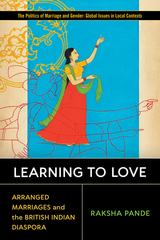 Learning to Love: Arranged Marriages and the British Indian Diaspora
Raksha Pande
Rutgers University Press, 2021 Learning to Love moves beyond the media and policy stereotypes that conflate arranged marriages with forced marriages. Using in-depth interviews and participant observations, this book assembles a rich and diverse array of everyday marriage narratives and trajectories and highlights how considerations of romantic love are woven into traditional arranged marriage practices. It shows that far from being a homogeneous tradition, arranged marriages involve a variety of different matchmaking practices where each family tailors its own cut-and-paste version of British-Indian arranged marriages to suit modern identities and ambitions. Pande argues that instead of being wedded to traditions, people in the British-Indian diaspora have skillfully adapted and negotiated arranged marriage cultural norms to carve out an identity narrative that portrays them as "modern and progressive migrants"–ones who are changing with the times and cultivating transnational forms of belonging.
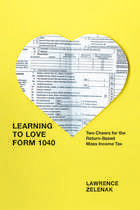 Learning to Love Form 1040: Two Cheers for the Return-Based Mass Income Tax
Lawrence Zelenak
University of Chicago Press, 2013 No one likes paying taxes, much less the process of filing tax returns. For years, would-be reformers have advocated replacing the return-based mass income tax with a flat tax, federal sales tax, or some combination thereof. Congress itself has commissioned studies on the feasibility of a system of exact withholding. But might the much-maligned return-based taxation method serve an important yet overlooked civic purpose?
In Learning to Love Form 1040, Lawrence Zelenak argues that filing taxes can strengthen fiscal citizenship by prompting taxpayers to reflect on the contract they have with their government and the value—or perceived lack of value—they receive in exchange for their money. Zelenak traces the mass income tax to its origins as a means for raising revenue during World War II. Even then, debates raged over the merits of consumption-based versus income taxation, as well as whether taxes should be withheld from payroll or paid at the time of filing. The result is the income tax system we have today—a system whose maddening complexity, intended to accommodate citizens in widely different circumstances, threatens to outweigh any civic benefits.
If sitcoms and political cartoons are any indication, public understanding of the income tax is badly in need of a corrective. Zelenak clears up some of the most common misconceptions and closes with suggestions for how the current system could be substantially simplified to better serve its civic purpose.
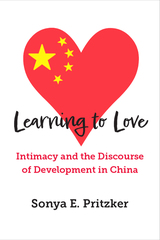 Learning to Love: Intimacy and the Discourse of Development in China
Sonya E. Pritzker
University of Michigan Press, 2024 Learning to Love offers a range of perspectives on the embodied, relational, affective, and sociopolitical project of “learning to love” at the New Life Center for Holistic Growth, a popular “mind-body-spirit” bookstore and practice space in northeast China, in the early part of the 21st century. This intimate form of self-care exists alongside the fast-moving, growing capitalist society of contemporary China and has emerged as an understandable response to the pressures of Chinese industrialized life in the early 21st century. Opening with an investigation of the complex ways newcomers to the center suffered a sense of being “off,” both in and with the world at multiple scales, Learning to Love then examines how new horizons of possibility are opened as people interact with one another as well as with a range of aesthetic objects at New Life.
Author Sonya Pritzker draws upon the core concepts of scalar intimacy—a participatory, discursive process in which people position themselves in relation to others as well as dominant ideologies, concepts, and ideals—and scalar inquiry—the process through which speakers interrogate these forms, their relationship with them, and their participation in reproducing them. In demonstrating the collaborative interrogation of culture, history, and memory, she examines how these exercises in physical, mental, and spiritual self-care allow participants to grapple with past social harms and forms of injustice, how historical systems of power—including both patriarchal and governance structures—continue in the present, and how they might be transformed in the future. By examining the interactions and relational experiences from New Life, Learning to Love offers a range of novel theoretical interventions into political subjectivity, temporality, and intergenerational trauma/healing.
Learning to Perform: An Introduction
Carol Simpson Stern
Northwestern University Press, 2010 In Learning to Perform Carol Simpson Stern and Bruce Henderson enliven the dialogue between theory and practice for actors and teachers alike. Beginning with an overview of the study of literary and cultural texts through performance, Stern and Henderson then translate literary and performance theory into concrete classroom experience. Learning to Perform presents a dynamic performance methodology that offers the tools students need to develop and refine performance skills, analyze texts, and think and reflect critically on performed texts. By addressing an expanded sense of text that includes cultural as well as literary artifacts, the authors bridge the gap between oral interpretation and the more inclusive field of performance studies that overarches it.
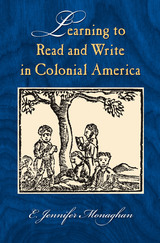 Learning to Read and Write in Colonial America
E. Jennifer Monaghan
University of Massachusetts Press, 2005 An experienced teacher of reading and writing and an award-winning historian, E. Jennifer Monaghan brings to vibrant life the process of learning to read and write in colonial America. Ranging throughout the colonies from New Hampshire to Georgia, she examines the instruction of girls and boys, Native Americans and enslaved Africans, the privileged and the poor, revealing the sometimes wrenching impact of literacy acquisition on the lives of learners.
For the most part, religious motives underlay reading instruction in colonial America, while secular motives led to writing instruction. Monaghan illuminates the history of these activities through a series of deeply researched and readable case studies. An Anglican missionary battles mosquitoes and loneliness to teach the New York Mohawks to write in their own tongue. Puritan fathers model scriptural reading for their children as they struggle with bereavement. Boys in writing schools, preparing for careers in counting houses, wield their quill pens in the difficult task of mastering a "good hand." Benjamin Franklin learns how to compose essays with no teacher but himself. Young orphans in Georgia write precocious letters to their benefactor, George Whitefield, while schools in South Carolina teach enslaved black children to read but never to write.
As she tells these stories, Monaghan clears new pathways in the analysis of colonial literacy. She pioneers in exploring the implications of the separation of reading and writing instruction, a topic that still resonates in today's classrooms.
Monaghan argues that major improvements occurred in literacy instruction and acquisition after about 1750, visible in rising rates of signature literacy. Spelling books were widely adopted as they key text for teaching young children to read; prosperity, commercialism, and a parental urge for gentility aided writing instruction, benefiting girls in particular. And a gentler vision of childhood arose, portraying children as more malleable than sinful. It promoted and even commercialized a new kind of children's book designed to amuse instead of convert, laying the groundwork for the "reading revolution" of the new republic.
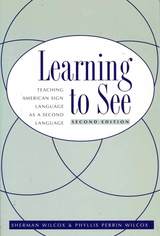 Learning To See: American Sign Language as a Second Language
Sherman Wilcox
Gallaudet University Press, 1997 As more and more secondary schools and colleges accept American Sign Language (ASL) as a legitimate choice for second language study, Learning to See has become even more vital in guiding instructors on the best ways to teach ASL as a second language. And now this groundbreaking book has been updated and revised to reflect the significant gains in recognition that deaf people and their native language, ASL, have achieved in recent years.
Learning to See lays solid groundwork for teaching and studying ASL by outlining the structure of this unique visual language. Myths and misconceptions about ASL are laid to rest at the same time that the fascinating, multifaceted elements of Deaf culture are described. Students will be able to study ASL and gain a thorough understanding of the cultural background, which will help them to grasp the language more easily. An explanation of the linguistic basis of ASL follows, leading into the specific, and above all, useful information on teaching techniques.
This practical manual systematically presents the steps necessary to design a curriculum for teaching ASL, including the special features necessary for training interpreters. The new Learning to See again takes its place at the forefront of texts on teaching ASL as a second language, and it will prove to be indispensable to educators and administrators in this special discipline.
 Learning to See Invisible Children: Inclusion of Children with Disabilities in Central Asia
Kate Lapham
Central European University Press, 2013 The path to inclusion for children with disabilities and other special education needs is long and complex. It has been claimed that inclusion is not a destination, but a process of increasing participation and reducing exclusion from the culture, curriculum and community of mainstream schools. This volume chronicles the journey toward greater inclusion of children with disabilities in Central Asia. Setting out upon this journey is an acknowledged policy goal in Kazakhstan, Kyrgyzstan, and Tajikistan so that all children are to participate in education, but it raises many questions and quandaries. It stirs the ghosts of social norms and traditions from the past that differ from place to place, even within the former Soviet Union. Central Asia presents particular challenges because of the economic, social, political and educational upheaval and disruption that has affected the region in the past two decades. These six case studies document the progress and challenges along the way through the stories of specific children, families, schools, and organizations across the region with the goal of keeping inclusion on policy agendas and in public discourses. It is a resource for scholars of the region, education researchers, and practitioners alike.
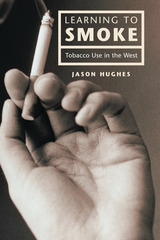 Learning to Smoke: Tobacco Use in the West
Jason Hughes
University of Chicago Press, 2002 Why do people smoke? Taking a unique approach to this question, Jason Hughes moves beyond the usual focus on biological addiction that dominates news coverage and public health studies and invites us to reconsider how social and personal understandings of smoking crucially affect the way people experience it. Learning to Smoke examines the diverse sociological and cultural processes that have compelled people to smoke since the practice was first introduced to the West during the sixteenth century.
Hughes traces the transformations of tobacco and its use over time, from its role as a hallucinogen in Native American shamanistic ritual to its use as a prophylactic against the plague and a cure for cancer by early Europeans, and finally to the current view of smoking as a global pandemic. He then analyzes tobacco from the perspective of the individual user, exploring how its consumption relates to issues of identity and life changes. Comparing sociocultural and personal experiences, Hughes ultimately asks what the patterns of tobacco use mean for the clinical treatment of smokers and for public policy on smoking. Pointing the way, then, to a more learned and sophisticated understanding of tobacco use, this study will prove to be essential reading for anyone interested in the history of smoking and the sociology of addiction.
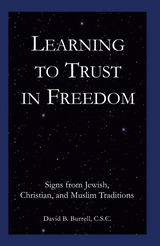 Learning to Trust in Freedom: Signs from Jewish, Christian, and Muslim Traditions
David B. Burrell, C.S.C.
University of Scranton Press, 2010 True religious faith cannot be confirmed by any external proofs. Rather, it is founded on a basic act of trust—and the common root of that trust, for Jewish, Christian, and Islamic traditions, is a belief in the divine creation of the universe. But with Learning to Trust in Freedom, David B. Burrell asks the provocative question: How do we reach that belief, and what is it about the universe that could possibly testify to its divine origins? Even St. Augustine, he points out, could only find faith after a harrowing journey through the lures of desire—and it is that very desire that Burrell seizes on as a tool with which to explore the origin and purpose of the world. Delving deep into the intertwinings of desire and faith, and drawing on St. John of the Cross, Edith Stein, and Charles Taylor, Burrell offers a new understanding of free will, trust, and perception.
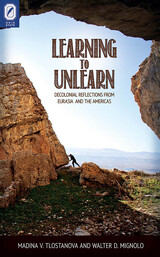 Learning to Unlearn: Decolonial Reflections from Eurasia and the Americas
Madina V. Tlostanova and Walter D. Mignolo
Ohio State University Press, 2012 Learning to Unlearn: Decolonial Reflections from Eurasia and the Americas is a complex, multisided rethinking of the epistemic matrix of Western modernity and coloniality from the position of border epistemology. Colonial and imperial differences are the two key concepts to understanding how the logic of coloniality creates ontological and epistemic exteriorities. Being at once an enactment of decolonial thinking and an attempt to define its main grounds, mechanisms, and concepts, the book shifts the politics of knowledge from “studying the other” (culture, society, economy, politics) toward “the thinking other” (the authors). Addressing areas as diverse as the philosophy of higher education, gender, citizenship, human rights, and indigenous agency, and providing fascinating and little-known examples of decolonial thinking, education, and art, Madina V. Tlostanova and Walter D. Mignolo deconstruct the modern architecture of knowledge—its production and distribution as manifested in the corporate university. In addition, the authors dwell on and define the echoing global decolonial sensibilities as expressed in the Americas and in peripheral Eurasia. The book is an important addition to the emerging transoceanic inquiries that introduce decolonial thought and non-Western border epistemologies not only to update or transform disciplines but also to act and think decolonially in the global futures to come.
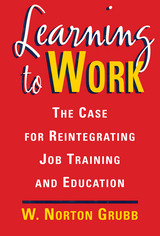 Learning to Work: The Case for Reintegrating Job Training and Education
W. Norton Grubb
Russell Sage Foundation, 1996 "Grubb's powerful vision of a workforce development system connected by vertical ladders for upward mobility adds an important new dimension to our continued efforts at system reform. The unfortunate reality is that neither our first-chance education system nor our second-chance job training system have succeeded in creating clear pathways out of poverty for many of our citizens. Grubb's message deserves a serious hearing by policy makers and practitioners alike." —Evelyn Ganzglass, National Governors' Association Over the past three decades, job training programs have proliferated in response to mounting problems of unemployment, poverty, and expanding welfare rolls. These programs and the institutions that administer them have grown to a number and complexity that make it increasingly difficult for policymakers to interpret their effectiveness. Learning to Work offers a comprehensive assessment of efforts to move individuals into the workforce, and explains why their success has been limited. Learning to Work offers a complete history of job training in the United States, beginning with the Department of Labor's manpower development programs in the1960s and detailing the expansion of services through the Comprehensive Employment and Training Act in the 1970s and the Job Training Partnership Act in the 1980s.Other programs have sprung from the welfare system or were designed to meet the needs of various state and corporate development initiatives. The result is a complex mosaic of welfare-to-work, second-chance training, and experimental programs, all with their own goals, methodology, institutional administration, and funding. Learning to Work examines the findings of the most recent and sophisticated job training evaluations and what they reveal for each type of program. Which agendas prove most effective? Do their effects last over time? How well do programs benefit various populations, from welfare recipients to youths to displaced employees in need of retraining? The results are not encouraging. Many programs increase employment and reduce welfare dependence, but by meager increments, and the results are often temporary. On average most programs boosted earnings by only $200 to $500 per year, and even these small effects tended to decay after four or five years.Overall, job training programs moved very few individuals permanently off welfare, and provided no entry into a middle-class occupation or income. Learning to Work provides possible explanations for these poor results, citing the limited scope of individual programs, their lack of linkages to other programs or job-related opportunities, the absence of academic content or solid instructional methods, and their vulnerability to local political interference. Author Norton Grubb traces the root of these problems to the inherent separation of job training programs from the more successful educational system. He proposes consolidating the two domains into a clearly defined hierarchy of programs that combine school- and work-based instruction and employ proven methods of student-centered, project-based teaching. By linking programs tailored to every level of need and replacing short-term job training with long-term education, a system could be created to enable individuals to achieve increasing levels of economic success. The problems that job training programs address are too serious too ignore. Learning to Work tells us what's wrong with job training today, and offers a practical vision for reform.
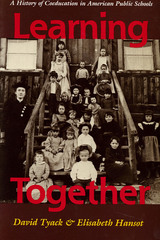 Learning Together: A History of Coeducation in American Public Schools
David Tyack
Russell Sage Foundation, 1992 Now available in paperback, this award-winning book provides a comprehensive history of gender policies and practices in American public schools. David Tyack and Elisabeth Hansot explore the many factors that have shaped coeducation since its origins. At the very time that Americans were creating separate spheres for adult men and women, they institutionalized an education system that brought boys and girls together. How did beliefs about the similarities and differences of boys and girls shape policy and practice in schools? To what degree did the treatment of boys and girls differ by class, race, region, and historical period? Debates over gender policies suggest that American have made public education the repository of their hopes and anxieties about relationships between the sexes. Thus, the history of coeducation serves as a window not only on constancy and change in gender practices in the schools but also on cultural conflicts about gender in the broader society. "Learning Together presents a rich and exhaustive search through [the] 'tangled history' of gender and education that links both the silences and the debates surrounding coeducation to the changing roles of women and men in our society....It is the generosity and capaciousness of Tyack and Hansot's scholarship that makes Learning Together so important a book." —Science
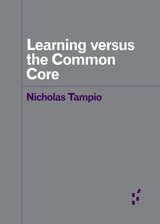 Learning versus the Common Core
Nicholas Tampio
University of Minnesota Press, 2019 An open challenge to Common Core’s drive for uniformity
Nicholas Tampio watched as his kindergartner’s class shifted from one where teachers, aides, parents, and students worked hard to create a rewarding educational experience to one in which teachers delivered hours-long lectures using packaged lesson plans. Learning versus the Common Core explains how standards-based education reform is transforming nearly every aspect of public education by looking closely at the standards, the agenda of people pushing standards-based reform, and how these fit within a global pattern of education reform. With a nod to the philosophy of John Dewey, Tampio concludes with a vision of what democratic education can look like today—and how people can form rhizomatic alliances across different political and ethical backgrounds to fight the Common Core.
Forerunners: Ideas First
Short books of thought-in-process scholarship, where intense analysis, questioning, and speculation take the lead
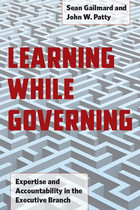 Learning While Governing: Expertise and Accountability in the Executive Branch
Sean Gailmard and John W. Patty
University of Chicago Press, 2013 Although their leaders and staff are not elected, bureaucratic agencies have the power to make policy decisions that carry the full force of the law. In this groundbreaking book, Sean Gailmard and John W. Patty explore an issue central to political science and public administration: How do Congress and the president ensure that bureaucratic agencies implement their preferred policies? The assumption has long been that bureaucrats bring to their positions expertise, which must then be marshaled to serve the interests of a particular policy. In Learning While Governing, Gailmard and Patty overturn this conventional wisdom, showing instead that much of what bureaucrats need to know to perform effectively is learned on the job. Bureaucratic expertise, they argue, is a function of administrative institutions and interactions with political authorities that collectively create an incentive for bureaucrats to develop expertise. The challenge for elected officials is therefore to provide agencies with the autonomy to do so while making sure they do not stray significantly from the administration’s course. To support this claim, the authors analyze several types of information-management processes. Learning While Governing speaks to an issue with direct bearing on power relations between Congress, the president, and the executive agencies, and it will be a welcome addition to the literature on bureaucratic development.
Learning Whiteness: Education and the Settler Colonial State
Arathi Sriprakash
Pluto Press, 2022 Whiteness is not innate – it is learned. The systems of white domination that prevail across the world are not pregiven or natural. Rather, they are forged and sustained in social and political life.
Learning Whiteness examines the material conditions, knowledge politics and complex feelings that create and relay systems of racial domination. Focusing on Australia, the authors demonstrate how whiteness is fundamentally an educational project – taught within education institutions and through public discourse – in active service of the settler colonial state.
To see whiteness as learned is to recognize that it can be confronted. This book invites readers to reckon with past and present politics of education in order to imagine a future thoroughly divested from racism.
Learning Whiteness: Education and the Settler Colonial State
Arathi Sriprakash
Pluto Press, 2022 Whiteness is not innate – it is learned. The systems of white domination that prevail across the world are not pregiven or natural. Rather, they are forged and sustained in social and political life.
Learning Whiteness examines the material conditions, knowledge politics and complex feelings that create and relay systems of racial domination. Focusing on Australia, the authors demonstrate how whiteness is fundamentally an educational project – taught within education institutions and through public discourse – in active service of the settler colonial state.
To see whiteness as learned is to recognize that it can be confronted. This book invites readers to reckon with past and present politics of education in order to imagine a future thoroughly divested from racism.
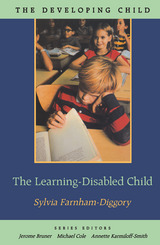 The Learning-Disabled Child: Second Edition
Sylvia Farnham-Diggory
Harvard University Press, 1992 Who is the learning-disabled child? As theories multiply and research accumulates, this pressing question persists, leaving parents and educators and, particularly, students at a loss. The Learning-Disabled Child does much toward providing an answer. A broad-based account of what is currently known and done about learning disabilities, the book gets at the roots of this perplexing problem—in the law, in the school system, and in the child—and offers a new outlook for its treatment.
Since the 1970s, millions of children have been misclassified by public schools as learning-disabled, while many others with true learning disabilities go unidentified and unhelped, as case material presented here makes poignantly clear. Over the same period, research on the nature of learning disabilities, based on samples of misclassified children, has yielded a cloudy and confusing picture. Drawing on her own background in cognitive, developmental, and abnormal psychology, as well as her research into reading and dyslexia, Sylvia Farnham-Diggory cuts through the confusion surrounding learning disabilities. She describes advanced research and clinical data that elucidate handicaps in reading, writing, spelling, drawing, calculation, remembering, and problem-solving. In addition, she outlines a straightforward assessment procedure that would reduce the misclassification of learning-disabled children and, if adopted by schools and private diagnostic services, would save the nation billions of misspent dollars.
Prescriptive as well as descriptive, The Learning-Disabled Child offers invaluable advice to parents seeking the best methods of diagnostic evaluation, and to teachers in search of the most effective means of helping these children. Far-reaching in its scope and firmly practical in its orientation, the book will prove instrumental in the identification, understanding, and treatment of learning disabilities.
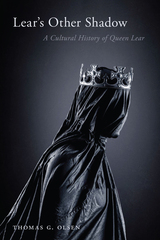 Lear’s Other Shadow: A Cultural History of Queen Lear
Thomas G. Olsen
University of Delaware Press, 2025 Lear’s Other Shadow: A Cultural History of Queen Lear offers a deep cultural analysis of the figure of Queen Lear, who shadows and eventually sometimes overshadows her royal husband across the nearly one-thousand-year life of this archetypal tale. What appears to be a deliberate strategy of suppression, even erasure in Shakespeare’s King Lear later inspired dozens of stage, page, and cinematic remakes and adaptations in which this figure is revived or remembered, often pointedly so. From Jacob Gordin’s Yiddish-language Miriele Efros (1898), through edgy stage remakes such as Gordon Bottomley’s King Lear’s Wife (1915) and the Women’s Theatre Group’s Lear’s Daughters (1987), to novelized retellings from Jane Smiley’s A Thousand Acres (1991) to Preti Taneja’s We That Are Young (2018) and J. R. Thorp’s Learwife (2021), and even the television series Empire (2015–2020) and Succession (2018–2023), Queen Lear regularly emerges from her shadowy origins to challenge how we understand the ancient King Leir/King Lear story. These and many other examples reveal fascinating patterns of adaptation and reinterpretation that Lear's Other Shadow identifies and analyzes for the first time, showing how and why Queen Lear is at the center of this ancient story, whether she is heard from or not.
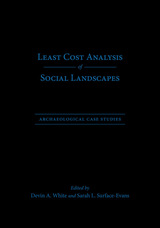 Least Cost Analysis of Social Landscapes: Archaeological Case Studies
Devin A. White
University of Utah Press, 2012 A growing number of archaeologists are applying Geographic Information Science (GIS) technologies to their research problems and questions. Advances in GIS and its use across disciplines allows for collaboration and enables archaeologists to ask ever more sophisticated questions and develop increasingly elaborate models on numerous aspects of past human behavior. Least cost analysis (LCA) is one such avenue of inquiry. While least cost studies are not new to the social sciences in general, LCA is relatively new to archaeology; until now, there has been no systematic exploration of its use within the field. This edited volume presents a series of case studies illustrating the intersection of archaeology and LCA modeling at the practical, methodological, and theoretical levels. Designed to be a guidebook for archaeologists interested in using LCA in their own research, it presents a wide cross-section of practical examples for both novices and experts. The contributors to the volume showcase the richness and diversity of LCA’s application to archaeological questions, demonstrate that even simple applications can be used to explore sophisticated research questions, and highlight the challenges that come with injecting geospatial technologies into the archaeological research process.
The Least of These
Todd Davis
Michigan State University Press, 2010 In his third collection of poems Todd Davis advises us that "the only corruption comes / in not loving this life enough." Over the course of this masterful and heartfelt book it becomes clear that Davis not only loves the life he's been given, but also believes that the ravishing desire of this world can offer hope, and even joy, however it might be negotiated.
Drawing upon a range of stories from the Christian, Transcendental, and Asian traditions, as well as from his own deep understanding of the natural world, Davis explores the connection between the visible and invisible worlds, or what Pierre Teilhard de Chardin called "the incandescent surface of matter plunged in God."
A direct poetic descendant of Walt Whitman, Davis invites us to sing "the songs we collect in the hymnals of our flesh- / impromptu, a cappella, our mouths flung open / in a great wide O."
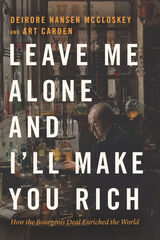 Leave Me Alone and I'll Make You Rich: How the Bourgeois Deal Enriched the World
Deirdre Nansen McCloskey and Art Carden
University of Chicago Press, 2020 The economist and historian Deirdre Nansen McCloskey has been best known recently for her Bourgeois Era trilogy, a vigorous defense, unrivaled in scope, of commercially tested betterment. Its massive volumes, The Bourgeois Virtues, Bourgeois Dignity, and Bourgeois Equality, solve Adam Smith’s puzzle of the nature and causes of the wealth of nations, and of the moral sentiments of modernity. The world got rich, she argues, not chiefly by material causes but by an idea and a sentiment, a new admiration for the middle class and its egalitarian liberalism.
For readers looking for a distillation of McCloskey’s magisterial work, Leave Me Alone and I’ll Make You Rich is what you’ve been waiting for. In this lively volume, McCloskey and the economist and journalist Carden bring together the trilogy’s key ideas and its most provocative arguments. The rise of the west, and now the rest, is the story of the rise of ordinary people to a dignity and liberty inspiring them to have a go. The outcome was an explosion of innovation after 1800, and a rise of real income by an astounding 3,000 percent. The Great Enrichment, well beyond the conventional Industrial Revolution, did not, McCloskey and Carden show, come from the usual suspects, capital accumulation or class struggle. It came from the idea of economic liberty in Holland and the Anglosphere, then Sweden and Japan, then Italy and Israel and China and India, an idea that bids fair in the next few generations to raise up the wretched of the earth. The original shift to liberalism arose from 1517 to 1789 from theological and political revolutions in northwest Europe, upending ancient hierarchies. McCloskey and Carden contend further that liberalism and “innovism” made us better humans as well as richer ones. Not matter but ideas. Not corruption but improvement.
Leave Me Alone and I’ll Make You Rich draws in entertaining fashion on history, economics, literature, philosophy, and popular culture, from growth theory to the Simpsons. It is the perfect introduction for a broad audience to McCloskey’s influential explanation of how we got rich. At a time when confidence in the economic system is under challenge, the book mounts an optimistic and persuasive defense of liberal innovism, and of the modern world it has wrought.
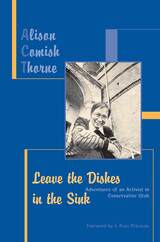 Leave The Dishes In The Sink
Alison Comish Thorne
Utah State University Press, 2002 Alison Thorne provides a small-town Utah perspective on the progressive social movements that in the mid to late twentieth century dramatically affected American society. A born activist, Thorne has fought for women's rights, educational reform in public schools and universities, the environment, peace, and the war on poverty. Her efforts have been all the more challenging because of the conservative social and cultural environment in which she has undertaken them. Yet, Thorne, who has deep personal and familial roots in the politically conservative and predominantly Mormon culture of Utah and much of the West, has worked well with people with varied political and social perspectives and agendas. She has been able to establish effective coalitions in contexts that seem inherently hostile. She demonstrated this through her election to the local school board and through her appointment by both Republican and Democratic governors, eventually as chair, to the statewide Governor's Committee on the Status of Women.
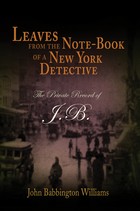 Leaves from the Note-Book of a New York Detective: The Private Record of J.B.
John Babbington Williams
Westholme Publishing, 2008 A welcome link to the chain connecting the early masters of detective fiction.... The collection offers a window into the early days of American detective fiction and the power of deductive thinking."—Sarah Weinman, Los Angeles Times "This story collection featuring New York City private detective James Brampton will intrigue Sherlock Holmes fans, given the number of eerie parallels between the two characters."—Publishers Weekly "It is the observation of small things that makes a good detective, for it is often the most trivial circumstance which supplies the first link in the chain." —James Brampton Twenty years before the Sherlock Holmes mysteries were written, a fictional New York private investigator was celebrated for his ability to solve crimes based on the principles of observation and deductive reasoning that later became Holmes' hallmark. Originally published in 1864 and never before reprinted, Leaves from the Note-Book of a New York Detective features twenty-nine cases of James Brampton, the first American detective hero to appear in fiction. The book opens with a chance meeting between a medical doctor, John Babbington Williams (the actual author of the stories), and detective James Brampton. They become acquaintances, and after Brampton has retired after twenty years of service, he sends his case notebooks to Dr. Williams to be edited and published. The result is a stunning collection of intriguing mysteries, including "The Defrauded Heir," "The Phantom Face," "A Satanic Compact," and "The Walker Street Tragedy." In case after case, using his power of observation, detective Brampton is able prove the innocence of the wrongly accused. Never before reprinted, this first modern edition of this important work now takes its place once more in the development of detective fiction between Edgar Allan Poe and Arthur Conan Doyle, the casebook of the original American detective hero.
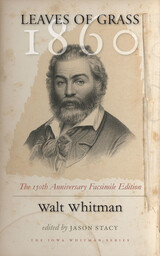 Leaves of Grass, 1860: The 150th Anniversary Facsimile Edition
Whitman, Walt
University of Iowa Press, 2009 In May 1860, Walt Whitman published a third edition of Leaves of Grass. His timing was compelling. Printed during a period of regional, ideological, and political divisions, written by a poet intimately concerned with the idea of a United States as “essentially the greatest poem,” this new edition was Whitman’s last best hope for national salvation. Now available in a facsimile edition, Leaves of Grass, 1860 faithfully reproduces Whitman’s attempt to create a “Great construction of the New Bible” to save the nation on the eve of civil war and, for the first time, frames the book in historical rather than literary terms. In his third edition, Whitman added 146 new poems to the 32 that comprised the second edition, reorganized the book into a bible of American civic religion that could be cited chapter and verse, and included erotic poetry intended to bind the nation in organic harmony. This 150th anniversary edition includes a facsimile reproduction of the original 1860 volume, a thought-provoking introduction by antebellum historian and Whitman scholar Jason Stacy that situates Whitman in nineteenth-century America, and annotations that provide detailed historical context for Whitman’s poems. A profoundly rich product of a period when America faced its greatest peril, this third edition finds the poet transforming himself into a prophet of spiritual democracy and the Whitman we celebrate today—boisterous, barbaric, and benevolent. Reprinting it now continues the poet’s goal of proclaiming for “the whole of America for each / individual, without exception . . . uncompromising liberty and equality.”
Leavetakings: Essays
Corinna Cook
University of Alaska Press, 2020 Leavetaking is an Alaska-based essay collection propelled by movements of departure and return. Corinna Cook asks: What can coming and going reveal about place? About how a place calls to us? About heeding that call? And might wandering serve not only to map new places but also to map the most familiar ones, like home? Departures and returns in these essays derive in large part from the narrator’s personal experiences of cross-continental travel by pickup truck and by airplane, human-powered expedition-style travel by kayak, regional travel by ferry, and her daily or local travel on foot. But the movement of coming and going at the heart of this collection exceeds the physical, for these essays are also intent on understanding spiritual and psychological pulses of proximity and distance in human connections to other people, their stories, and their homes.
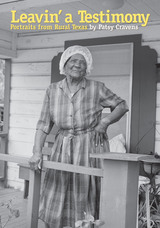 Leavin' a Testimony: Portraits from Rural Texas
By Patsy Cravens
University of Texas Press, 2006 First settled by Stephen F. Austin's colonists in the early nineteenth century, Colorado County has deep roots in Texas history. Mainly rural and agrarian until late in the twentieth century, Colorado County was a cotton-growing region whose population was about evenly divided between blacks and whites. These life-long neighbors led separate and unequal lives, memories of which still linger today. To preserve those memories, Patsy Cravens began interviewing and photographing the older residents of Colorado County in the 1980s. In this book, she presents photographs and recollections of the last generation, black and white, who grew up in the era of Jim Crow segregation. The folks in Colorado County have engrossing stories to tell. They recall grinding poverty and rollicking fun in the Great Depression, losing crops and livestock to floods, working for the WPA, romances gone wrong and love gone right, dirty dancing, church and faith, sharecropping, quilting, raising children, racism and bigotry, and even the horrific lynching of two African American teenagers in 1935. The Colorado County residents' stories reveal an amazing resiliency and generosity of spirit, despite the hardships that have filled most of their lives. They also capture a rural way of life that was once common across the South, but is now gone forever.
Leaving
Laton Carter
University of Chicago Press, 2004 Whether charting the moments before or after work, the unspoken emotions accompanying separation and reunion, or the necessity of a grocery store as a "last place" for people to engage publicly, Laton Carter's poems attend to the parts of our lives that are easiest to ignore, like solitary highway drivers passing in their cars and the unspoken link binding people together. In poem after poem, the speaker relentlessly pulls the reader to spaces, both physical and emotional—fearful of the inability to bridge the gap between ideas, places, and individuals, yet unable to avoid trying. Mining the territory of responsibility and longing, these poems remind us that the minutiae and variation in our private lives combine to serve up a larger public identity. An impressively mature first collection of poems, Leaving is a bold book that eschews the superfluous, leaving only that which is most essential and meaningful.
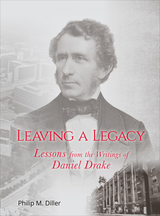 Leaving a Legacy: Lessons from the Writings of Daniel Drake
Philip Diller
University of Minnesota Press, 2019 In the midst of a fast-paced profession, it is increasingly a challenge to pause and reflect on where a person’s life is heading. All can feel overwhelming. In these moments, when nothing seems stable, it can be instructive to pause and study individuals from previous generations who lived fully and left a lasting legacy. To find valuable lessons and perspective on the present, author Dr. Phillip Diller has often turned to man, citizen, writer, educator, and physician, Dr. Daniel Drake, who lived from 1785-1852.
Leaving a Legacy: Lessons from the Writings of Daniel Drake is a selective collection of excerpts from the vast writings from the nineteenth-century doctor and medical pioneer Daniel Drake. From Drake’s life, documented here in his own words from excerpts of lectures, personal journal entries, presentations, speeches, books, and letters to his children, readers learn about the scope of his accomplishments in medicine, contributions to his community, and dedication to his family. Diller goes beyond biography to contextualize Drake’s life choices and what made him a role model for today’s physicians. Diller selected one hundred and eighty thematically arranged excerpts, which he paired with original reflection questions to guide the reader through thought-provoking prompts. In doing so, Diller presents the lessons from Drake’s remarkable life and work as a guide for others who wish to build an enduring legacy. Designed to appeal to early and mid-career professionals, particularly those in the medical field, Drake and Diller offer readers a way to enhance life with small actions that can leave a legacy in any community—professional or personal. Documented previously as a man whose life was remarkable for the breadth and depth of his professional accomplishments, Drake’s countless contributions are showcased here to demonstrate the impact he truly had in his time and for generations to come. Engaging with Drake and Diller’s thoughtful and principled voices provides a lasting perspective for those trying to find their purpose in the present.
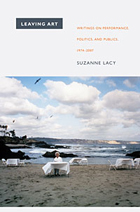 Leaving Art: Writings on Performance, Politics, and Publics, 1974-2007
Suzanne Lacy
Duke University Press, 2010 Since the 1970s, the performance and conceptual artist Suzanne Lacy has explored women’s lives and experiences, as well as race, ethnicity, aging, economic disparities, and violence, through her pioneering community-based art. Combining aesthetics and politics, and often collaborating with other artists and community organizations, she has staged large-scale public art projects, sometimes involving hundreds of participants. Lacy has consistently written about her work: planning, describing, and analyzing it; advocating socially engaged art practices; theorizing the relationship between art and social intervention; and questioning the boundaries separating high art from popular participation. By bringing together thirty texts that Lacy has written since 1974, Leaving Art offers an intimate look at the development of feminist, conceptual, and performance art since those movements’ formative years. In the introduction, the art historian Moira Roth provides a helpful overview of Lacy’s art and writing, which in the afterword the cultural theorist Kerstin Mey situates in relation to contemporary public art practices.
Leaving College: Rethinking the Causes and Cures of Student Attrition
Vincent Tinto
University of Chicago Press, 1994 In this 1994 classic work on student retention, Vincent Tinto synthesizes far-ranging research on student attrition and on actions institutions can and should take to reduce it. The key to effective retention, Tinto demonstrates, is in a strong commitment to quality education and the building of a strong sense of inclusive educational and social community on campus. He applies his theory of student departure to the experiences of minority, adult, and graduate students, and to the situation facing commuting institutions and two-year colleges. Especially critical to Tinto’s model is the central importance of the classroom experience and the role of multiple college communities.
 Leaving Fossil Fuels Underground: Actors, Arguments and Approaches in the Global South and Global North
Joyeeta Gupta
Amsterdam University Press, 2024 How can the world move away from a century-old global system based on fossil fuels? And how can societies in the Global South and Global North overcome the deeply vested economic, financial and political interests of the fossil fuel system? Despite the alarming effects of climate change and three decades of international climate negotiations, industrialized countries continue to exploit new fossil fuel reserves. Many countries in the Global South follow suit and still engage in large new fossil fuel projects and their related pollution, social injustice and debts. Increasingly, however, social and political actors are mobilising for leaving fossil fuels underground (LFFU).
This book examines the role of key actors, arguments and approaches in promoting the much-needed rapid phase-out of fossil fuels. It addresses the importance of linking effective climate action to socially and ecologically inclusive development. In addition to local resistance, the book explores initiatives for national and international policies and financial mechanisms carried out by actors ranging from social movements to governments and large investors.
In Leaving Fossil Fuels Underground, an international team of well-established scholars and early career researchers takes a global perspective to demonstrate the challenges and possibilities of reaching this goal. They pay special attention to Africa and Latin America, with case studies on South Africa and Ecuador.
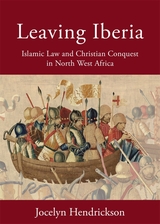 Leaving Iberia: Islamic Law and Christian Conquest in North West Africa
Jocelyn Hendrickson
Harvard University Press Leaving Iberia: Islamic Law and Christian Conquest in North West Africa examines Islamic legal responses to Muslims living under Christian rule in medieval and early modern Iberia and North Africa. The fall of al-Andalus, or reconquista, has long been considered a turning point, when the first substantial Muslim populations fell under permanent Christian rule. Yet a near-exclusive focus on conquered Iberian Muslims has led scholars to overlook a substantial body of legal opinions issued in response to Portuguese and Spanish occupation in Morocco itself, beginning in the early fifteenth century.
By moving beyond Iberia and following Christian conquerors and Muslim emigrants into North Africa, Leaving Iberia links the juristic discourses on conquered Muslims on both sides of the Mediterranean, critiques the perceived exceptionalism of the Iberian Muslim predicament, and adds a significant chapter to the story of Christian-Muslim relations in the medieval Mediterranean. The final portion of the book explains the disparate fates of these medieval legal opinions in colonial Algeria and Mauritania, where jurists granted lasting authority to some opinions and discarded others. Based on research in the Arabic manuscript libraries of five countries, Leaving Iberia offers the first fully annotated translations of the major legal texts under analysis.
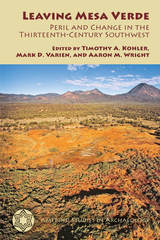 Leaving Mesa Verde: Peril and Change in the Thirteenth-Century Southwest
Edited by Timothy A. Kohler, Mark D. Varien, and Aaron M. Wright
University of Arizona Press, 2012 It is one of the great mysteries in the archaeology of the Americas: the depopulation of the northern Southwest in the late thirteenth-century AD. Considering the numbers of people affected, the distances moved, the permanence of the departures, the severity of the surrounding conditions, and the human suffering and culture change that accompanied them, the abrupt conclusion to the farming way of life in this region is one of the greatest disruptions in recorded history.
Much new paleoenvironmental data, and a great deal of archaeological survey and excavation, permit the fifteen scientists represented here much greater precision in determining the timing of the depopulation, the number of people affected, and the ways in which northern Pueblo peoples coped—and failed to cope—with the rapidly changing environmental and demographic conditions they encountered throughout the 1200s. In addition, some of the scientists in this volume use models to provide insights into the processes behind the patterns they find, helping to narrow the range of plausible explanations.
What emerges from these investigations is a highly pertinent story of conflict and disruption as a result of climate change, environmental degradation, social rigidity, and conflict. Taken as a whole, these contributions recognize this era as having witnessed a competition between differing social and economic organizations, in which selective migration was considerably hastened by severe climatic, environmental, and social upheaval. Moreover, the chapters show that it is at least as true that emigration led to the collapse of the northern Southwest as it is that collapse led to emigration.
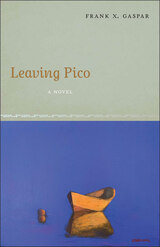 Leaving Pico: A Novel
Frank X. Gaspar
Tagus Press, 2022 Winner of the Barnes and Noble Discovery Prize Winner of the California Book Award for First Fiction A New York Times Notable Book In the insular Portuguese fishing community of Provincetown, Josie Carvalho’s life has been shaped by the annual influx of summer tourists and his great aunt’s fervent, if idiosyncratic, Catholicism. The counterweight to these forces has always been Josie’s relationship with his grandfather John Joseph, a drunk, clam-poaching old man who is nevertheless a sly and masterful storyteller. After a stranger starts dating Josie’s mother and upsets the family’s equilibrium, John Joseph heals the rift with the colorful and adventurous stories of their ancestor, Francisco Carvalho, a Portuguese explorer who just may have beaten Columbus to the New World. With the guidance of these obscure but inspired tales, Josie begins to find new ways of understanding his family and the outside world. This new edition of Leaving Pico makes Frank X. Gaspar’s award-winning coming-of-age novel accessible to a new generation of readers.
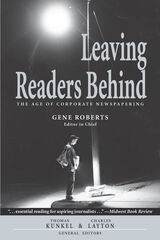 Leaving Readers Behind: The Age of Corporate Newspapering
Gene Roberts
University of Arkansas Press, 2001 The American newspaper industry is in the middle of the most momentous change in its entire three hundred-year history. A generation of relentless "corporatization" has resulted in a furious, unprecedented blitz of buying, selling, and consolidation of newspapers —affecting the mightiest dailies and the humblest weeklies. Accompanying this corporate jury has come dramatic—and drastic—change in reporting and coverage of all kinds. Concerned that this phenomenon was going largely unreported—and, therefore, unquestioned—Gene Roberts, legendary reporter and editor, decided to undertake a huge, extended reportorial study of his own industry. Gathering more than two dozen distinguished journalists and writers, Roberts produced a long series of reports in the American Journalism Review, published by the University of Maryland's Philip Merrill College of Journalism. This is the first of two books to be published exploring the current state of American newspaper and it asks the crucial question: Are American communities—in the very middle of the so-called Information Explosion—in danger of becoming less informed than ever?
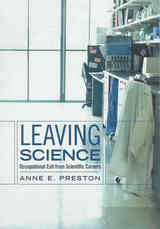 Leaving Science
Anne E. Preston
Russell Sage Foundation, 2004 The past thirty years have witnessed a dramatic decline in the number of U.S. students pursuing advanced degrees in science and an equally dramatic increase in the number of professionals leaving scientific careers. Leaving Science provides the first significant examination of this worrisome new trend. Economist Anne E. Preston examines a wide range of important questions: Why do professionals who have invested extensive time and money on a rigorous scientific education leave the field? Where do these scientists go and what do they do? What policies might aid in retaining and improving the quality of life for science personnel? Based on data from a large national survey of nearly 1,700 people who received university degrees in the natural sciences or engineering between 1965 and 1990 and a subsequent in-depth follow-up survey, Leaving Science provides a comprehensive portrait of the career trajectories of men and women who have earned science degrees. Alarmingly, by the end of the follow-up survey, only 51 percent of the original respondents were still working in science. During this time, federal funding for scientific research decreased dramatically relative to private funding. Consequently, the direction of scientific research has increasingly been dictated by market forces, and many scientists have left academic research for income and opportunity in business and industry. Preston identifies the main reasons for people leaving scientific careers as dissatisfaction with compensation and career advancement, difficulties balancing family and career responsibilities, and changing professional interests. Highlighting the difference between male and female exit patterns, Preston shows that most men left because they found scientific salaries low relative to perceived alternatives in other fields, while most women left scientific careers in response to feelings of alienation due to lack of career guidance, difficulty relating to their work, and insufficient time for their family obligations. Leaving Science contains a unique blend of rigorous statistical analysis with voices of individual scientists, ensuring a rich and detailed understanding of an issue with profound consequences for the nation's future. A better understanding of why professionals leave science can help lead to changes in scientific education and occupations and make the scientific workplace more attractive and hospitable to career men and women.
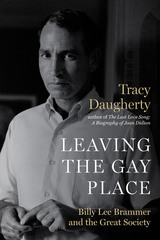 Leaving the Gay Place: Billy Lee Brammer and the Great Society
By Tracy Daugherty
University of Texas Press, 2018 Acclaimed by critics as a second F. Scott Fitzgerald, Billy Lee Brammer was once one of the most engaging young novelists in America. “Brammer’s is a new and major talent, big in scope, big in its promise of even better things to come,” wrote A. C. Spectorsky, a former staffer at the New Yorker. When he published his first and only novel, The Gay Place, in 1961, literary luminaries such as David Halberstam, Willie Morris, and Gore Vidal hailed his debut. Morris deemed it “the best novel about American politics in our time.” Halberstam called it “a classic . . . [a] stunning, original, intensely human novel inspired by Lyndon Johnson. . . . It will be read a hundred years from now.” More recently, James Fallows, Gary Fisketjon, and Christopher Lehmann have affirmed The Gay Place’s continuing relevance, with Lehmann asserting that it is “the one truly great modern American political novel.” Leaving the Gay Place tells a sweeping story of American popular culture and politics through the life and work of a writer who tragically exemplifies the highs and lows of the country at mid-century. Tracy Daugherty follows Brammer from the halls of power in Washington, DC, where he worked for Senate majority leader Johnson, to rock-and-roll venues where he tripped out with Janis Joplin, and ultimately to back alleys of self-indulgence and self-destruction. Constantly driven to experiment with new ways of being and creating—often fueled by psychedelics—Brammer became a cult figure for an America on the cusp of monumental change, as the counterculture percolated through the Eisenhower years and burst out in the sixties. In Daugherty’s masterful recounting, Brammer’s story is a quintessential American story, and Billy Lee is our wayward American son.
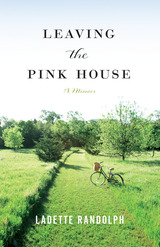 Leaving the Pink House
Ladette Randolph
University of Iowa Press, 2014 Ladette Randolph understands her life best through the houses she has inhabited. From the isolated farmhouse of her childhood, to the series of houses her family occupied in small towns across Nebraska as her father pursued his dream of becoming a minister, to the equally small houses she lived in as a single mother and graduate student, houses have shaped her understanding of her place in the world and served as touchstones for a life marked by both constancy and endless cycles of change.
On September 12, 2001, Randolph and her husband bought a dilapidated farmhouse on twenty acres outside Lincoln, Nebraska, and set about gutting and rebuilding the house themselves. They had nine months to complete the work. The project, undertaken at a time of national unrest and uncertainty, led Randolph to reflect on the houses of her past and the stages of her life that played out in each, both painful and joyful. As the couple struggles to bring the dilapidated house back to life, Randolph simultaneously traces the contours of a life deeply shaped by the Nebraska plains, where her family has lived for generations, and how those roots helped her find the strength to overcome devastating losses as a young adult. Weaving together strands of departures and arrivals, new houses and deep roots, cycles of change and the cycles of the seasons, Leaving the Pink House is a richly layered and compelling memoir of the meaning of home and family, and how they can never really leave us, even if we leave them.
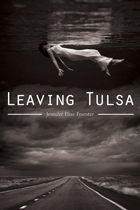 Leaving Tulsa
Jennifer Elise Foerster
University of Arizona Press, 2013 In her first magical collection of poetry, Jennifer Elise Foerster weaves together a mythic and geographic exploration of a woman’s coming of age in a dislocated time. Leaving Tulsa, a book of road elegies and laments, travels from Oklahoma to the edges of the American continent through landscapes at once stark and lush, ancient and apocalyptic. The imagery that cycles through the poems—fire, shell, highway, wing—gives the collection a rich lyrical-dramatic texture. Each poem builds on a theme of searching for a lost “self”—an “other” America—that crosses biblical, tribal, and ecological mythologies. In Leaving Tulsa, Foerster is not afraid of the strange or of estrangement. The narrator occupies a space in between and navigates the offbeat experiences of a speaker that is of both Muscogee and European heritage. With bold images and candid language, Foerster challenges the perceptions of what it means to be Native, what it means to be a woman, and what it means to be an American today. Ultimately, these brave and luminous poems engage and shatter the boundaries of time, self, and continent. Foerster’s journey transcends both geographic space and the confines of the page to live vividly in the mind of the reader.
The Leavitt Site: A Parkhill Phase Paleo-Indian Occupation in Central Michigan
Michael J. Shott, with a foreword by Henry T. Wright
University of Michigan Press, 1993 This illustrated monograph is an innovative analysis of forager archaeology in general and Paleo-Indian studies in particular. This is a companion volume to Thedford II: A Paleo-Indian Site in the Ausable River Watershed of Southwestern Ontario (Memoir 24).
Lebanese Blonde
Joseph Geha
University of Michigan Press, 2012 Lebanese Blondetakes place in 1975-76 at the beginning of Lebanon's sectarian civil war. Set primarily in the Toledo, Ohio, "Little Syria" community, it is the story of two immigrant cousins: Aboodeh, a self-styled entrepreneur; and Samir, his young, reluctant accomplice. Together the two concoct a scheme to import Lebanese Blonde, a potent strain of hashish, into the United States, using the family's mortuary business as a cover. When Teyib, a newly arrived war refugee, stumbles onto their plans, his clumsy efforts to gain acceptance raise suspicion. Who is this mysterious "cousin," and what dangers does his presence pose? Aboodeh and Samir's problems grow still more serious when a shipment goes awry and their links to the war-ravaged homeland are severed. Soon it's not just Aboodeh and Samir's livelihoods and futures that are imperiled, but the stability of the entire family.
Lebanese Salafis between the Gulf and Europe: Development, Fractionalization and Transnational Networks of Salafism in Lebanon
Zoltan Pall
Amsterdam University Press, 2013 Salafism is one of the most dynamic and rapidly growing Islamic movements and it is impossible to understand contemporary Islam without taking account of it. The movement has reached almost every corner of the Muslim world, and its transnational networks span the globe. Despite the importance of Salafism, scholars have only recently begun to pay serious attention to the movement, and while the body of literature on Salafism is growing, there are still many lacunae. The Lebanese context adopted by the author of this important study provides an excellent opportunity to explore the dynamics of the Salafi movement worldwide.
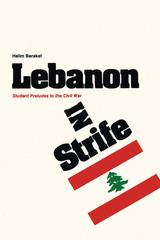 Lebanon in Strife: Student Preludes to the Civil War
By Halim Barakat
University of Texas Press, 1977 In this study, an eminent sociologist of the Arab world analyzes student politics in Lebanon and their relationship to the civil war. This focus is part of a larger concern with upheaval in Arab society and with political and social integration in mosaic societies in general. Professor Barakat provides a clear, thorough, and comprehensive analysis of late twentieth century Lebanese society and the dominant ideological veins within it. Lebanon in Strife is a comparative study of Lebanese youth with special emphasis on their alienation from society and politics and their place at the vanguard of social change. The study is set in the context of the continual confrontation between forces for change and the established order in Lebanon, viewed from both a local and an international perspective. The author argues that vertical loyalties (based on religious, ethnic, or regional ties) are more significant than horizontal loyalties (based on socioeconomic class) in determining Lebanese student political behavior and attitudes. However, vertical loyalties are explained in socioeconomic terms, for the two forms of cleavages coincide; and the whole society is composed of religious communities arranged in a hierarchy of power and status. The author shows that these ties conflict with and undermine orderly social change and national unity and that they could account for conditions that have led to civil war in Lebanon. In an epilogue, Professor Barakat relates his analysis of student politics to political developments in Lebanon during the civil war of 1975–1976, including an assessment of the role of Syria and the prospects for a negotiated end to armed struggle in the country. This is the first empirical study of Lebanese political life viewed from the standpoint of its central force for change, the students. It is an invaluable resource for students of the modem Middle East as well as for specialists in sociology, politics, and history. Lebanon in Strife has special relevance to problems of political change and development in the Third World countries, providing a sociopolitical model for the analysis of student politics in traditional and transitional societies.
The Lecherous Professor: Sexual Harassment on Campus
Billie Wright Dziech and Linda Weiner
University of Illinois Press, 1990 How does society view and define sexual harassment of students by academicians? Does the collegiate environment exacerbate the problem and contribute to its current epidemic proportions? What can students, faculty, and administrators do about the problem? The Lecherous Professor addresses these timely issues, including the dilemma of teacher-student dating, newly devised policy statements on sexual harassment from several institutions, and faculty uneasiness about administrative directives on sexual harassment.
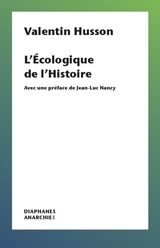 L’Écologique de l’Histoire
Valentin Husson
Diaphanes, 2020 Il y a plaisir à saluer l‘arrivée d’un philosophe tout neuf qui soudain bondit dans le cortège dionysiaque. Plus on est de fous, plus on pense, le proverbe dit vrai et notre temps de misère a plus que besoin de se refaire – s’il se peut – une vigueur spéculative. Il y a plus que du plaisir, une vraie jubilation lorsque le tout neuf philosophe affirme une pensée de la jouissance, de l’abondance et de la dépense au sens de Bataille (ici toujours discrètement mais efficacement présent). Une pensée énergique au sens le plus – oserais-je dire « vitalisant » du terme. L’energeia n’a-t-elle de sens que depuis l’être ? N’y a-t-il pas une autre énergie à penser ? Une énergie non pas de l’être, ni relative à celle extraite de la nature pour des fins productives et économiques, mais une énergie excédentaire, une sorte de « dépense improductive » (Bataille) de la vie ? Une énergie qui serait le luxe biologique du vivant. Ce luxe biologique, Valentin Husson le pense comme – on ne peut plus dire « ontologique » – comme existence en un sens qui se dérobe à Heidegger et à son « sens de l’être » pour affirmer un avoir à être selon lequel l’être se dissipe au-delà de toute consistance tandis que l’avoir à prend toute l’énergie d’une vie en débordante envie d’elle-même. Jean-Luc Nancy
Lectures and Essays in Criticism: The Complete Prose Works of Matthew Arnold
Matthew Arnold; Edited by R. H. Super
University of Michigan Press, 1962 The Essays in Criticism is the basis of Arnold's high reputation as critic of literature. The range of subject—from the classical humor of Theocritus and the serious morality of Marcus Aurelius to the romantic religious struggles of Maurice de Guerin and the sober piety of his sister—gives scope for all Arnold's skill."The Function of Criticism at the Present Time" lays down wittily and urbanely doctrines which have shaped literary criticism for a century. Here too are his devastating attacks on the Biblical criticism of Bishop Conlenso, his needle pricks at the complacent politicians, and his sensitive analysis of the "natural magic" of English poetry.
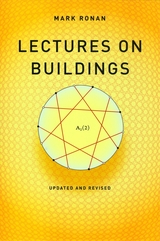 Lectures on Buildings: Updated and Revised
Mark Ronan
University of Chicago Press, 2009 In mathematics, “buildings” are geometric structures that represent groups of Lie type over an arbitrary field. This concept is critical to physicists and mathematicians working in discrete mathematics, simple groups, and algebraic group theory, to name just a few areas. Almost twenty years after its original publication, Mark Ronan’s Lectures on Buildings remains one of the best introductory texts on the subject. A thorough, concise introduction to mathematical buildings, it contains problem sets and an excellent bibliography that will prove invaluable to students new to the field. Lectures on Buildings will find a grateful audience among those doing research or teaching courses on Lie-type groups, on finite groups, or on discrete groups. “Ronan’s account of the classification of affine buildings [is] both interesting and stimulating, and his book is highly recommended to those who already have some knowledge and enthusiasm for the theory of buildings.”—Bulletin of the London Mathematical Society
Lectures on Deixis
Charles Fillmore
CSLI, 1997 This volume presents Charles Fillmore's view of the scope of linguistic description, insofar as the field of linguistics touches on questions of the meanings of sentences. Fillmore takes the subject matter of linguistics, in its grammatical, semantic, and pragmatic sub-divisions, to include the full catalog of knowledge that the speakers of a language can be said to possess about the structure of the sentences in their language, and their knowledge about the appropriate use of these sentences. The special explanatory task of linguistics, Fillmore argues, is to discover the principles that underlie such knowledge. He chooses to study the range of information which the speakers of a language possess about the sentences in their language by thoroughly examining one simple English sentence.
 Lectures on Economic Growth
Robert E. Lucas Jr.
Harvard University Press, 2004 In this book the Nobel Prize-winning economist Robert Lucas collects his writings on economic growth, from his seminal On the Mechanics of Economic Development to his previously unpublished 1997 Kuznets Lectures.
The chapters progress from a general theory of how growth could be sustained and why growth rates might differ in different countries, to a model of exceptional growth in certain countries in the twentieth century, to an account of the take-off of growth in the Industrial Revolution, and finally to a prediction about patterns of growth in this new century. The framework in all the chapters is a model with accumulation of both physical and human capital, with emphasis on the external benefits of human capital through diffusion of new knowledge or on-the-job learning, often stimulated by trade. The Kuznets Lectures consider the interaction of human capital growth and the demographic transition in the early stages of industrialization. In the final chapter, Lucas uses a diffusion model to illustrate the possibility that the vast intersociety income inequality created in the course of the Industrial Revolution may have already reached its peak, and that income differences will decline in this century.
Lectures on Ethics, 1900 - 1901: John Dewey
Donald F. Koch
Southern Illinois University Press, 1991 In Lectures on Ethics, 1900–1901,Donald F. Koch supplies the only extant complete transcription of the annual three-course sequence on ethics John Dewey gave at the University of Chicago. In his introduction Koch argues that these lectures offer the best systematic, overall introduction to Dewey’s approach to moral philosophy and are the only account showing the unity of his views in nearly all phases of ethical inquiry. These lectures are the only work by Dewey to set forth a complete theory of moral language. They offer a clear illustration of the central methodological questions in the development of a pragmatic instrumentalist ethic and the actual working out of the instrumentalist approach as distinct from simply presenting it as a conclusion.
Lectures on Exceptional Lie Groups
J. F. Adams
University of Chicago Press, 1996 J. Frank Adams was internationally known and respected as one of the great algebraic topologists. Adams had long been fascinated with exceptional Lie groups, about which he published several papers, and he gave a series of lectures on the topic. The author's detailed lecture notes have enabled volume editors Zafer Mahmud and Mamoru Mimura to preserve the substance and character of Adams's work.
Because Lie groups form a staple of most mathematics graduate students' diets, this work on exceptional Lie groups should appeal to many of them, as well as to researchers of algebraic geometry and topology.
J. Frank Adams was Lowndean professor of astronomy and geometry at the University of Cambridge. The University of Chicago Press published his Lectures on Lie Groups and has reprinted his Stable Homotopy and Generalized Homology.
Chicago Lectures in Mathematics Series
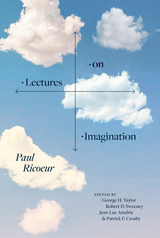 Lectures on Imagination
Paul Ricoeur
University of Chicago Press, 2024 Ricoeur’s theory of productive imagination in previously unpublished lectures.
The eminent philosopher Paul Ricoeur was devoted to the imagination. These previously unpublished lectures offer Ricoeur’s most significant and sustained reflections on creativity as he builds a new theory of imagination through close examination, moving from Aristotle, Pascal, Spinoza, Hume, and Kant to Ryle, Price, Wittgenstein, Husserl, and Sartre. These thinkers, he contends, underestimate humanity’s creative capacity. While the Western tradition generally views imagination as derived from the reproductive example of the image, Ricoeur develops a theory about the mind’s power to produce new realities. Modeled most clearly in fiction, this productive imagination, Ricoeur argues, is available across conceptual domains. His theory provocatively suggests that we are not constrained by existing political, social, and scientific structures. Rather, our imaginations have the power to break through our conceptual horizons and remake the world.
Lectures on Kant's Political Philosophy
Hannah Arendt
University of Chicago Press, 1982 Hannah Arendt's last philosophical work was an intended three-part project entitled The Life of the Mind. Unfortunately, Arendt lived to complete only the first two parts, Thinking and Willing. Of the third, Judging, only the title page, with epigraphs from Cato and Goethe, was found after her death. As the titles suggest, Arendt conceived of her work as roughly parallel to the three Critiques of Immanuel Kant. In fact, while she began work on The Life of the Mind, Arendt lectured on "Kant's Political Philosophy," using the Critique of Judgment as her main text. The present volume brings Arendt's notes for these lectures together with other of her texts on the topic of judging and provides important clues to the likely direction of Arendt's thinking in this area.
Lectures on Lie Groups
J. F. Adams
University of Chicago Press, 1983 "[Lectures in Lie Groups] fulfills its aim admirably and should be a useful reference for any mathematician who would like to learn the basic results for compact Lie groups. . . . The book is a well written basic text [and Adams] has done a service to the mathematical community."—Irving Kaplansky
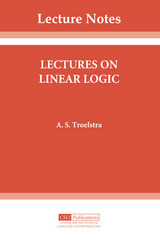 Lectures on Linear Logic
A. S. Troelstra
CSLI, 1992 Linear logic is an example of a "resource-sensitive" logic, keeping track of the number of times data of given types are used. Formulas in linear logic represent either the data themselves or data types, whereas in ordinary logic a formula is a proposition. If ordinary logic is a logic of truth, linear logic is a logic of actions.
Linear logic and its implications are explored in depth in this volume. Particular attention has been given to the various formalisms for linear logic, embeddings of classical and intuitionistic logic into linear logic, the connection with certain types of categories, the "formulas-as-types" paradigm for linear logic and associated computational interpretations, and Girard's proof nets for classical linear logic as an analogue of natural deduction. It is also shown that linear logic is undecidable. A final section, contributed by D. Roorda, presents a proof of strong normalization for cut elimination in linear logic.
Linear logic is of interest to logicians and computer scientists, and shows links with many other topics, such as coherence theorems in category theory, the theory of Petri nets, and abstract computing machines without garbage collection
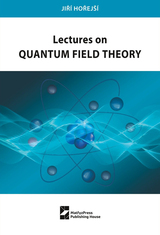 Lectures on Quantum Field Theory
Jirí Horejší
Karolinum Press, 2024 Twenty years of lectures on the quantum world by an esteemed physicist.
This book covers the material of the two-semester quantum field theory course that Jirí Horejší has taught at Charles University and Czech Technical University in Prague for over two decades. In the individual chapters, one may find the discussion of selected topics in relativistic quantum mechanics and relativistic quantum field theory; the dominant theme is quantum electrodynamics. The technique of Feynman diagrams is described in detail, along with methods of regularization and renormalization, including some basic applications.
The selection of topics presented in the book is intended to provide the reader with the technical skills necessary for the subsequent study of theoretical particle physics. In keeping with the author’s typical lecture style, the text contains many detailed explicit calculations to a degree not entirely typical in other available sources. With primary appeal for university students specializing in theoretical physics or nuclear and particle physics, it may also be useful for any scientifically minded reader seriously interested in the foundations of modern physics.
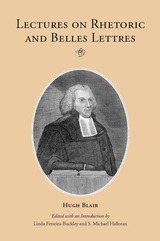 Lectures on Rhetoric and Belles Lettres
Hugh Blair. Edited by Linda Ferreira-Buckley and S. Michael Halloran
Southern Illinois University Press, 2005 This new edition of Hugh Blair’s Lectures on Rhetoric and Belles Lettres, edited by Linda Ferreira-Buckley and S. Michael Halloran, answers the need for a complete, reliable text. The book seeks to generate a renewed interest in Blair by provoking new inquiries into the tradition of belletristic rhetoric and by serving as both aid and incentive to others who may join in the project of improving understanding of this landmark rhetorical scholarship. This editioncontains forty-seven lectures and remains faithful to the text of the 1785 London edition. The editors contextualize Hugh Blair’s motivations and thinking by providing in their introduction an extended account of Blair’s life and era. The bibliography of works by and about Blair is an invaluable aid, surpassing previous research on Blair. Although the extent of its influence cannot be measured fully, Blair’s Lectures on Rhetoric and Belles Lettres was undoubtedly a primary vehicle for introducing many eighteenth- and nineteenth-century scholars to classical rhetoric and French belletristic rhetoric—its success due in part to the ease with which the lectures combine neoclassical and Enlightenment thought, accommodating emerging social concerns. Ferreira-Buckley and Halloran’s extensive treatment revives the tradition of belletristic rhetoric, improving the understanding of Blair’s place in the study of eighteenth- and nineteenth-century discourse, while finding him relevant in the twenty-first century.
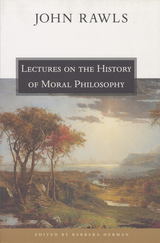 Lectures on the History of Moral Philosophy
John Rawls
Harvard University Press, 2000 The premier political philosopher of his day, John Rawls, in three decades of teaching at Harvard, has had a profound influence on the way philosophical ethics is approached and understood today. This book brings together the lectures that inspired a generation of students--and a regeneration of moral philosophy. It invites readers to learn from the most noted exemplars of modern moral philosophy with the inspired guidance of one of contemporary philosophy's most noteworthy practitioners and teachers.
Central to Rawls's approach is the idea that respectful attention to the great texts of our tradition can lead to a fruitful exchange of ideas across the centuries. In this spirit, his book engages thinkers such as Leibniz, Hume, Kant, and Hegel as they struggle in brilliant and instructive ways to define the role of a moral conception in human life. The lectures delineate four basic types of moral reasoning: perfectionism, utilitarianism, intuitionism, and--the ultimate focus of Rawls's course--Kantian constructivism. Comprising a superb course on the history of moral philosophy, they also afford unique insight into how John Rawls has transformed our view of this history.
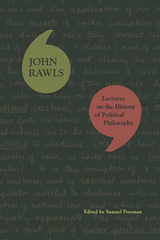 Lectures on the History of Political Philosophy
John Rawls
Harvard University Press, 2007 This last book by the late John Rawls, derived from written lectures and notes for his long-running course on modern political philosophy, offers readers an account of the liberal political tradition from a scholar viewed by many as the greatest contemporary exponent of the philosophy behind that tradition.
Rawls's goal in the lectures was, he wrote, "to identify the more central features of liberalism as expressing a political conception of justice when liberalism is viewed from within the tradition of democratic constitutionalism." He does this by looking at several strands that make up the liberal and democratic constitutional traditions, and at the historical figures who best represent these strands--among them the contractarians Hobbes, Locke, and Rousseau; the utilitarians Hume, Sidgwick, and J. S. Mill; and Marx regarded as a critic of liberalism. Rawls's lectures on Bishop Joseph Butler also are included in an appendix. Constantly revised and refined over three decades, Rawls's lectures on these figures reflect his developing and changing views on the history of liberalism and democracy--as well as how he saw his own work in relation to those traditions.
With its clear and careful analyses of the doctrine of the social contract, utilitarianism, and socialism--and of their most influential proponents--this volume has a critical place in the traditions it expounds. Marked by Rawls's characteristic patience and curiosity, and scrupulously edited by his student and teaching assistant, Samuel Freeman, these lectures are a fitting final addition to his oeuvre, and to the history of political philosophy as well.
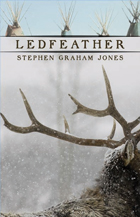 Ledfeather
Stephen Graham Jones
University of Alabama Press, 2008 A story of life, death, love, and the ties that bind us not only to what has been, but what will be After burning up the blacktop in New Mexico with The Fast Red Road and rewriting Indian history on the Great Plains with The Bird is Gone, Stephen Graham Jones now takes us to Montana. Set on a Blackfeet Indian reservation, Ledfeather lays bare the life of one Indian boy, Doby Saxon: his near-death experience, his suicide attempts, his brief glimpse of victory, and the unnecessary death of one of his best friends. But through Doby emerges a connection to the past, to an Indian Agent who served the United States government over a century before. This revelation leads to another and another until it becomes clear that the decisions of this single Indian agent have impacted the lives of generations of Blackfeet Indians—and the life of Doby Saxon, a boy standing in the middle of the road at night, his hands balled into fists, the reservation wheeling all around him like the whole of Blackfeet history collapsing in on him. Jones’s beautifully complex novel is a story of life, death, love, and the ties that bind us not only to what has been, but what will be: the power of one moment, the weight of one decision, the inevitability of one outcome, and the price of one life.
Ledger
Wheeler, Susan
University of Iowa Press, 2005 The many meanings of “economy” are the ground for the mediation and lament of Ledger, Susan Wheeler’s fourth book. In its Greek origins, economy referred to the stewardship of a household and, as it developed, the word also came to include aspects of government and of religious faith. Ledger places an individual’s crisis of spirituality and personal stewardship, or management of her resources, against a backdrop of a culture that has focused its “economy” on financial gain and has misspent its own tangible and intangible resources.
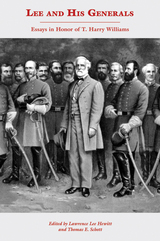 Lee and His Generals: Essays in Honor of T. Harry Williams
Lawrence L. Hewitt
University of Tennessee Press, 2012
A legendary professor at Louisiana State University, T. Harry Williams not only produced such acclaimed works as Lincoln and the Radicals, Lincoln and His Generals, and a biography of Huey Long that won both the Pulitzer Prize and the National Book Award, but he also mentored generations of students who became distinguished historians in their own right. In this collection, ten of those former students, along with one author greatly inspired by Williams’s example, offer incisive essays that honor both Williams and his career-long dedication to sound, imaginative scholarship and broad historical inquiry.
The opening and closing essays, fittingly enough, deal with Williams himself: a biographical sketch by Frank J. Wetta and a piece by Roger Spiller that place Williams in larger historical perspective among writers on Civil War generalship. The bulk of the book focuses on Robert E. Lee and a number of the commanders who served under him, starting with Charles Roland’s seminal article “The Generalship of Robert E. Lee,” the only one in the collection that has been previously published. Among the essays that follow Roland’s are contributions by Brian Holden Reid on the ebb and flow of Lee’s reputation, George C. Rable on Stonewall Jackson’s deep religious commitment, A. Wilson Greene on P. G. T. Beauregard’s role in the Petersburg Campaign, and William L. Richter on James Longstreet as postwar pariah.
Together these gifted historians raise a host of penetrating and original questions about how we are to understand America’s defining conflict in our own time—just as T. Harry Williams did in his. And by encompassing such varied subjects as military history, religion, and historiography, Lee and His Generals demonstrates once more what a fertile field Civil War scholarship remains.
Lawrence Lee Hewitt is professor of history emeritus at Southeastern Louisiana University. Most recently, he and Arthur W. Bergeron, now deceased, coedited three volumes of essays under the collective title Confederate Generals in the Western Theater.
Thomas E. Schott served for many years as a historian for the U.S. Air Force and U.S. Special Operations Command. He is the author of Alexander H. Stephens of Georgia: A Biography, which won both the Society of American Historians Award and the Jefferson Davis Award.
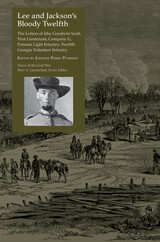 Lee and Jackson's Bloody Twelfth: The Letters of Irby Goodwin Scott, First Lieutenant, Company G, Putnam Light Infantry, Twelfth Georgia Volunteer Infantry
Johnnie Perry Pearson
University of Tennessee Press, 2012
Offering a fascinating look at an ordinary soldier's struggle to survive not only the horrors of combat but also the unrelenting hardship of camp life, Lee and Jackson's Bloody Twelfth brings together for the first time the extant correspondence of Confederate lieutenant Irby Goodwin Scott, who served in the hard-fighting Twelfth Georgia Infantry.
The collection begins with Scott's first letter home from Richmond, Virginia, in June 1861, and ends with his last letter to his father in February 1865. Scott miraculously completed the journey from naïve recruit to hardened veteran while seeing action in many of the Eastern Theater's most important campaigns: the Shenandoah Valley, the Peninsula, Second Manassas, and Gettysburg. His writings brim with vivid descriptions of the men's activities in camp, on the march, and in battle. Particularly revelatory are the details the letters provide about the relationship between Scott and his two African American body servants, whom he wrote about with great affection. And in addition to maps, photographs, and a roster of Scott's unit, the book also features an insightful introduction by editor Johnnie Perry Pearson, who highlights the key themes found throughout the correspondence.
By illuminating in depth how one young Confederate stood up to the physical and emotional duress of war, the book stands as a poignant tribute to the ways in which all ordinary Civil War soldiers, whether fighting for the South or the North, sacrificed, suffered, and endured.
Johnnie Perry Pearson is a retired state service officer formerly with the North Carolina Division of Veteran Affairs. He served as an infantry platoon sergeant during the Vietnam War and lives in Hickory, North Carolina.
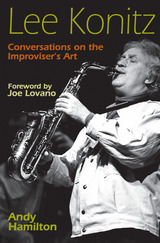 Lee Konitz: Conversations on the Improviser's Art
Andy Hamilton
University of Michigan Press, 2007 “Meticulously researched, detailed and documented, this long awaited overview justly establishes Konitz as one of the most consistently brilliant, adventurous and original improvisers in the jazz tradition—a genius as rare as Bird himself.” —John Zorn “Hamilton’s work may well mark the inception of a format new to writing on Western music, one which avoids both the self-aggrandizing of autobiography and the stylized subjectification of biography.” —The Wire “An extraordinary approach to a biography, with the man himself speaking for extended sessions. The main vibration I felt from Lee’s words was total honesty, almost to a fault. Konitz shows himself to be an acute observer of the scene, full of wisdom and deep musical insights, relevant to any historical period regardless of style. The asides by noted musicians are beautifully woven throughout the pages. I couldn’t put the book down—it is the definition of a living history.” —David Liebman The preeminent altoist associated with the “cool” school of jazz, Lee Konitz was one of the few saxophonists of his generation to forge a unique sound independent of the influence of Charlie Parker. In the late 1940s, Konitz began his career with the Claude Thornhill band, during which time he came into contact with Miles Davis, with whom he would later work on the legendary Birth of the Cool sessions. Konitz is perhaps best known through his association with Lennie Tristano, under whose influence much of his sound evolved, and for his work with Stan Kenton and Warne Marsh. His recordings have ranged from cool bop to experimental improvisation and have appeared on such labels as Prestige, Atlantic, Verve, and Polydor. Crafted out of numerous interviews between the author and his subject, the book offers a unique look at the story of Lee Konitz’s life and music, detailing Konitz’s own insights into his musical education and his experiences with such figures as Miles Davis, Stan Kenton, Warne Marsh, Lennie Tristano, Charles Mingus, Bud Powell, and Bill Evans. Andy Hamilton is a jazz pianist and contributor to major jazz and contemporary music magazines. He teaches philosophy, and the history and aesthetics of jazz, at Durham University in the United Kingdom. He is also the author of the book Aesthetics and Music (Continuum 2007). Joe Lovano is a Grammy Award–winning tenor saxophonist. His most recent album is Streams of Expression.
 Lee Kuan Yew: The Beliefs Behind the Man
Michael D. Barr
Georgetown University Press, 2000 Lee Kuan Yew, Singapore's first prime minister (from 1959 to1990), has been an international figure not only for establishing Singapore's political and economic stability but also for fostering economic development throughout Asia. He is particularly renowned as a principle architect of the 'Asian values' campaign of the 1990s, which sought to preserve the undemocratic traits of Asian culture while attending to the demands of a capitalist economy operating globally. A critical examination of Lee's life, career, and ideas, this is the first book to analyze the origins and substance of Lee's political thought. Augmenting established primary sources with his own interviews and correspondence with Lee's old associates, Barr shows how Lee has been influenced by British and Chinese racism and elitism, western progressivism, and even the cultural evolutionism of Arnold Toynbee. This reassessment of Lee's achievements and worldview sheds new light on a key figure on the world stage.
Lee Miller: A Life
Carolyn Burke
University of Chicago Press, 2007 Lee Miller’s life embodied all the contradictions and complications of the twentieth century: a model and photographer, muse and reporter, sexual adventurer and domestic goddess, she was also America's first female war correspondent. Carolyn Burke, a biographer and art critic, here reveals how the muse who inspired Man Ray, Cocteau, and Picasso could be the same person who unflinchingly photographed the horrors of Buchenwald and Dachau. Burke captures all the verve and energy of Miller’s life: from her early childhood trauma to her stint as a Vogue model and art-world ingénue, from her harrowing years as a war correspondent to her unconventional marriages and passion for gourmet cooking. A lavishly illustrated story of art and beauty, sex and power, Modernism and Surrealism, Lee Miller illuminates an astonishing woman’s journey from art object to artist.
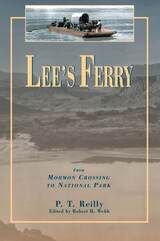 Lee's Ferry: From Mormon Crossing to National Park
P. T. Reilly and Robert H. Webb
Utah State University Press, 1999 The Colorado River and its deeply entrenched canyons create a lengthy barrier to travel in the interior West. Here and there, ancient Indian foot trails descend canyon walls and find access to the river, but one of the few places between California and Nevada where wheeled vehicles can approach it is at the mouth of the Pahreah River, between Glen Canyon and the river's steep drop toward Grand Canyon. Here, from the mid-19th until well into the 20th century, Lee's Ferry was a primary link between Utah and Arizona. Mormons trying to reach potential Indian converts and new lands for colonization to the south first developed the site. John D. Lee and parts of his family, seeking an inconspicuous spot after the Mountain Meadows massacre, first took up residence at what they called Lonely Dell. In subsequent decades, many interesting and important western characters passed through this topographical and historical funnel, from John Wesley Powell to Buffalo Bill. As river exploration and adventure increased, the place became as important to those using the river-surveyors, miners, river runners-as to folks crossing it. In recognition of its importance, Lee's Ferry has been partially restored as a historic site in the national park system. P. T. Reilly, himself a legend on the river as boatman and chronicler, wrote the detailed and colorful history this place demanded, focusing on stories of the hodgepodge of people it attracted. He died before he finished reworking his massive narrative into book form, but Robert H. Webb, author of Grand Canyon: A Century of Change, completed that job and selected rare historical photos from the Reilly collection at Northern Arizona University to illustrate it. An epilogue by Richard Quartaroli provides a biographical sketch of P. T. Reilly.
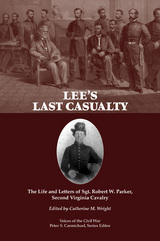 Lee's Last Casualty: The Life and Letters of Sgt. Robert W. Parker, Second Virginia Cavalry
Catherine M. Wright
University of Tennessee Press, 2012 The letters assembled in this extraordinarily rich collection were written by Robert W. Parker, an enlisted Confederate cavalryman who is thought to have been the last man killed in action in the Army of Northern Virginia during the Civil War. He is representative of the Confederate Everyman: a modest farmer in the antebellum years, his patriotic fervor spurred him at the beginning of the war to enlist in the Confederate Army, in which he served until his death during the last charge at Appomattox Court House on April 9, 1865.
Parker fought in most of the major campaigns in Virginia, including the 1862 Valley Campaign, the 1862 Peninsula Campaign, the 1863 Maryland Campaign, and the 1864 Overland Campaign. In letters to his wife Rebecca back home in Bedford County, Virginia, Parker described his life as an enlisted soldier in the Second Regiment Virginia Cavalry. His letters reveal how local communities worked together to provide the necessary stuff of war to soldiers, from food and clothing to moral support. They also show the importance of correspondence and religion in sustaining Confederate morale and nationalism.
Catherine Wright provides a valuable introduction that illuminates not only these particular letters but also the many roles of correspondence during the Civil War. She points out how women-in this case, Parker's wife and his mother-made sure that men in the ranks understood that more than politics or manly honor was at stake in fighting the Yankees. Parker believed that the war was a supreme test in which God would look deep into the souls of Northerners and Southerners. His private beliefs informed his public views on how Southerners should act as citizens of a Confederate nation. People of all classes, Parker reasoned, had to give themselves to country and to God if Southern armies were to succeed on the battlefield. Parker's steadfastness was surely due in part to the words of his family, who instilled in him “just cause” to continue fighting.
Anyone with an interest in how a typical soldier experienced the Civil War will find these letters both absorbing and enlightening.
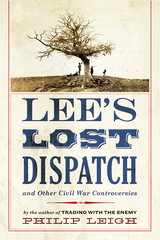 Lee's Lost Dispatch and Other Civil War Controversies
Philip Leigh
Westholme Publishing, 2015 A Lively Collection of Lesser-Known Civil War Stories Intended to Spark Debate About Our Received History of the War
Which over-arching decisions made by the Confederacy or Union had a greater effect on the course of the war than generally thought? Were there lauded command changes that may not have been as beneficial as presumed? How intertwined were the business aspirations on both sides of the conflict and what role did disinformation play in key battles? In Lee’s Lost Dispatch and Other Civil War Controversies, New York Times “Disunion” contributor Philip Leigh presents twelve stories from these turbulent times that afford a better understanding of how the war unfolded and how it was fought. The stories range from the Union’s delayed introduction of repeating arms and why a commercial steamer and not a warship was sent to relieve Fort Sumter to how Robert E. Lee’s critical dispatch at the battle of Antietam may have been lost and whether Southern poverty is the most protracted legacy of the war. Written to promote discussion and debate, this volume will intrigue those who enjoy Civil War history and contemplating alternatives to many assumed conclusions.
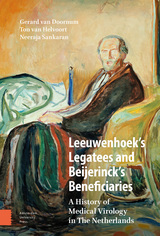 Leeuwenhoek's Legatees and Beijerinck's Beneficiaries: A History of Medical Virology in The Netherlands
Gerard van Doornum
Amsterdam University Press, 2020 Leeuwenhoek’s Legatees and Beijerinck’s Beneficiaries: A History of Medical Virology in The Netherlands offers a tour of the history of Dutch medical virology. Beginning with the discovery of the first virus by Martinus Beijerinck in 1898, the authors investigate the reception and redefinition of his concept in medical circles and its implications for medical practice. The relatively slow progress of these areas in the first half of the twentieth century and their explosive growth in the wake of molecular techniques are examined. The surveillance and control of virus diseases in the field of public health is treated in depth, as are tumour virus research and the important Dutch contributions to technical developments instrumental in advancing virology worldwide. Particular attention is paid to oft forgotten virus research in the former Dutch colonies in the East and West Indies and Africa.
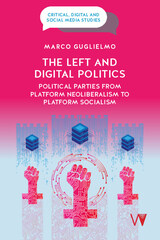 The Left and Digital Politics: Political Parties from Platform Neoliberalism to Platform Socialism
Marco Guglielmo
University of Westminster Press, 2025 Digital platforms are more than devices, algorithms and websites. They organise societies through the leadership of platform capitalists and their allies in political institutions. We know that this leadership, or hegemony, fosters exploitation and inequalities. We also know that a politics of resistance is emerging among platform workers and communities around the digital commons.Less known is how the left has been changing to have a say in digital politics. And what do left-wing parties think and do about platform societies? The Left and Digital Politics answers these questions by developing an updated Gramscian critical theory of (counter-)hegemony in platform societies and a comparative analysis of the ideologies and practices of key European left-wing parties.The book provides a map of left-wing ideas and practices on digital politics, a compass to point out how some left-wing parties perform as barriers or allies of radical change, and an analytical toolkit to open new routes towards platform socialism.
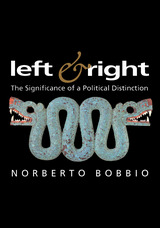 Left and Right: The Significance of a Political Distinction
Norberto Bobbio
University of Chicago Press, 1996 Politicians and pundits have long disparaged their opponents with polemicist cries of "leftist!" or "rightist!" But with the fall of communism and the recent conservative ascendancy in the United States and Europe, many commentators have flatly declared that the traditional left/right distinction has lost its relevance. Now, even as political players scramble to redefine themselves with freshly "spun" labels, Norberto Bobbio asserts that the demise of the left/right distinction has been greatly exaggerated.
Bobbio argues that left and right are not absolute terms, but represent a shifting map of the political spectrum, relative to the particular cultural and historical contexts of a given time. The distinction continues to endure because it reflects the essentially antithetical nature and dynamics of democratic politics. In his accessible yet provocative style, Bobbio constructs a historically informed, analytic division of the political universe along two foundational axes, from equality to inequality, from liberty to authoritarianism. He then charts the past and present tendencies of the left and the right, in both their more moderate and more virulently extreme forms. Ultimately, for Bobbio, the measure of post-modern democracy will indeed lie in where and how we situate ourselves relative to these critical left/right parameters, in whether we cast ourselves, our votes, and our era in terms of political expediency, social viability, or moral responsibility.
A bestseller in Italy, where it sold over three hundred thousand copies, Left and Right is an important contribution to our understanding of global political developments in the 1990s and beyond.
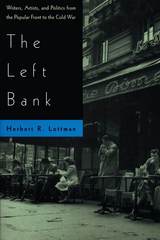 The Left Bank: Writers, Artists, and Politics from the Popular Front to the Cold War
Herbert Lottman
University of Chicago Press, 1998 This story begins in the Paris of the 1930s, when artists and writers stood at the center of the world stage. In the decade that saw the rise of the Nazis, much of the thinking world sought guidance from this extraordinary group of intellectuals. Herbert Lottman's chronicle follows the influential players—Gide, Malraux, Sartre, de Beauvoir, Koestler, Camus, and their pro-Fascist counterparts—through the German occupation, Liberation, and into the Cold War, when the struggle between superpowers all but drowned out their voices.
"Surprisingly fresh and intense. . . . A retrospective travelogue of the Left Bank in the days when it was the setting for almost all French intellectual activity. . . . Absorbing."—Naomi Bliven, New Yorker
"As an introduction to a period in French history already legendary, The Left Bank is superb."—Michael Dirda, Washington Post Book World
"An intellectual history. A history of the interaction between politics and letters. And a rumination on the limitless credulity of intellectuals."—Christopher Hitchens, New Statesman
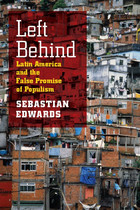 Left Behind: Latin America and the False Promise of Populism
Sebastian Edwards
University of Chicago Press, 2010 The political and economic history of Latin America has been marked by great hopes and even greater disappointments. Despite abundant resources—and a history of productivity and wealth—in recent decades the region has fallen further and further behind developed nations, surpassed even by other developing economies in Southeast Asia and elsewhere.
In Left Behind, Sebastian Edwards explains why the nations of Latin America have failed to share in the fruits of globalization and forcefully highlights the dangers of the recent turn to economic populism in the region. He begins by detailing the many ways Latin American governments have stifled economic development over the years through excessive regulation, currency manipulation, and thoroughgoing corruption. He then turns to the neoliberal reforms of the early 1990s, which called for the elimination of deficits, lowering of trade barriers, and privatization of inefficient public enterprises—and which, Edwards argues, held the promise of freeing Latin America from the burdens of the past. Flawed implementation, however, meant the promised gains of globalization were never felt by the mass of citizens, and growing frustration with stalled progress has led to a resurgence of populism throughout the region, exemplified by the economic policies of Venezuela’sHugo Chávez. But such measures, Edwards warns, are a recipe for disaster; instead, he argues, the way forward for Latin America lies in further market reforms, more honestly pursued and fairly implemented. As an example of the promise of that approach, Edwards points to Latin America's giant, Brazil, which under the successful administration of President Luis Inácio da Silva (Lula) has finally begun to show signs of reaching its true economic potential.
As the global financial crisis has reminded us, the risks posed by failing economies extend far beyond their national borders. Putting Latin America back on a path toward sustained growth is crucial not just for the region but for the world, and Left Behind offers a clear, concise blueprint for the way forward.
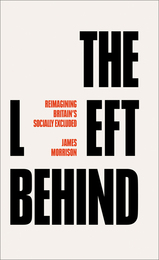 The Left Behind: Reimagining Britain's Socially Excluded
James
Pluto Press, 2022 Examines the ways in which the 'Left Behind' have been used to symbolize and foment social divisions in contemporary Britain.
'The Left Behind' is a defining motif of contemporary British political discourse. It is the thread that knits together the 2016 Brexit referendum, the crumbling of the fabled 'Red Wall' in the North, and the pernicious culture war being waged today. But who are the Left Behind? James Morrison goes in search of the reality behind the rhetoric, offering the first comprehensive, historical analysis of the origins, uses and meanings of the term. He interrogates the popular archetype of the Left Behind - as a working-class, Leave-voting white male from a former industrial heartland - and situates the concept in the context of longstanding, demonizing discourses aimed at communities seen as backward and 'undeserving'. Analyzing national newspaper coverage and parliamentary discussions, and drawing on interviews with MPs, community leaders, charities, and people with direct lived experiences of poverty and precarity, The Left Behind grapples with the real human cost of austerity for neglected post-industrial communities and other marginalized groups across the world, and the stigmatizing discourse that does little to serve them.
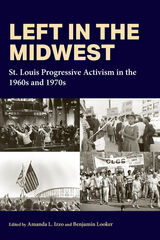 Left in the Midwest: St. Louis Progressive Activism in the 1960s and 1970s
Amanda L. Izzo
University of Missouri Press, 2023 Despite St. Louis’s mid-twentieth-century reputation as a conservative and sleepy midwestern metropolis, the city and its surrounding region have long played host to dynamic forms of social-movement organizing. This was especially the case during the 1960s and 1970s, when a new generation of local activists lent their energies to the ongoing struggles for Black freedom, lesbian and gay liberation, feminist social transformations, environmental protection, an end to the Vietnam War, and more. This volume, the first of its kind, offers fifteen scholarly contributions that together bring into focus the exceptional range of progressive activist projects that took shape in a single midwestern city during these tumultuous decades.
In contrast to scholarship that seeks to interpret the era’s social-movement initiatives in a primarily national context, the works presented in this expansive collection emphasize the importance of locality, neighborhood, community institutions, and rooted social networks. Documenting wrenching forces of metropolitan change as well as grassroots resilience, Left in the Midwest shows us how place powerfully shaped agendas, worldviews, and opportunities for the disparate groups that dedicated themselves to progressive visions for their city. By revising our sense of the region’s past, this volume also expands our sense of the possibilities that the future may hold for activist movements seeking change in St. Louis and beyond.
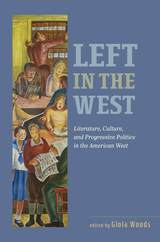 Left in the West: Literature, Culture, and Progressive Politics in the American West
Gioia Woods
University of Nevada Press, 2018 In this edited collection, Gioia Woods and her contributors bring together histories, biographies, close readings, and theories about the literary and cultural Left in the American West—as it is distinct from the more often-theorized literary left in major eastern metropolitan centers. Left in the West expands our understanding of what constitutes the literary left in the U.S. by including writers, artists, and movements not typically considered within the traditional context of the literary left. In doing so, it provides a new understanding of the region’s place among global and political ideologies.
From the early 19th century to the present, a remarkably complex and varied body of literary and cultural production has emerged out of progressive social movements. While the literary left in the West shared many interests with other regional expressions—labor, class, anti-fascism, and anti-imperialism, the influence of Manifest Destiny—the distinct history of settler colonialism in western territories caused western leftists to develop concerns unique to the region.
Chapters in the volume provide an impressive range of analysis, covering artists and movements from suffragist writers to bohemian Californian photographers, from civil rights activists to popular folk musicians, from Latinx memoirists to Native American experimental writers, to name just a few.
The unique consideration of the West as a socio-political region establishes a framework for political critique that moves beyond class consequences, anti-fascism, and civil liberties, and into distinct Western concerns such as Native American sovereignty, environmental exploitation, and the legacies of settler colonialism. What emerges is a deeper understanding of the region and its unique people, places, and concerns.
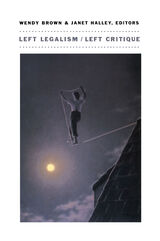 Left Legalism/Left Critique
Wendy Brown and Janet Halley, eds.
Duke University Press, 2002 In recent decades, left political projects in the United States have taken a strong legalistic turn. From affirmative action to protection against sexual harassment, from indigenous peoples’ rights to gay marriage, the struggle to eliminate subordination or exclusion and to achieve substantive equality has been waged through courts and legislation. At the same time, critiques of legalism have generally come to be regarded by liberal and left reformers as politically irrelevant at best, politically disunifying and disorienting at worst. This conjunction of a turn toward left legalism with a turn away from critique has hardened an intellectually defensive, brittle, and unreflective left sensibility at a moment when precisely the opposite is needed. Certainly, the left can engage strategically with the law, but if it does not also track the effects of this engagement—effects that often exceed or even redound against its explicit aims—it will unwittingly foster political institutions and doctrines strikingly at odds with its own values. Brown and Halley have assembled essays from diverse contributors—law professors, philosophers, political theorists, and literary critics—united chiefly by their willingness to think critically from the left about left legal projects. The essays themselves vary by topic, by theoretical approach, and by conclusion. While some contributors attempt to rework particular left legal projects, others insist upon abandoning or replacing those projects. Still others leave open the question of what is to be done as they devote their critical attention to understanding what we are doing. Above all, Left Legalism/Left Critique is a rare contemporary argument and model for the intellectually exhilarating and politically enriching dimensions of left critique—dimensions that persist even, and perhaps especially, when critique is unsure of the intellectual and political possibilities it may produce. Contributors: Lauren Berlant, Wendy Brown, Judith Butler, Drucilla Cornell, Richard T. Ford, Katherine M. Franke, Janet Halley, Mark Kelman, David Kennedy, Duncan Kennedy, Gillian Lester, Michael Warner
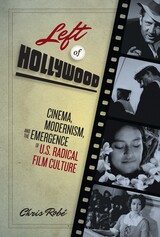 Left of Hollywood: Cinema, Modernism, and the Emergence of U.S. Radical Film Culture
By Chris Robé
University of Texas Press, 2010 In the 1930s as the capitalist system faltered, many in the United States turned to the political Left. Hollywood, so deeply embedded in capitalism, was not immune to this shift. Left of Hollywood offers the first book-length study of Depression-era Left film theory and criticism in the United States. Robé studies the development of this theory and criticism over the course of the 1930s, as artists and intellectuals formed alliances in order to establish an engaged political film movement that aspired toward a popular cinema of social change. Combining extensive archival research with careful close analysis of films, Robé explores the origins of this radical social formation of U.S. Left film culture. Grounding his arguments in the surrounding contexts and aesthetics of a few films in particular—Sergei Eisenstein's Que Viva Mexico!, Fritz Lang's Fury, William Dieterle's Juarez, and Jean Renoir's La Marseillaise—Robé focuses on how film theorists and critics sought to foster audiences who might push both film culture and larger social practices in more progressive directions. Turning at one point to anti-lynching films, Robé discusses how these movies united black and white film critics, forging an alliance of writers who championed not only critical spectatorship but also the public support of racial equality. Yet, despite a stated interest in forging more egalitarian social relations, gender bias was endemic in Left criticism of the era, and female-centered films were regularly discounted. Thus Robé provides an in-depth examination of this overlooked shortcoming of U.S. Left film criticism and theory.
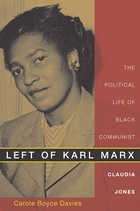 Left of Karl Marx: The Political Life of Black Communist Claudia Jones
Carole Boyce Davies
Duke University Press, 2007 In Left of Karl Marx, Carole Boyce Davies assesses the activism, writing, and legacy of Claudia Jones (1915–1964), a pioneering Afro-Caribbean radical intellectual, dedicated communist, and feminist. Jones is buried in London’s Highgate Cemetery, to the left of Karl Marx—a location that Boyce Davies finds fitting given how Jones expanded Marxism-Leninism to incorporate gender and race in her political critique and activism. Claudia Cumberbatch Jones was born in Trinidad. In 1924, she moved to New York, where she lived for the next thirty years. She was active in the Communist Party from her early twenties onward. A talented writer and speaker, she traveled throughout the United States lecturing and organizing. In the early 1950s, she wrote a well-known column, “Half the World,” for the Daily Worker. As the U.S. government intensified its efforts to prosecute communists, Jones was arrested several times. She served nearly a year in a U.S. prison before being deported and given asylum by Great Britain in 1955. There she founded The West Indian Gazette and Afro-Asian Caribbean News and the Caribbean Carnival, an annual London festival that continues today as the Notting Hill Carnival. Boyce Davies examines Jones’s thought and journalism, her political and community organizing, and poetry that the activist wrote while she was imprisoned. Looking at the contents of the FBI file on Jones, Boyce Davies contrasts Jones’s own narration of her life with the federal government’s. Left of Karl Marx establishes Jones as a significant figure within Caribbean intellectual traditions, black U.S. feminism, and the history of communism.
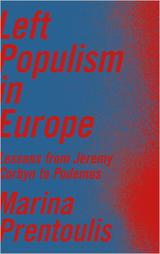 Left Populism in Europe: Lessons from Jeremy Corbyn to Podemos
Marina Prentoulis
Pluto Press, 2021 While the right is harnessing populist rhetoric to great effect, the left's attempts have been much less successful. The Syriza government in Greece and Jeremy Corbyn's Labour Party in Britain have both failed to change the neoliberal status quo and introduce democratic socialism in their countries. Other movements however, like the Spanish party Podemos, have seen greater gains and are now in government in Spain. In this book, Marina Prentoulis evaluates the transformational process of left populism across grassroots, national and European levels and asks what we can do to better harness the power of broad-based, popular left politics. Bringing a wealth of experience in political organizing, she argues that left populism is a political logic that brings together isolated demands against a common enemy with an egalitarian pluralism that could transform economic and political institutions in a radical democratic direction. But each party does this differently, and the key to understanding where to go from here lies in a serious analysis of the roots of each movement's base, the forms of party organization, and the particular national contexts. Avoiding reductive terms like 'pasokification', this is a clear and holistic approach to left populism that will inform anyone wanting to understand and move forward positively in a bleak time for the Left in Europe.
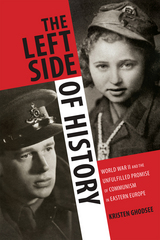 The Left Side of History: World War II and the Unfulfilled Promise of Communism in Eastern Europe
Kristen Ghodsee
Duke University Press, 2015 In The Left Side of History Kristen Ghodsee tells the stories of partisans fighting behind the lines in Nazi-allied Bulgaria during World War II: British officer Frank Thompson, brother of the great historian E.P. Thompson, and fourteen-year-old Elena Lagadinova, the youngest female member of the armed anti-fascist resistance. But these people were not merely anti-fascist; they were pro-communist, idealists moved by their socialist principles to fight and sometimes die for a cause they believed to be right. Victory brought forty years of communist dictatorship followed by unbridled capitalism after the fall of the Berlin Wall in 1989. Today in democratic Eastern Europe there is ever-increasing despair, disenchantment with the post-communist present, and growing nostalgia for the communist past. These phenomena are difficult to understand in the West, where “communism” is a dirty word that is quickly equated with Stalin and Soviet labor camps. By starting with the stories of people like Thompson and Lagadinova, Ghodsee provides a more nuanced understanding of how communist ideals could inspire ordinary people to make extraordinary sacrifices.
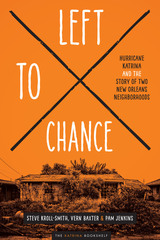 Left to Chance: Hurricane Katrina and the Story of Two New Orleans Neighborhoods
By Steve Kroll-Smith, Vern Baxter, and Pam Jenkins
University of Texas Press, 2015 How do survivors recover from the worst urban flood in American history, a disaster that destroyed nearly the entire physical landscape of a city, as well as the mental and emotional maps that people use to navigate their everyday lives? This question has haunted the survivors of Hurricane Katrina and informed the response to the subsequent flooding of New Orleans across many years. Left to Chance takes us into two African American neighborhoods—working-class Hollygrove and middle-class Pontchartrain Park—to learn how their residents have experienced “Miss Katrina” and the long road back to normal life. The authors spent several years gathering firsthand accounts of the flooding, the rushed evacuations that turned into weeks- and months-long exile, and the often confusing and exhausting process of rebuilding damaged homes in a city whose local government had all but failed. As the residents’ stories make vividly clear, government and social science concepts such as “disaster management,” “restoring normality,” and “recovery” have little meaning for people whose worlds were washed away in the flood. For the neighbors in Hollygrove and Pontchartrain Park, life in the aftermath of Katrina has been a passage from all that was familiar and routine to an ominous world filled with raw existential uncertainty. Recovery and rebuilding become processes imbued with mysteries, accidental encounters, and hasty adaptations, while victories and defeats are left to chance.
 Left Turns in Brown Study
Sandra Ruiz
Duke University Press, 2024 In Left Turns in Brown Study Sandra Ruiz offers a poetic-theoretical inquiry into the interlacing forms of study and mourning. Drawing on Black and Brown activism and theory, Ruiz interweaves poetry, memoir, lyrical essay, and vignettes to examine study as an emancipatory practice. Proposing “brown study” as key for understanding how Brownness harbors loss and suffering along with the possibility for more abundant ways of living, Ruiz invites readers to turn left into the sounds, phrases, and principles of anticolonial ways of reading, writing, citing, and listening. In doing so, Ruiz engages with a panoply of hauntings, ghosts, and spectral presences, from deceased teachers, illiterate ancestors, and those lost to unnatural disasters to all those victims of institutional and colonial violence. Study is shared movement and Brownness lives in citation. Conceptual, poetic, and unconventional, this book is crucial for all those who theorize minoritarian literary aesthetics and think through utopia, queer possibility, and the entwinement of forms.
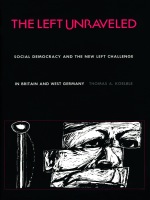 The Left Unraveled: Social Democracy & the New Left Challenge in Britain & West Germany
Thomas A. Koelble
Duke University Press, 1991 In the early 1980s both the British Labour Party and the West German Social Democrats (SPD), confronted with serious internal challenges from the political left, experienced an erosion of support that resulted in the emergence of new political parties—the British Social Democratic Party and the West German Green Party. Explicitly comparative, this study presents a theoretically innovative analysis while offering a sophisticated understanding of the political confrontations between social democrats, the new left, traditional socialists, and trade unionists in both Britain and West Germany.
By focusing on the established parties rather than on external developments, Koelble departs from conventional methodology regarding the fortunes of political parties. In examining the fundamental processes of decision making and coalition building within the SPD and the Labour Party, he argues that it is the organizational structures within parties that shape political results by setting limits, creating opportunities, and determining strategies.
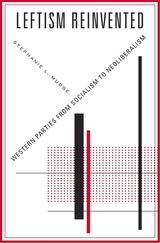 Leftism Reinvented: Western Parties from Socialism to Neoliberalism
Stephanie L. Mudge
Harvard University Press, 2018 Left-leaning political parties play an important role as representatives of the poor and disempowered. They once did so by promising protections from the forces of capital and the market’s tendencies to produce inequality. But in the 1990s they gave up on protection, asking voters to adapt to a market-driven world. Meanwhile, new, extreme parties began to promise economic protections of their own—albeit in an angry, anti-immigrant tone.
To better understand today’s strange new political world, Stephanie L. Mudge’s Leftism Reinvented analyzes the history of the Swedish and German Social Democrats, the British Labour Party, and the American Democratic Party. Breaking with an assumption that parties simply respond to forces beyond their control, Mudge argues that left parties’ changing promises expressed the worldviews of different kinds of experts. To understand how left parties speak, we have to understand the people who speak for them.
Leftism Reinvented shows how Keynesian economists came to speak for left parties by the early 1960s. These economists saw their task in terms of discretionary, politically-sensitive economic management. But in the 1980s a new kind of economist, who viewed the advancement of markets as left parties’ main task, came to the fore. Meanwhile, as voters’ loyalties to left parties waned, professional strategists were called upon to “spin” party messages. Ultimately, left parties undermined themselves, leaving a representative vacuum in their wake. Leftism Reinvented raises new questions about the roles and responsibilities of left parties—and their experts—in politics today.
 A Leftist Ontology: Beyond Relativism and Identity Politics
Carsten Strathausen
University of Minnesota Press, 2009 A new ontology for a globalized world Rich with analyses of concepts from deconstruction, systems theory, and post-Marxism, with critiques of fundamentalist thought and the war on terror, this volume argues for developing a philosophy of being in order to overcome the quandary of postmodern relativism. Undergirding the contributions are the premises that ontology is a vital concept for philosophy today, that an acceptable leftist ontology must avoid the kind of identity politics that has dominated recent cultural studies, and that a new ontology must be situated within global capitalism. A Leftist Ontology offers a timely intervention in political philosophy, featuring some of the leading voices of our time.Contributors: Bruno Bosteels, Cornell U; Christopher Breu, Illinois State U; Nicholas Brown, U of Illinois at Chicago; Sorin Radu Cucu, Manhattan College; George Edmondson, Dartmouth College; Eva Geulen, U of Bonn; Philip Goldstein, U of Delaware; Klaus Mladek, Dartmouth College; Alberto Moreiras, U of Aberdeen; Jeffrey T. Nealon, Pennsylvania State U; William Rasch, Indiana U; Ben Robinson, Indiana U; Imre Szeman, McMaster U; Roland Vegso, U of Tennessee, Knoxville.
Leftist Theories of Sport: A Critique and Reconstruction
William J. Morgan
University of Illinois Press, 1994 The degradation of modern sport--its commercialization, trivialization, widespread cheating, cult of athletic stars and celebrities, and manipulation by the media--has led to calls for its transformation. William J. Morgan constructs a critical theory of sport that shores up the weak arguments of past attempts and points a way forward to making sport more humane, compelling, and substantive. Drawing on the work of social theorists, Morgan challenges scholars and fans alike to explore new spaces in sport culture and imagine the rich cultural and political possibilities to be found in the pastimes we follow with such passion.
The Left's Dirty Job: The Politics of Industrial Restructuring in France and Spain
W. Rand Smith
University of Pittsburgh Press, 1998 The Left’s Dirty Job compares the experiences of recent socialist governments in France and Spain, examining how the governments of François Mitterrand (1981–1995) and Felipe González (1982–1996) provide a key test of whether a leftist approach to industrial restructuring is possible. This study argues that, in fact, both governments’ policies generally resembled those of other European governments in their emphasis on market-adapting measures that eliminated thousands of jobs while providing income support for displaced workers. Featuring extensive field work and interviews with over one hundred political, labor, and business leaders, this study is the first systematic comparison of these important socialist governments.
 Legacies and Latitude in European Health Policy, Volume 30
Adam Oliver, Elias Mossialos, and David Wilsford, eds.
Duke University Press This special double issue of the Journal of Health Politics, Policy and Law is a collection of papers presented at meetings held by the European Health Care Systems Discussion group--a forum for health system scholars from throughout Europe who meet regularly to discuss intra- and intercountry analyses of health care system reform. Reaching beyond simple descriptive reporting on the health care system of their particular country, contributors from across Europe develop a much deeper understanding of health sector reforms by placing emphasis on how the health care system of their country promotes--and has been reformed to promote--efficiency, equity, accountability and responsiveness within the specific political, historical, and cultural contexts of their countries (including Denmark, England, Finland, France, Germany, Greece, Italy, the Netherlands, Portugal, Spain, and Sweden).
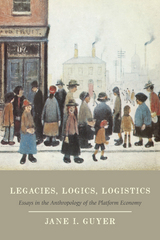 Legacies, Logics, Logistics: Essays in the Anthropology of the Platform Economy
Jane I. Guyer
University of Chicago Press, 2016 Legacies, Logics, Logistics brings together a set of essays, written both before and after the financial crisis of 2007–08, by eminent Africanist and economic anthropologist Jane I. Guyer. Each was written initially for a conference on a defined theme. When they are brought together and interpreted as a whole by Guyer, these varied essays show how an anthropological and socio-historical approach to economic practices—both in the West and elsewhere—can illuminate deep facets of economic life that the big theories and models may fail to capture.
Focusing on economic actors—whether ordinary consumers or financial experts—Guyer traces how people and institutions hold together past experiences (legacies), imagined scenarios and models (logics), and situational challenges (logistics) in a way that makes the performance of economic life (on platforms made of these legacies, logics, and logistics) work in practice. Individual essays explore a number of topics—including time frames and the future, the use of percentages in observations and judgments, the explanation of prices, the coexistence of different world currencies, the reapplication of longtime economic theories in new settings, and, crucially, how we talk about the economy, how we use stable terms to describe a turbulent system. Valuable as standalone pieces, the essays build into a cogent method of economic anthropology.
 Legacies of Anti-Semitism in France
Jeffrey Mehlman
University of Minnesota Press, 1983 Legacies of Anti-Semitism in France was first published in 1983. Minnesota Archive Editions uses digital technology to make long-unavailable books once again accessible, and are published unaltered from the original University of Minnesota Press editions. These four essays—on Blanchot, Lacan, Giraudoux, and Gide—have as their focus the barely imaginable coherence which the writings of four major contemporaries take on when read in the light of France's pre-World War II heritage of anti-Jewish thought. As the essays delve into such crucial topics as the inaugural silence in Blanchot's sense of literature, the "style" of Lacan, Giraudoux's relation to Racine, and the sexual politics of Gide, they engage a realm that at times seems—or seemed—anti-Semitic in its essence. Negotiating the complex ramifications of a lost tradition and the structure of its obliteration, Jeffrey Mehlman, in his conclusion, speculates on the emblematic value of Walter Benjamin's perpetually deferred "journey to Palestine via France" and its import for textual interpretation. A French version of Mehlman's essay on Blanchot, published in Tel quel,spurred an impassioned journalistic debate in Paris and London. Broadening still further the context of that inquiry, Legacies will prove a source of provocation and insight to all who are interested in the intellectual history of contemporary France.
 Legacies of Childhood: Growing up Chinese in a Time of Crisis
John L. Saari
Harvard University Press, 1990 Jon L. Saari defines the generation of educated Chinese born around the turn of the century as "the last to have the world of Confucian learning etched into their memories as schoolboys, yet the first as a group to confront the intrusive Western world." The legacies of growing up in a changing environment deeply affected this generation's responses to the further changes in the world they confronted as adults. In the collapse of the Ch'ing dynasty and the chaos of the early twentieth century, traditional ideas of the self, the nature of relationships in society, and ethical behavior had to be reexamined and redefined. To reconstruct what those who lived through and shaped this extraordinary period felt, needed, thought, and became as children and adults, Saari draws on autobiographical writings and his own interviews among the elderly on Taiwan and Hong Kong. He interprets this material within its Chinese context but brings Western sociological, anthropological, and psychological insights to bear on it.
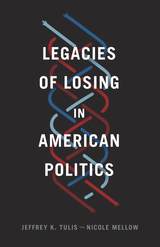 Legacies of Losing in American Politics
Jeffrey K. Tulis and Nicole Mellow
University of Chicago Press, 2017 American politics is typically a story about winners. The fading away of defeated politicians and political movements is a feature of American politics that ensures political stability and a peaceful transition of power. But American history has also been built on defeated candidates, failed presidents, and social movements that at pivotal moments did not dissipate as expected but instead persisted and eventually achieved success for the loser’s ideas and preferred policies.
With Legacies of Losing in American Politics, Jeffrey K. Tulis and Nicole Mellow rethink three pivotal moments in American political history: the founding, when anti-Federalists failed to stop the ratification of the Constitution; the aftermath of the Civil War, when President Andrew Johnson’s plan for restoring the South to the Union was defeated; and the 1964 presidential campaign, when Barry Goldwater’s challenge to the New Deal order was soundly defeated by Lyndon B. Johnson. In each of these cases, the very mechanisms that caused the initial failures facilitated their eventual success. After the dust of the immediate political defeat settled, these seemingly discredited ideas and programs disrupted political convention by prevailing, often subverting, and occasionally enhancing constitutional fidelity. Tulis and Mellow present a nuanced story of winning and losing and offer a new understanding of American political development as the interweaving of opposing ideas.
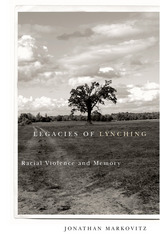 Legacies Of Lynching: Racial Violence And Memory
Jonathan Markovitz
University of Minnesota Press, 2004 Traces the changing meanings of lynching and examines the political power of lynching as metaphor Between 1880 and 1930, thousands of African Americans were lynched in the United States. Beyond the horrific violence inflicted on these individuals, lynching terrorized whole communities and became a defining characteristic of Southern race relations in the Jim Crow era. As spectacle, lynching was intended to serve as a symbol of white supremacy. Yet, Jonathan Markovitz notes, the act's symbolic power has endured long after the practice of lynching has largely faded away. Legacies of Lynching examines the evolution of lynching as a symbol of racial hatred and a metaphor for race relations in popular culture, art, literature, and political speech. Markovitz credits the efforts of the antilynching movement with helping to ensure that lynching would be understood not as a method of punishment for black rapists but as a terrorist practice that provided stark evidence of the brutality of Southern racism and as America’s most vivid symbol of racial oppression. Cinematic representations of lynching, from Birth of a Nation to Do the Right Thing, he contends, further transform the ways that American audiences remember and understand lynching, as have disturbing recent cases in which alleged or actual acts of racial violence reconfigured stereotypes of black criminality. Markovitz further reveals how lynching imagery has been politicized in contemporary society with the example of Clarence Thomas, who condemned the Senate's investigation into allegations of sexual harassment during his Supreme Court confirmation hearings as a “high-tech lynching.”Even today, as revealed by the 1998 dragging death of James Byrd in Jasper, Texas, and the national soul-searching it precipitated, lynching continues to pervade America's collective memory. Markovitz concludes with an analysis of debates about a recent exhibition of photographs of lynchings, suggesting again how lynching as metaphor remains always in the background of our national discussions of race and racial relations.
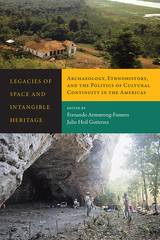 Legacies of Space and Intangible Heritage: Archaeology, Ethnohistory, and the Politics of Cultural Continuity in the Americas
Fernando Armstrong-Fumero
University Press of Colorado, 2017 Legacies of Space and Intangible Heritage is an interdisciplinary exploration of the intersections between the study and management of physical sites and the reproduction of intangible cultural legacies. The volume provides nine case studies that explore different ways in which place is mediated by social, political, and ecological processes that have deep historical roots and that continue to affect the politics of heritage management. Spaces of human habitation are both historical records of the past and key elements in reproducing the knowledge and values that define lives in the present. Practices, knowledge, and skills that communities recognize as part of their culture—and that a range of legal statutes define as protected intangible heritages—are threatened by increased migration, the displacement of indigenous peoples, and limits on access to culturally or historically significant sites. This volume addresses how different physical environments contribute to the reproduction of cultural forms even in the wake of these processes of displacement and change. Case studies from North and South America reveal a pattern of abandonment and reestablishment of settlements and show how collective memory drives people back to culturally meaningful sites. This tendency for communities to return to the sites that shaped their collective histories, along with the growing importance granted to intangible heritage, challenges archaeologists and other heritage workers to find new ways of incorporating the cultural legacies that link societies to place into the work of research and stewardship. By examining the politics of cultural continuity through the lenses of archaeology and ethnohistory, Legacies of Space and Intangible Heritage demonstrates this complex relationship between a people’s heritage and the landscape that affects the making of "place." Contributors: Rani Alexander, Hannah Becker, Minette Church, Bonnie Clark, Chip Colwell, Winifred Creamer, Emiliana Cruz, T. J. Ferguson, Julio Hoil Gutierrez, Jonathan Haas, Saul Hedquist, Maren Hopkins, Stuart B. Koyiyumptewa, Christine Kray, Henry Marcelo Castillo, Anna Roosevelt, Jason Yaeger, Keiko Yoneda
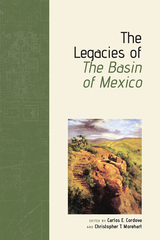 The Legacies of The Basin of Mexico
Carlos E. Cordova
University Press of Colorado, 2023 This volume celebrates the continuing impact of the most notable contributions from The Basin of Mexico: The Ecological Processes in the Evolution of a Civilization by William T. Sanders, Jeffrey R. Parsons, and Robert S. Santley. In 1979, this influential work synthesized the results of the Basin of Mexico survey projects and follow-up excavations at several sites, while providing theoretical and methodological lines of research in central Mexico and generally in Mesoamerica.
More than four decades after that book’s publication, the fourteen contributions in this volume review and analyze its theoretical and methodological influence in light of recent research across disciplines. Among a spectrum of authors representing several generations are those who participated directly in the Basin of Mexico surveys—including the late Jeffrey R. Parsons—as well as those who have been actively working on recent projects in the basin and neighboring regions.
Providing a broad and multidisciplinary perspective of the present and future state of research in the area, The Legacies of The Basin of Mexico will be of interest to Mesoamerican and Latin American archaeologists as well as geographers, geologists, historians, and specialists in the study of past environments.
Contributors: Guillermo Acosta Ochoa, Aleksander Borejsza, Destiny Crider, Charles Frederick, Raúl García-Chávez, Larry Gorenflo, Angela Huster, Georgina Ibarra Arzave, Charles Kolb, Frank Lehmkuhl, Abigail Meza Peñaloza, Emily McClung de Tapia, John K. Millhauser, Deborah Nichols, Jeffrey R. Parsons, Serafin Sánchez Pérez, Philipp Schulte, Sergey Sedov, Elizabeth Solleiro Rebolledo, Daisy Valera Fenández, Federico Zertuche
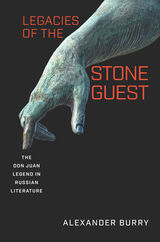 Legacies of the Stone Guest: The Don Juan Legend in Russian Literature
Alexander Burry
University of Wisconsin Press, 2023 The story of Don Juan first appeared in writing in seventeenth-century Spain, reaching Russia about a century later. Its real impact, however, was delayed until Russia’s most famous poet, Alexander Pushkin, put his own, unique, and uniquely inspirational, spin on the tale. Published in 1830, TheStone Guest is now recognized, with other Pushkin masterpieces, as part of the Russian literary canon. Alexander Burry traces the influence of Pushkin’s brilliant innovations to the legend, which he shows have proven repeatedly fruitful through successive ages of Russian literature, from the Realist to the Silver Age, Soviet, and contemporary periods. Burry shows that, rather than creating a simple retelling of an originally religious tale about a sinful, consummate seducer, Pushkin offered open-ended scenes, re-envisioned and complicated characters, and new motifs that became recursive and productive parts of Russian literature, in ways that even Pushkin himself could never have predicted.
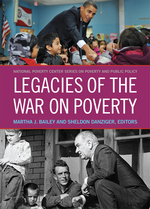 Legacies of the War on Poverty
Martha J. Bailey
Russell Sage Foundation, 2013 Many believe that the War on Poverty, launched by President Johnson in 1964, ended in failure. In 2010, the official poverty rate was 15 percent, almost as high as when the War on Poverty was declared. Historical and contemporary accounts often portray the War on Poverty as a costly experiment that created doubts about the ability of public policies to address complex social problems. Legacies of the War on Poverty, drawing from fifty years of empirical evidence, documents that this popular view is too negative. The volume offers a balanced assessment of the War on Poverty that highlights some remarkable policy successes and promises to shift the national conversation on poverty in America. Featuring contributions from leading poverty researchers, Legacies of the War on Poverty demonstrates that poverty and racial discrimination would likely have been much greater today if the War on Poverty had not been launched. Chloe Gibbs, Jens Ludwig, and Douglas Miller dispel the notion that the Head Start education program does not work. While its impact on children’s test scores fade, the program contributes to participants’ long-term educational achievement and, importantly, their earnings growth later in life. Elizabeth Cascio and Sarah Reber show that Title I legislation reduced the school funding gap between poorer and richer states and prompted Southern school districts to desegregate, increasing educational opportunity for African Americans. The volume also examines the significant consequences of income support, housing, and health care programs. Jane Waldfogel shows that without the era’s expansion of food stamps and other nutrition programs, the child poverty rate in 2010 would have been three percentage points higher. Kathleen McGarry examines the policies that contributed to a great success of the War on Poverty: the rapid decline in elderly poverty, which fell from 35 percent in 1959 to below 10 percent in 2010. Barbara Wolfe concludes that Medicaid and Community Health Centers contributed to large reductions in infant mortality and increased life expectancy. Katherine Swartz finds that Medicare and Medicaid increased access to health care among the elderly and reduced the risk that they could not afford care or that obtaining it would bankrupt them and their families. Legacies of the War on Poverty demonstrates that well-designed government programs can reduce poverty, racial discrimination, and material hardships. This insightful volume refutes pessimism about the effects of social policies and provides new lessons about what more can be done to improve the lives of the poor.
 Legacies of War: Enduring Memories, Persistent Patterns
Jennifer Leaning
Harvard University Press Wars always harm civilians. How wars are waged—with what means and methods, and with what underlying animus—has great impact on civilian suffering and social memory. Across time frames and cultures, this book examines the various distinct features of anti- and post-colonial wars, the two World Wars, and recent wars of the 21st century in terms of their disruption of everyday life and their enduring distortion of social ecosystems. With a lens trained on how civilians and soldiers remember the experience of armed conflict, Legacies of War challenges narrow conceptions of the cost of war.
Jennifer Leaning, a humanitarian and human rights analyst, draws on her diverse experience to describe both the long- and short-term consequences of wars waged in the midst of—or even against—civilian populations. The book illuminates a breakdown of distinction between home front and battlefront and the resulting erosion of civilian protection with the rise of intrastate war and policies of war-at-a-distance. Enlisting seasoned contributors for a wide-ranging set of essays, the book identifies significant trends in the conduct of war, and traces how these trends are later rendered in individual and social rituals of interpretation, commemoration, expiation, or avoidance.
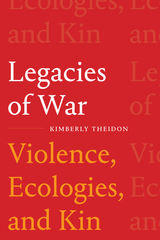 Legacies of War: Violence, Ecologies, and Kin
Kimberly Theidon
Duke University Press, 2022 In Legacies of War Kimberly Theidon examines the lives of children born of wartime rape and the experiences of their mothers and communities to offer a gendered theory of harm and repair. Drawing on ethnographic research in postconflict Peru and Colombia, Theidon considers the multiple environments in which conception, pregnancy, and childbirth unfold. She reimagines harm by taking into account the impact of violence on individual people as well as on more-than-human lives, bodies, and ecologies, showing how wartime violence reveals the interdependency of all life. She also critiques policy makers, governments, and humanitarian organizations for their efforts at postconflict justice, which frequently take an anthropocentric rights-based approach that is steeped in liberal legalism. Rethinking the intergenerational reach of war while questioning what counts as sexual and reproductive violence, Theidon calls for an explicitly feminist peace-building and postconflict agenda that includes a full range of sexual and reproductive rights, including access to safe and affordable abortions.
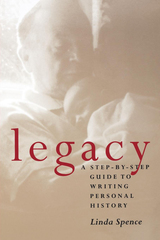 Legacy: A Step-By-Step Guide To Writing Personal History
Linda Spence
Ohio University Press, 1997 When Linda Spence asked her aging mother to write her life story, her mother stared at a blank sheet of paper and asked—“How? Where do I begin?” In this practical guide to capturing those memories that have been stored away, Linda Spence provides the questions that are the keys to unlocking the memories that make up a life. Beyond the vital statistics are the personal stories that tell what it was like, what we did, and why we did it, how we feel about our choices, and what our circumstances were. Through encouraging coaching, shared memories, and open-ended questions, the process of producing a personal history becomes intriguing and engaging. With Legacy the possibilities expand: a personal record is preserved—with its myths, traditions, joys, pains, gains, and losses; a family opens a potential dialogue that will last for generations; the writer has an opportunity for insight and resolution; the culture of a time and place is noted; the tradition of personal story is revitalized, and our present and future find nourishment and knowledge in the past. Either as a gift that can act as a shared experience as the memories are recounted or as a personal way to take account of one’s experiences, often long since forgotten, Legacy is indeed a way to get one’s story down.
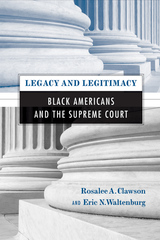 Legacy and Legitimacy: Black Americans and the Supreme Court
Rosalee A. Clawson and Eric N. Waltenburg
Temple University Press, 2008 Thoroughly grounded in the latest scholarly literature, theoretical sources, and experimental results, Legacy and Legitimacy substantially advances understanding of Black Americans’ attitudes toward the Supreme Court, the Court’s ability to influence Blacks’ opinions about the legitimacy of public institutions and policies, and the role of media in shaping Blacks’ judgments. Drawing on legitimacy theory—which explains the acceptance of or tolerance for controversial policies—the authors begin by reexamining the significance of “diffuse support” in establishing legitimacy. They provide a useful overview of the literature on legitimacy and a concise history of the special relationship between Blacks and the Court. They investigate the influences of group attitudes and media “framing.” And they employ data from large-scale surveys to show that Blacks with greater levels of diffuse support for the Court are more likely to adopt positions consistent with Court rulings. With its broad scope and inclusion of new experimental findings, Legacy and Legitimacy will interest students and scholars of judicial politics, racial politics, media and politics, black studies and public opinion.
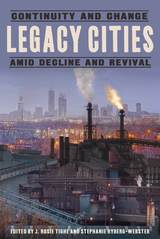 Legacy Cities: Continuity and Change amid Decline and Revival
J. Rosie Tighe
University of Pittsburgh Press, 2019 Legacy cities, also commonly referred to as shrinking, or post-industrial cities, are places that have experienced sustained population loss and economic contraction. In the United States, legacy cities are those that are largely within the Rust Belt that thrived during the first half of the 20th century. In the second half of the century, these cities declined in economic power and population leaving a legacy of housing stock, warehouse districts, and infrastructure that is ripe for revitalization. This volume explores not only the commonalities across legacy cities in terms of industrial heritage and population decline, but also their differences. Legacy Cities poses the questions: What are the legacies of legacy cities? How do these legacies drive contemporary urban policy, planning and decision-making? And, what are the prospects for the future of these cities? Contributors primarily focus on Cleveland, Ohio, but all Rust Belt cities are discussed.
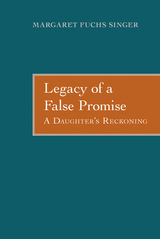 Legacy of a False Promise: A Daughter's Reckoning
Margaret Fuchs Singer
University of Alabama Press, 2009 The compelling story of a teenage girl caught up in the throes of the McCarthy era.
Margaret Fuchs was thirteen in June 1955 when she learned that her parents had been Communists while working for the U.S. government in the 1930s and '40s. This book chronicles the years during which her parents were exposed and her father was subpoenaed before the House Un-American Activities Committee. Eventually he named names, and subsequently lost his job as a law professor at American University, and was blacklisted from teaching ever again. Legacy of a False Promise also details the author's quest as an adult to learn whether or not her parents ever spied for the Soviet Union.
Based on eight years of research using family records, FBI files, American University archives, personal interviews, and the recently declassified Venona cables, Legacy of a False Promise offers unique insights into the McCarthy Era. Most "red-diaper babies" who have written on the subject had parents who refused to give in to HUAC's demands. Singer's work instead recounts the shame and series of betrayals that her father's decision to name names brought to her family. Furthermore, it explores the campaign of the liberal anti-Communist movement to publicize its political position while defending a fired ex-Communist professor, the nature and activities of secret Communist underground cells, and the motivation of New Deal government workers who spied for the Soviets.
This is a poignant meditation on family secrets, father-daughter relationships in times of crisis, teenage loneliness in the midst of trauma, and the effects of parents' actions on the lives of their children. It also serves as a timely reminder of the dangers of sacrificing civil liberties in the name of national security.
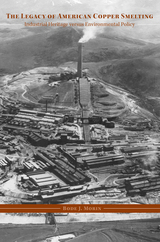 The Legacy of American Copper Smelting: Industrial Heritage versus Environmental Policy
Bode J. Morin
University of Tennessee Press, 2013
Throughout world history, copper has been a significant metal for a vast number of cultures, from the oldest civilizations on record to the Bronze Age and Greek and Roman antiquity. Though replaced by iron as the primary metal for tools and weapons in ancient civilizations, copper found new resurgence in the nineteenth century when it was discovered to have particularly high thermal and electrical conductivity. Copper mining quickly escalated into a large-scale industry, and because of its vast reserves and innovative mining techniques, the United States seized the reins of global production with the opening of significant copper mines in Tennessee and Michigan in the 1840s and Montana in the 1870s.
Copper-mining prosperity and America’s dominance of the industry came with a heavy environmental price, however. As rich copper deposits declined with increased mining efforts, large deposits of leaner ores—oftentimes less than one percent pure—had to be mined to keep pace with America’s technological thirst for copper. Processing such ore left an inordinate amount of industrial waste, such as tailings and slag deposits from the refining process and toxic materials from the ores themselves, and copper mining regions around the United States began to see firsthand the landscape degradation wrought by the industry.
In The Legacy of American Copper Smelting, Bode J. Morin examines America’s three premier copper sites: Michigan’s Keweenaw Peninsula, Tennessee’s Copper Basin, and Butte- Anaconda, Montana. Morin focuses on what the copper industry meant to the townspeople working in and around these three major sites while also exploring the smelters’ environmental effects. Each site dealt with pollution management differently, and each site had to balance an EPA-mandated cleanup effort alongside the preservation of a once-proud industry.
Morin’s work sheds new light on the EPA’s efforts to utilize Superfund dollars and/or protocols to erase the environmental consequences of copper-smelting while locals and preservationists tried to keep memories of the copper industry alive in what were dying or declining post-industrial towns. This book will appeal to anyone interested in the American history of copper or heritage preservation studies, as well as historians of modern America, industrial technology, and the environment.
 The Legacy of Black Women in Librarianship: When They Dared to Be Powerful
Edited by Nicole A. Cooke
American Library Association, 2025 Black women have historically been hidden figures in librarianship, yet their passion, courage, and tenacity paved the way for future generations of knowledge workers. Profiling more than a dozen librarians, book champions, activists, and pioneers of the profession from across the country, this powerful work of archival storytelling will inspire readers both inside and outside of the library field. These personal histories of advocacy and resilience - span the entire 20th Century, stretching from rural South Carolina and Florida to urban centers like New York and Los Angeles;
- profile better known figures such as Augusta Baker and Eliza Atkins Gleason as well as many who have yet to receive their due;
- grapple with the toxic legacy of segregation in library education, universities, public libraries, schools, and other institutions, showing how these persevering Black women dared to strive and work towards more equitable futures;
- include an inspiring Afterword by Dr. Aisha Johnson-Jones, an educator and revelator of Southern intellectual history;
- will encourage LIS students and newer librarians of all backgrounds to see themselves reflected in the profession’s long and rich heritage; and
- shed light on how librarianship can become ever more diverse and community centered.
|
|
